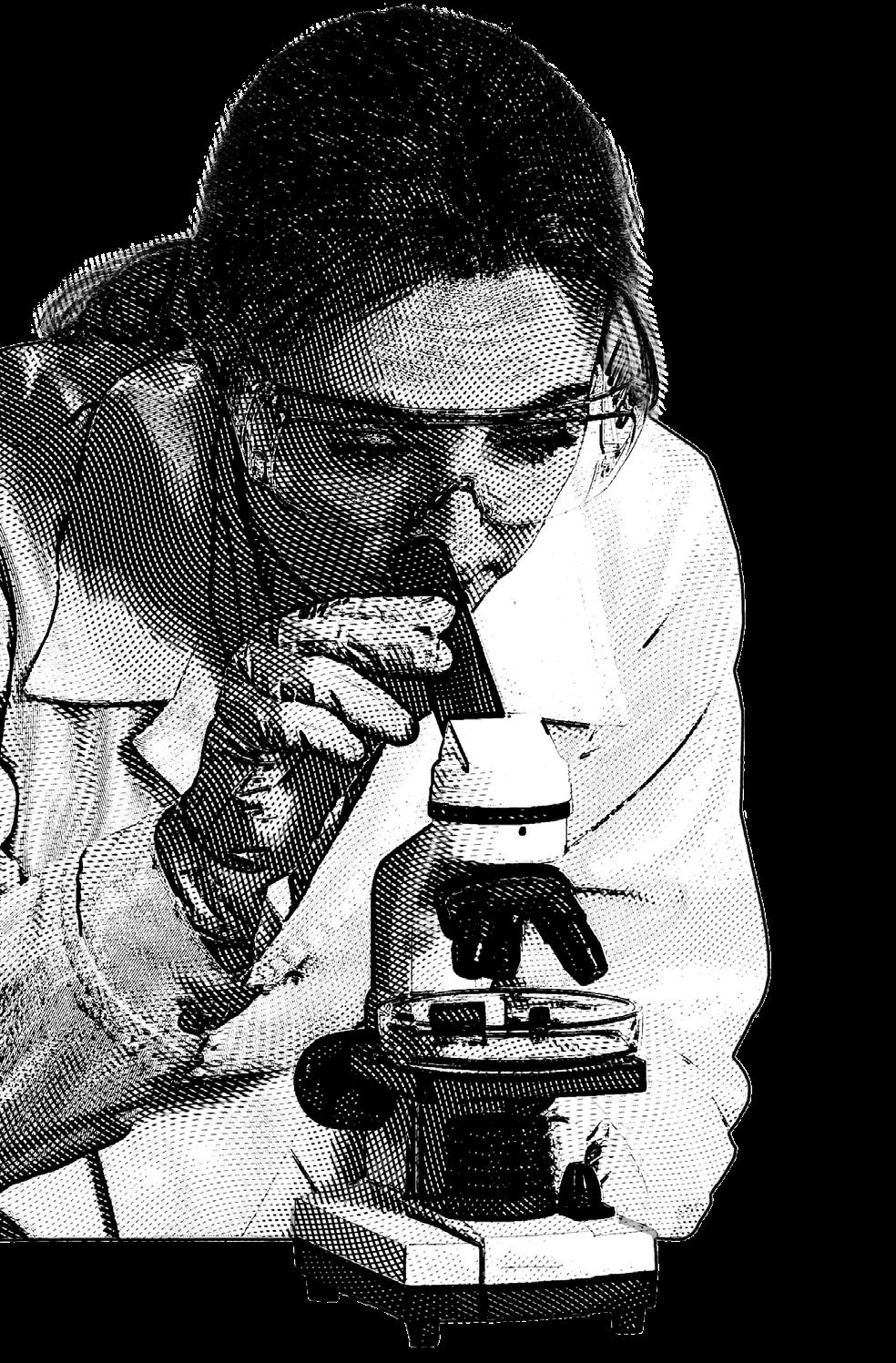

VACUOLE EXPLORATION
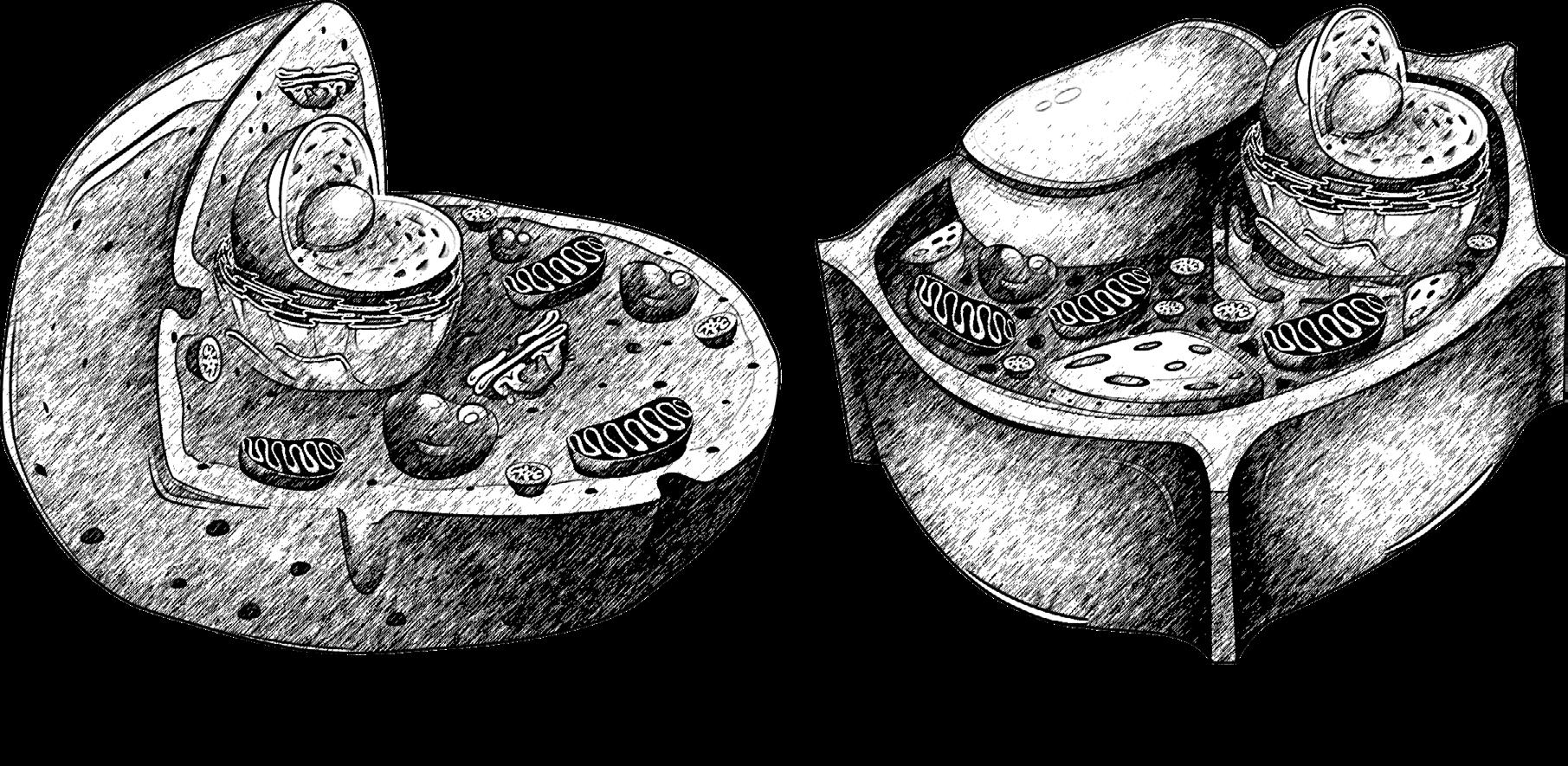
The SEB Magazine is published biannually — Spring and Autumn (online) — by the Society for Experimental Biology and is distributed to all SEB members.
Advertising
Advertising in the SEB magazine is a great opportunity to reach a large community of biologists. For more details contact b.danois@sebiology.org
Design and artwork: Robert Wood, Time Design Studio robertwood@timedesignstudio.co.uk
Contribute with an article! Interested in writing an article for the SEB magazine? Get in touch: b.danois@sebiology.org
Deadline for copy:
Issue: Spring 2024
Deadline: 1st August 2024
SEB Executive Team:
SEB Main Office
The Society for Experimental Biology County Main, A012/A013 Lancaster University, Bailrigg LA1 4YW, UK admin@sebiology.org
Chief Executive Officer
Pamela Mortimer (p.mortimer@sebiology.org)
Events Manager
Louise Tully (l.tully@sebiology.org)
Events and Grants Assistant
Keji Aofiyebi (k.aofiyebi@sebiology.org)
Events officer
Jennifer Symons (j.symons@sebiology.org)
Membership Manager
Jordy Turl (j.turl@sebiology.org)
Office Administrator
Julius Kelly (j.kelly@sebiology.org)
Education, Outreach and Diversity Manager
Dr Rebecca Ellerington (r.ellerington@sebiology.org)
Education, Outreach and Diversity
Ana Caroline Colombo (a.colombo@sebiology.org)
Communications Manager
Benjamin Danois (b.danois@sebiology.org)
SEB Honorary Officers:
President
Tracey Lawson (tlawson@essex.ac.uk)
Vice President
Gudrun De Boeck (gudrun.deboeck@uantwerpen.be)
Treasurer
John Love (J.Love@exeter.ac.uk)
Publications Officer
Diana Santelia (diana.santelia@usys.ethz.ch)
Plant Section Chair
Stefan Kepinski (S.Kepinski@leeds.ac.uk)
Cell Section Chair
Ross Sozzani (ross_sozzani@ncsu.edu)
Animal Section Chair
Felix Mark (Felix.Christopher.Mark@awi.de)
Outreach, Education and Diversity Trustee
Sheila Amici-Dargan (anzsld@bristol.ac.uk)
SEB Journal Editors:
Journal of Experimental Botany
John Lunn (Lunn@mpimp-golm.mpg.de)
The Plant Journal
Katherine Denby (katherine.denby@york.ac.uk)
Plant Biotechnology Journal
Henry Daniell (henry.daniell@ucf.edu)
Conservation Physiology
Steven Cooke (steven_cooke@carleton.ca)
Plant Direct
Dr. Larry York (yorklm@ornl.gov)
In association with ASPB
Disclaimer
The views expressed in this magazine are not necessarily those of the Editorial Board or the Society for Experimental Biology. The Society for Experimental Biology is a registered charity No. 273795
FEATURES SPOTLIGHT
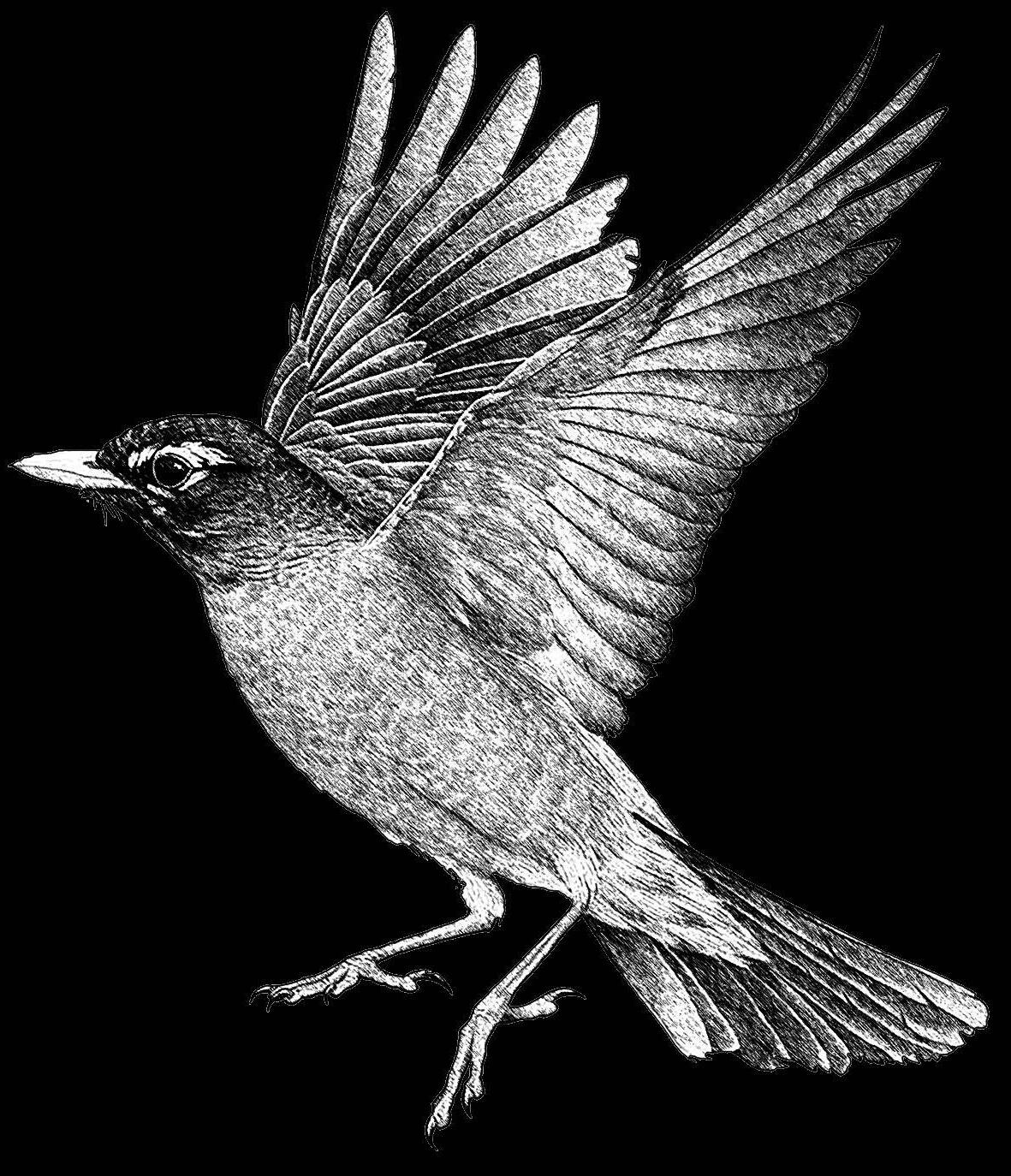
EXPLORING VACUOLES: UNVEILING CELLULAR COMPLEXITY
BY BENJAMIN DANOIS
In this issue of our cell-focused magazine, we delve deep into the intricate world of vacuoles, those often overlooked yet crucial membranebound organelles present in plants, fungi and certain animal cells. Vacuoles play multifaceted roles in cellular health, environmental adaptation and the evolutionary landscape of eukaryotic organisms.
FEATURES
In the following features, we explore the diverse perspectives and insights offered by our contributors:
In ‘Lysosomes Aren’t Just Destroyers’, Brittney Borowiec sheds light on the versatile functions of lysosomes within animal cells, highlighting their importance beyond mere degradation processes. (page 14)
Alex Evans takes us on a journey of discovery in ‘Learning the Ins and Outs of Vacuoles’, unravelling the mysteries surrounding these enigmatic cellular compartments and their diverse functions. (page 18)
Caroline Wood presents a captivating exploration of plant vacuoles, uncovering their dominance in cell volume and their indispensable roles in maintaining water balance, nutrient storage and intracellular digestion. (page 22)
MEMBERS HIGHLIGHTS
In this issue’s spotlight on our members, we proudly showcase the outstanding achievements of our community. Explore the remarkable work and contributions of our members, each a shining star in the SEB constellation. (page 10)
SPOTLIGHT
Join us in conversation with Ross Sozzani, our Cell Section Chair, and George Bassel, one of our Cell convenors, as they share their insights into and perspectives on current advancements in cell biology. (page 36 and 38)
We also shine a spotlight on the exemplary contributions of Amar Surapaneni and Susana Clusella-Trullas, whose dedication and passion have enriched the SEB community. (page 38)
OED (OUTREACH, EDUCATION AND DIVERSITY)
Start with our SEB Centenary infographic, which reflects the initiatives undertaken during the centennial year, commemorating a century of research and innovation within the SEB community. (page 48)

Rebecca Ellerington takes us on a journey across the globe with ‘SEB in the News’, showcasing the profound impact of SEB members’ scientific endeavours on a global scale.
Ana Colombo presents ‘Proactive Swimmer in the Science Sea’, a compelling narrative on navigating the currents of scientific research with resilience and determination. (page 50)
Rebecca then shares with us the significance of supporting bioscience researchers in higher education teaching through educational research grants. (page 51).
EVENT RECAP: CELL SYMPOSIUM: EPIPLANT/SEB 2024
The EPIPLANT/SEB 2024 event, held from September 10th to 13th, brought together 180 attendees. It was a resounding success, featuring cutting-edge research and discussions on epigenetics and plant biology.
For more details, visit: www. sebiology.org/events/epiplant-seb-2024. html
SEB CONFERENCE PRAGUE 2024
Join us in reliving the SEB Conference Prague 2024, where over 700 attendees gathered for a memorable exchange of scientific ideas and innovations. Explore our photo albums to see the highlights of this remarkable event.
Read more and see the pictures here : www.sebiology.org/resource/ seb-conference-prague-2024-aresounding-success.html

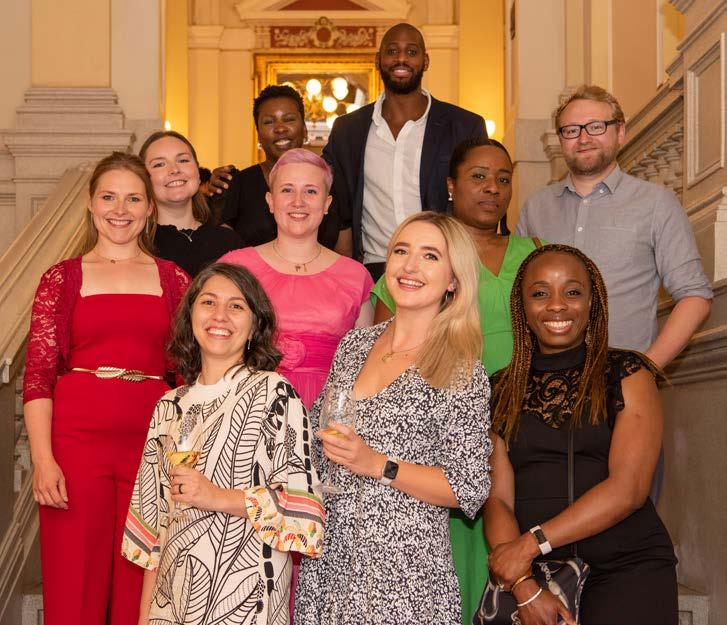
PRESIDENT’S LETTER
PROFESSOR TRACY LAWSON PRESIDENT, SOCIETY FOR EXPERIMENTAL BIOLOGY
IT IS WITH GREAT PLEASURE THAT I BEGIN THIS NEWSLETTER BY EXTENDING A WARM WELCOME TO TWO TRUSTEES WHO HAVE RECENTLY JOINED THE SEB COUNCIL.
This issue will focus on the cell, the building block of life, with an emphasis on vacuoles. As the smallest units of living organisms, cells provide the structural elements that make up tissues, organs and whole organisms. Vacuoles, the membrane-bound organelles that are a key feature in plants, fungi and certain animal cells, are involved in many important processes within the cell. These include roles in maintaining water balance, nutrient storage and growth. Cells and vacuoles are therefore integral to all of our research areas in all of our disciplines. You will discover a much more informed discussion about cell and vacuole function in the accompanying articles, as well as information on some of the up-and-coming events that cover these topics.
It is with great pleasure that I begin this newsletter by extending a warm welcome to two trustees who have recently joined the SEB Council. First, I am delighted to introduce Robyn Emmerson, who assumes the mantle of Early Career Researcher Trustee, succeeding Tommy Norin. Robyn is currently a Postdoctoral Fellow at the University of Birmingham, and is also a session lead for our upcoming Annual Conference, demonstrating her continued commitment to our Society. I would also like to formally welcome Ross Sozzani, our new Cell Section Chair. Ross, a distinguished faculty member at North Carolina State University, is renowned for her groundbreaking research elucidating the molecular mechanisms governing growth and development. Ross succeeds David Evans, whose exemplary leadership has been instrumental in shaping the trajectory of the Cell section over the past 4 years. I would like to take this opportunity to extend our appreciation to Tommy and David for their unwavering dedication and invaluable contributions. We recognise the profound impact they have had in propelling our Society forwards. As we embrace this new chapter, I am greatly looking forward to working with Robyn and Ross and the vision they bring to the council.
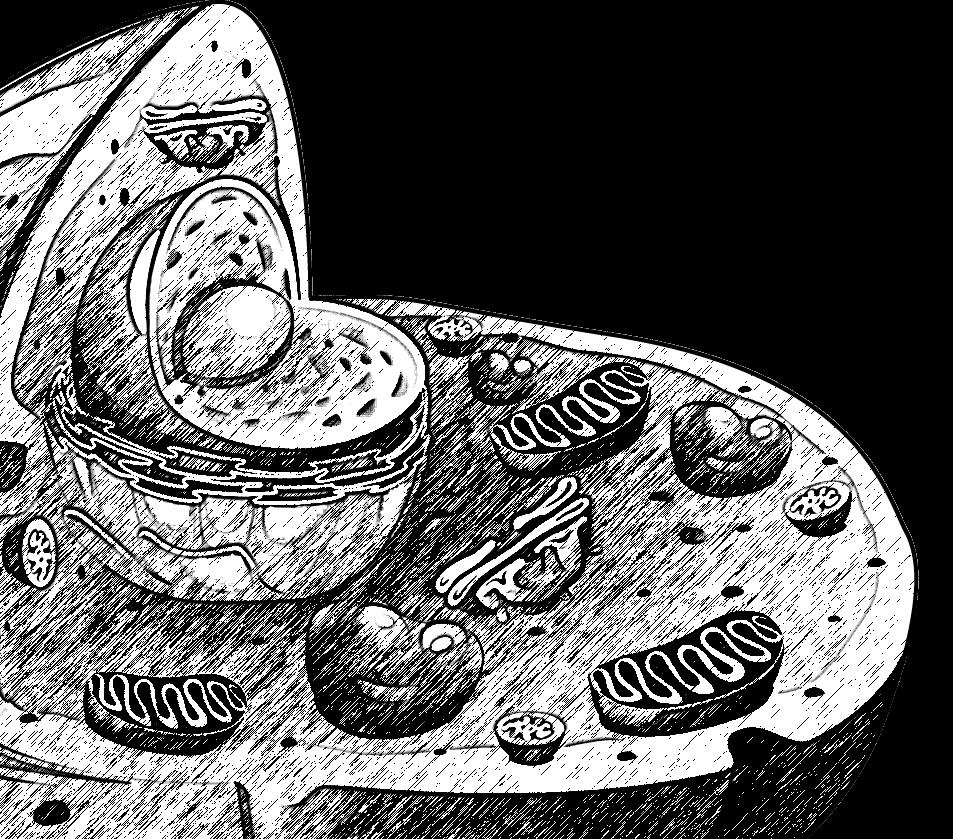
As we stride into 2024, we are presented with an exciting opportunity to develop our new strategy for the next 5 years, laying the groundwork for future plans and endeavours that will shape 2025 and beyond. This provides us with a moment to reflect on our core values as a Society and envision the profound impact we aspire to make on behalf of our valued members. At the heart of our mission lies a commitment to provide resources, unwavering support and opportunities to our members across our three scientific sections: Animal, Cell and Plant, and our OED group. As we embark on this journey, we recognise the pivotal role of nurturing the next generation of scientific leaders and pioneers. Therefore, a central tenet of our strategy will be the continued growing support for our early career researchers, with a keen focus on fostering career development across all facets of scientific inquiry. Whether our members are destined for the field of research, communication, education, policy or beyond, we aim to empower, inspire and propel them towards successful careers. I look forward to the opportunity to share more updates on development in future letters.
Professor Tracy Lawson President, Society for Experimental Biology


SEB NEWS

BY JULIUS KELLY

WELCOME TO GUDRUN DE BOECK, FUTURE PRESIDENT OF THE SOCIETY
The Society welcomes Gudrun De Boeck as its (number ) President of the Society. She will assumes her position at the Annual Conference in Prague in July this year.
Gudrun is a full professor at the University of Antwerp, Belgium, and is currently leading the ECOSPHERE research group, which aims to study both aquatic and terrestrial ecosystems that are continuously challenged by natural and anthropogenic stressors. She is also Chair of the Institute of Environment and Sustainable Development (IMDO) of the University of Antwerp, which promotes (and teaches) interdisciplinary science leading towards a more sustainable world. ECOSPHERE combines expertise in fundamental and applied research in aquatic ecology and in aquatic and terrestrial ecotoxicology and ecophysiology. Gudrun’s research group aims to underpin environmental management decisions with fundamental knowledge at different levels of organisation, from cell to ecosystem. Their main research themes are 1) integrated water management; 2) water and soil risk assessments; 3) macro- and micronutrients for healthy ecosystems; 4) bioavailability and accumulation of macro- and microcontaminants; and 5) physiological and molecular mechanisms of stress and toxicity of macro- and microcontaminants.
Gudrun’s own research falls under this last research theme and focuses on the effects of environmental factors on the fitness, energy metabolism and iono- and osmoregulation of fish. Studies are comparative in nature and species studied include freshwater and marine teleosts and elasmobranchs.

GOODBYE TO SEB EXECUTIVE TEAM MEMBER LOUISE TULLY (SEB EVENTS MANAGER)
The Society thanks Louise for the wealth of ideas and inspiration brought for the SEB Annual Conference in Prague, July 2024. The Society wishes Louise great success in her future endeavours.

WARM WELCOME TO BUNMI ODIAH, SEB EVENTS
The Society welcomes new starter Bunmi, who will be taking on the role of temporary Events Administrator.

PLANT SECTION CHAIR
The Society expresses its sincere thanks to Stefan Kepinski for the dedication he has given as the Plant Section Chair; Stefan is stepping down after a successful 4-year term and we are seeking nominations for his replacement. We wish Stefan well for the future.
The successful applicant for this Trustee position will be appointed for a 4-year term.

GOODBYE TO MARTIN PARRY (PUBLICATIONS TRUTEE)
The Society would like to thank Martin Parry, who has been our Publications Officer and Trustee since 2012. Martin has done a fantastic job bringing the Society and journals together and has been an invaluable member of the SEB Council.
Martin will step down at the end of April 2024 and we are very pleased that this role will be covered in the interim period, May to July, by Diana Santelia.

WELCOMES TO DIANA SANTELIA (NEW PUBLICATIONS TRUSTEE)
Diana Santelia has succeeded Martin Parry as the new Publications Trustee. Dr. Santelia, a senior scientist at ETH Zurich’s Department of Environmental Systems Science, leads the Plant Molecular Physiology research group. Her work focuses on carbohydrate metabolism in plants, aiming to improve crop productivity and stress tolerance. Dr. Santelia’s extensive expertise and leadership promise to significantly contribute to the publication’s future endeavors.
Contact Diana here : diana.santelia@usys.ethz.ch
OUTREACH, EDUCATION AND

DIVERSITY (OED) TRUSTEE
The society is very grateful to Sheila Amici-Dargan, who has served a very successful first 4-year term as the Outreach, Education and Diversity Trustee. We are pleased to announce that Sheila will continue to serve a second 4-year term.

UPCOMING EVENTS
EMPOWERING RESEARCH FOR COMMUNITY IMPACT
ABSTRACT SUBMISSION DEADLINE: 22/07/2024
REGISTRATION DEADLINE: 19/08/2024

EMPOWERING RESEARCH FOR COMMUNITY IMPACT—OED SYMPOSIUM
10–11th September 2024
Imperial College London, London
Please join us for this year’s SEB OED Symposium, “Empowering Research for Community Impact”, which will be taking place at Imperial College London from

MEMBER NEWS
IIn each issue of the member magazine, we like to highlight some of the fantastic achievements and research from our members. Here are some of the people we would like to congratulate this time around.
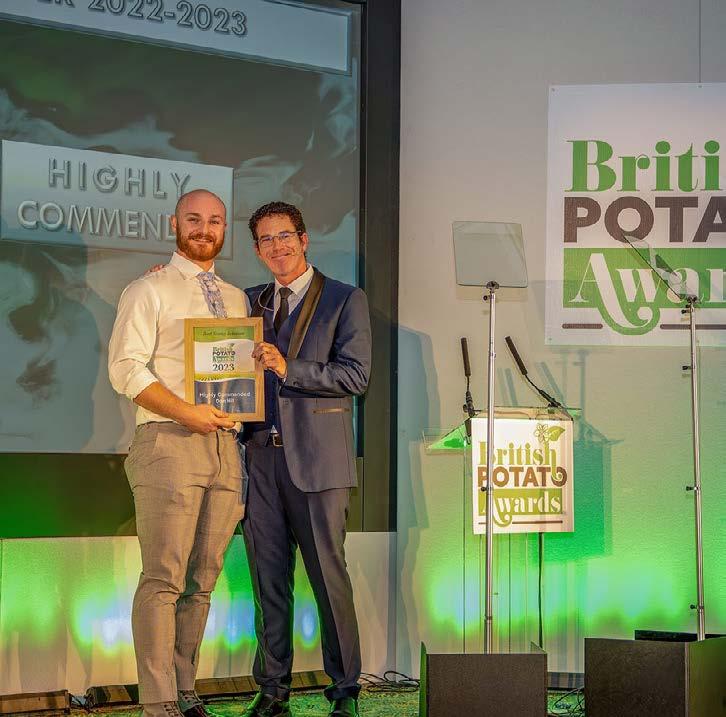
DOMINIC HILL (UNIVERSITY OF READING)
The SEB would like to congratulate Dominic for his outstanding contributions to science communication. As a PhD researcher at the University of Reading, Dominic has dedicated time to creating informative YouTube videos, bridging the gap between academia and the public. His work on irrigation strategies in potato and other biology topics showcases a commitment to sharing knowledge. Recognised with a ‘highly commended’ award at the British Potato Awards 2023, Dominic’s dedication to both research and outreach is commendable.
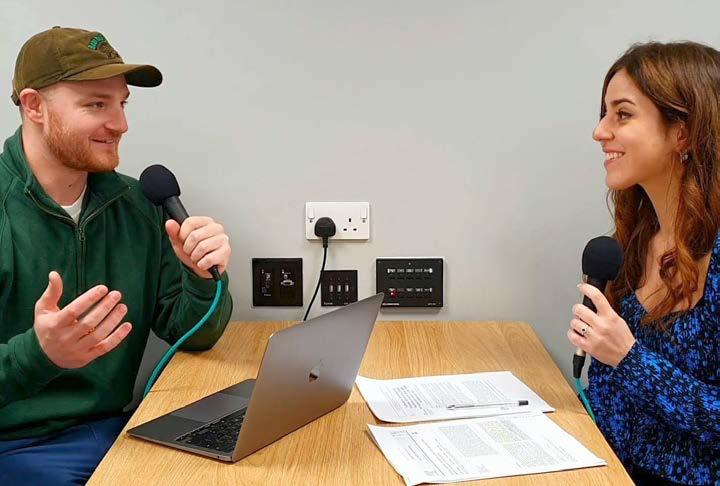
www.youtube.com/DominicHill
www.britishpotato.co.uk/british-potato-awards/ winners/2023-award-winners/

FRANÇOIS DRUELLE (MNHN, CNRS)
The SEB extends its congratulations to François Druelle for his recent publication in Journal of Human Evolution on muscular activity in baboons compared to humans. This fascinating research, featured in the Spring 2024 SEB magazine, sheds light on bipedal and quadrupedal locomotion. François’ work promises to enrich the SEB community’s understanding of primate biomechanics.
Find the full article here: www.sciencedirect.com/science/article/ abs/pii/S0047248424000216

MARIE JANNEKE SCHWANER (UNIVERSITY OF CALIFORNIA, IRVINE)
The SEB is thrilled to feature Marie Janneke Schwaner’s recent career achievement in the SEB magazine. Marie has been awarded the prestigious Marie Skłodowska-Curie postdoctoral fellowship from the European Commission for her exceptional work. Continuing her postdoctoral position at the Katholieke Universiteit Leuven in Belgium, alongside Friedl De Groote, Marie’s proposed project promises groundbreaking insights into neuromechanics. Her innovative approach, integrating neuromusculoskeletal modelling with in vivo muscle experiments, aims to unravel the complexities of walking and running over varied terrain.
Marie’s journey to secure such funding highlights her resilience and determination, having spent 8 years in the USA for her PhD and postdoctoral position. Her story serves as an inspiration to early career researchers navigating the challenges of establishing themselves away from home and seeking to reunite with family. The SEB celebrates Marie’s achievements and looks forward to witnessing her continued contributions to European research.
For further details, you can visit Marie’s announcement on her LinkedIn account: www.linkedin.com/feed/ update/urn:li:activity:7163994544051576832/
MARKO PROKIC (INSTITUTE FOR BIOLOGICAL RESEARCH SINISA STANKOVIC, UNIVERSITY OF BELGRADE)
The SEB celebrates Marko’s dedication to the groundbreaking project ENLIGHT, which focuses on the biological impacts of light pollution on amphibians. With a diverse team of early career researchers, Marko’s project aims to raise awareness
and implement conservation actions for protecting amphibians. His team’s comprehensive approach includes assessing developmental, survival and metabolic rates, among other factors, under environmentally realistic conditions of artificial light at night. Marko’s commitment to addressing this critical issue underscores the importance of interdisciplinary collaboration in environmental research.

Find out more about the ENLIGHT project: www.ibiss.bg.ac.rs/index.php/en/present/national/ item/3075-vestacko-nocno-svetlo-vodozemci www.instagram.com/enlight__project/ https://twitter.com/EnlightPromis
ANTOINE CRIBELLIER (WAGENINGEN UNIVERSITY)

The SEB proudly acknowledges Antoine’s recent publication in Current Biology, shedding light on how mosquitoes evade looming threats. This interdisciplinary research, blending ethology, biomechanics and sensory biology, offers valuable insights into mosquito behaviour. Antoine’s work, which has garnered significant media attention including coverage on national TV in the Netherlands, addresses a question of widespread interest. By delving into the mechanics of mosquito evasion,
Antoine’s findings contribute to our understanding of insect survival strategies and offer potential implications for pest control and public health.
Find the full article here: https://www.cell.com/current-biology/abstract/ S0960-9822(24)00103-9

KATHARINA RUTHSATZ (TECHNICAL UNIVERSITY OF BRAUNSCHWEIG)
The SEB extends its congratulations to Katharina, who was invited as a special guest and frog expert on the renowned German TV show, The Tigerenten Club. This beloved show has captivated young audiences for nearly three decades, making Katharina’s appearance an exciting opportunity to educate and inspire future generations about amphibians. By sharing expertise and research insights on frogs, Katharina has helped foster curiosity and an appreciation for nature among young viewers. This engagement exemplifies Katharina’s commitment to science communication and outreach, further enriching public understanding of amphibians and their ecosystems.
See the video: www.youtube.com/watch?v=xomYaccCqOM&ab_ channel=SWRPlus
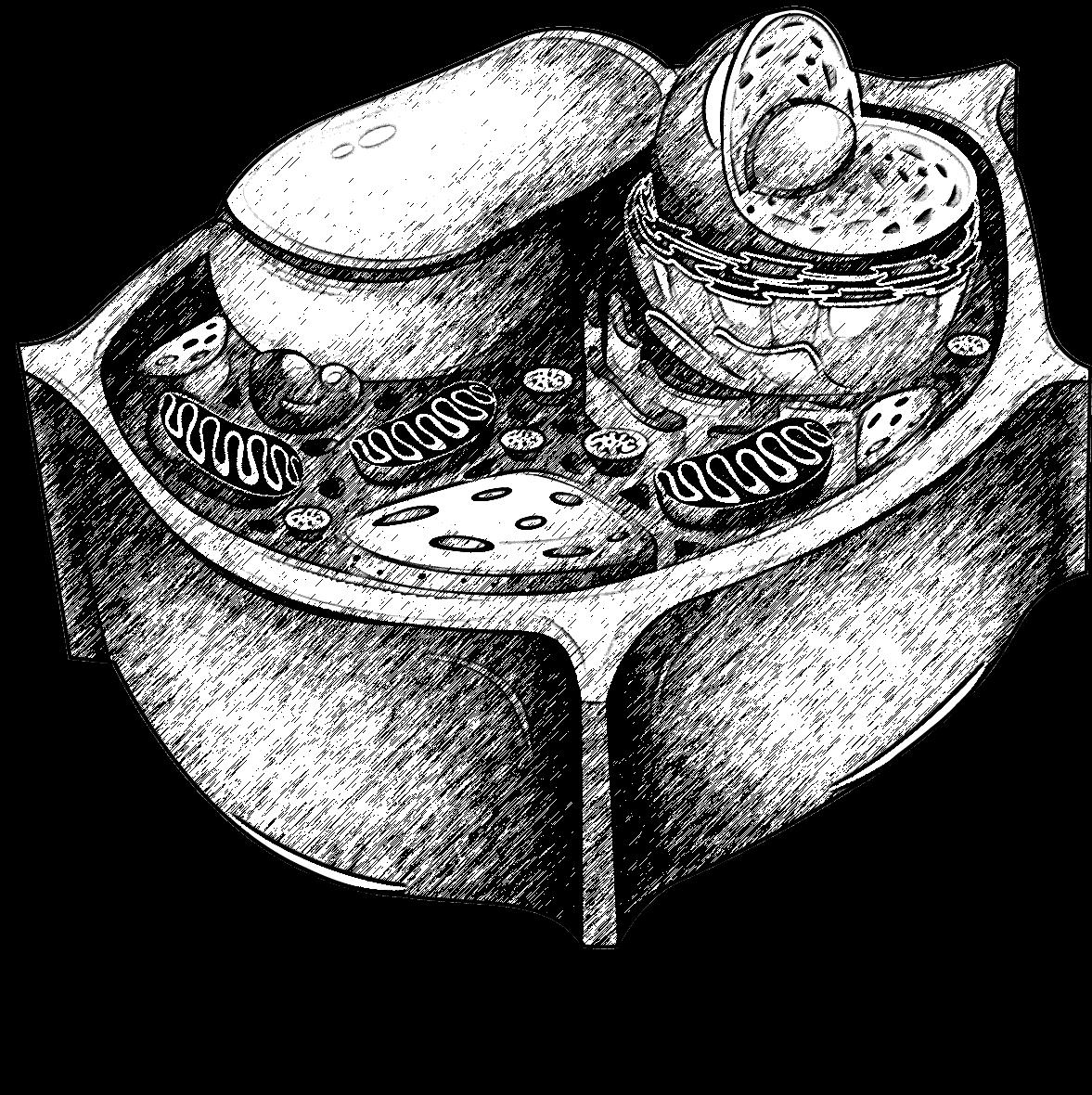

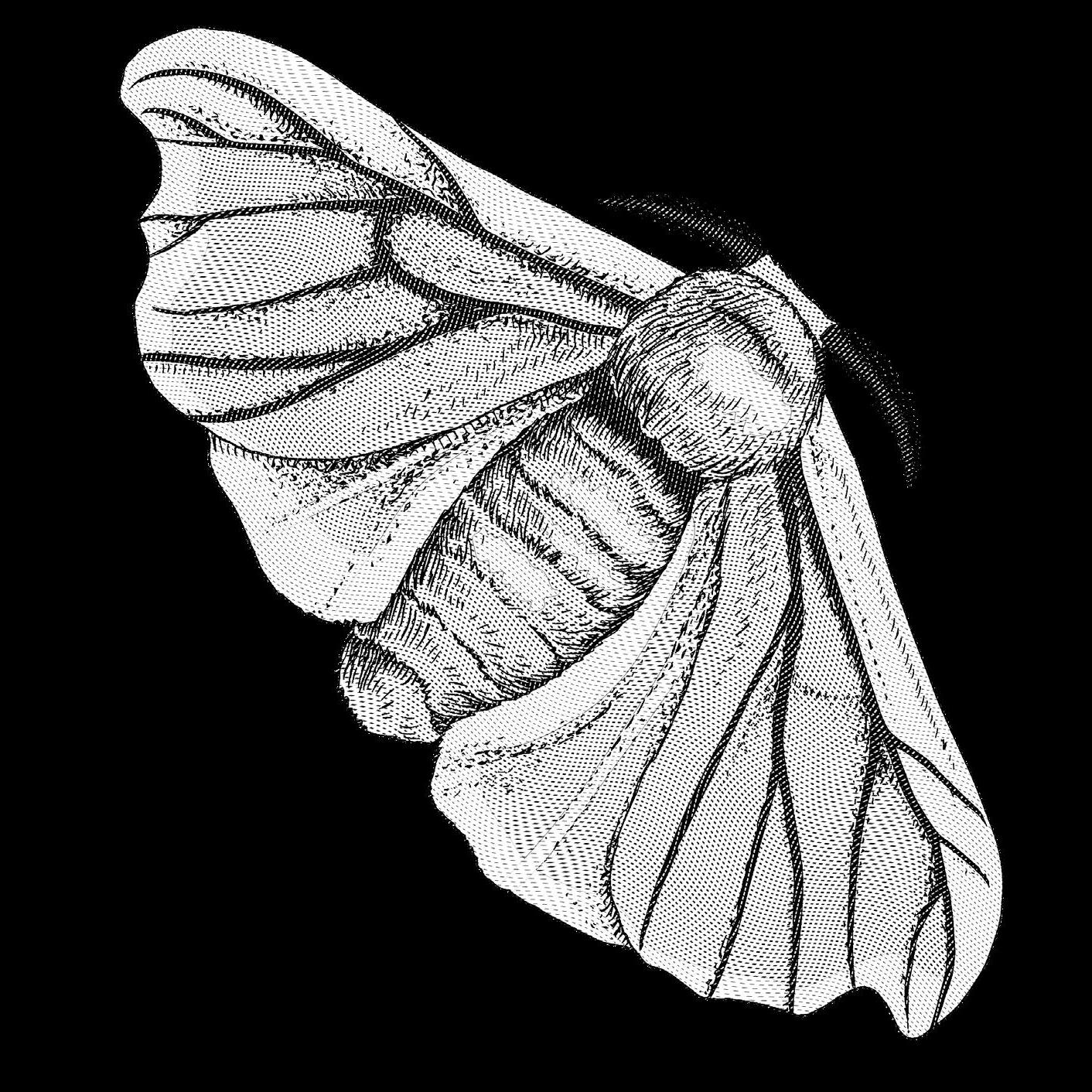
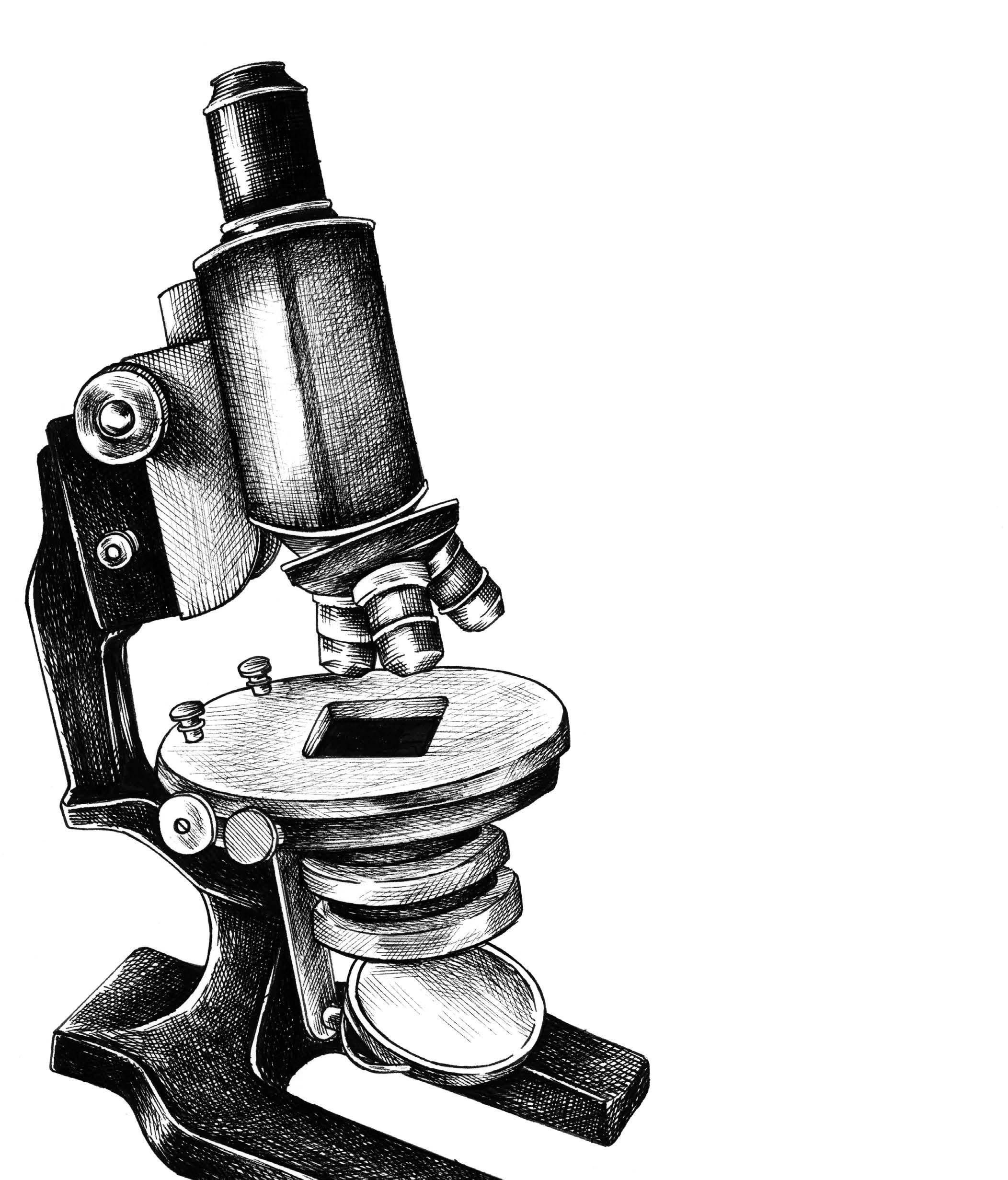
LYSOSOMES AREN’T JUST DESTROYERS
BY BRITTNEY G. BOROWIEC
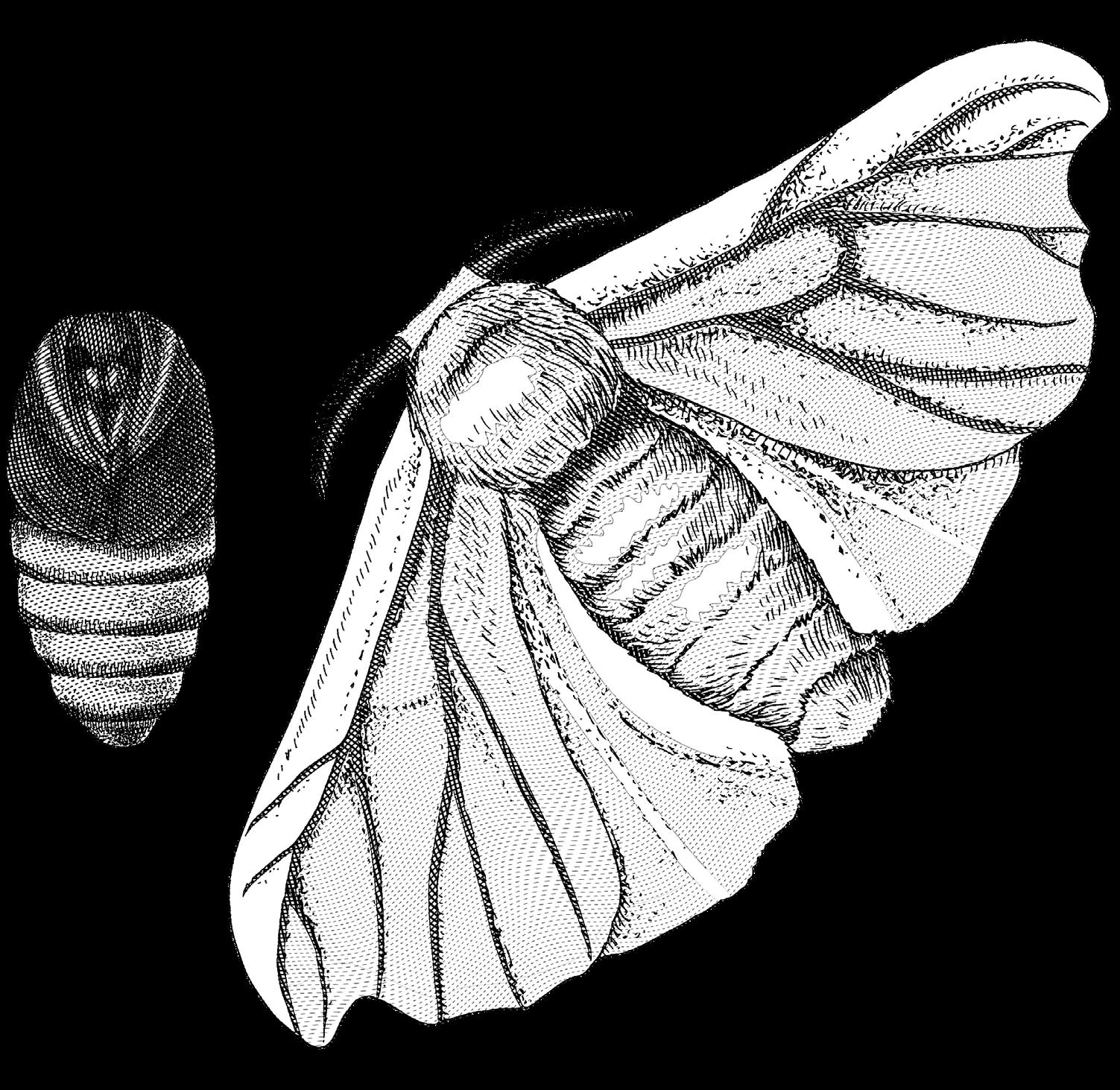
ANIMAL CELLS HAVE VACUOLES TOO
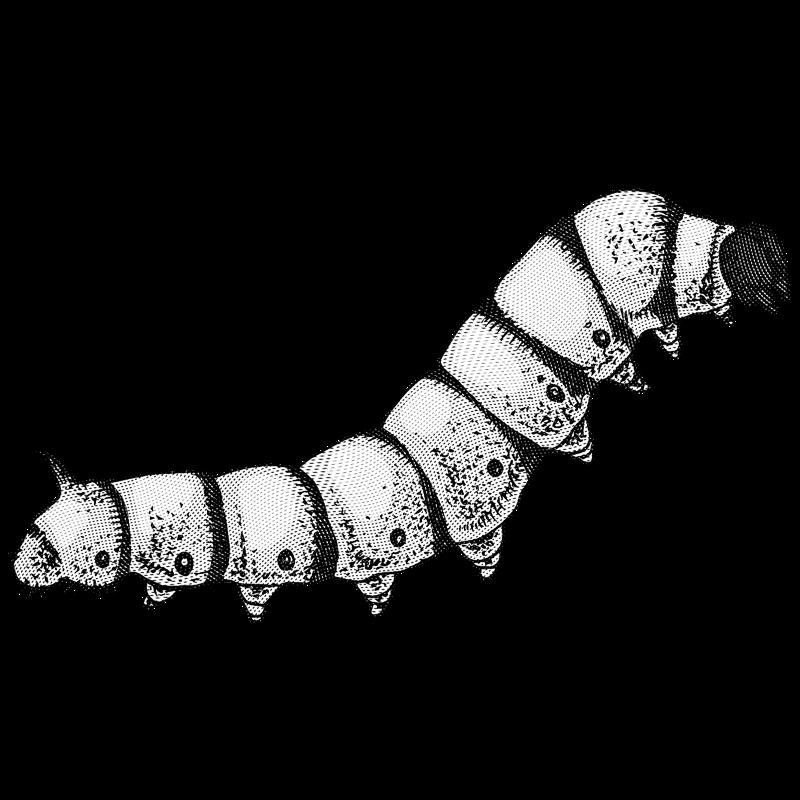
Vacuoles are membrane-bound sacs filled with molecules and compounds that shouldn’t be, at least right now, in the cytoplasm. If that definition sounds a bit vague to you—you’re right! There are several different types of vacuoles, named for their main function in a cell. Contractile vacuoles, which can stretch and expand, help maintain salt and water balance in organisms like protists. An especially unusual subtype is the air vacuole, little cylinder-shaped stores of gas that help algae cells float or sink, as necessary.
With animal cells, things get a bit more complicated. Their vacuoles are smaller and less complex than their counterparts from other kingdoms, and usually delegated as waste collectors. Because they are so simple, the line between vacuoles and other organelles that share their features gets blurry. It’s especially messy when it comes to lysosomes, the most well-known vacuole-esque thing in animal cells. Some scientists see lysosomes as a specialised type of vacuole, whereas others disagree and say that they are fundamentally different things. For today, let’s consider lysosomes to be vacuoles that are specialised for and found only within animal cells (though even that might not be true—plant cells have been known to have lysosome-like vacuoles since the 1960s!).
THERE ARE SEVERAL DIFFERENT TYPES OF VACUOLES, NAMED FOR THEIR MAIN FUNCTION IN A CELL.
CELLULAR RECYCLERS AND GERM DESTROYERS
Lysosomes have two jobs in animal cells: maintenance and defense. Both functions rely on the caustic soup of acid and digestive proteins contained within the lysosomes. In the case of the former, lysosomes function as a heavy-duty cleaning crew, relying on their harsh chemicals to scrub away the toughest and most complicated of messes. This process, called autophagy, involves lysosomes absorbing damaged, worn out or otherwise unneeded proteins, nucleic acids, fats and carbohydrates and dissolving them into smaller pieces.
Autophagy is absolutely essential to cell health. Not only does it prevent the interior of the cell from becoming too cluttered with debris and garbage, but the broken-down pieces of autophagy targets, like individual amino acids and simple sugars, can be recycled for future use. As the centre of the cell’s autophagy system, lysosomes play an important role in keeping cells healthy and making sure they have all the nutrients that they need to thrive.
Lysosomes help to defend the body from external threats and are one of the main weapons used by the white blood cells of the immune system. These cells roam the bloodstream, looking for pathogens. When they find one, a section of the cell’s membrane folds in during a process called
AUTOPHAGY IS ABSOLUTELY ESSENTIAL TO CELL HEALTH.
and
Gene therapy/gene sequencing stock images.
Top
bottom right:
Photo credit: National Cancer Institute (Unsplash)
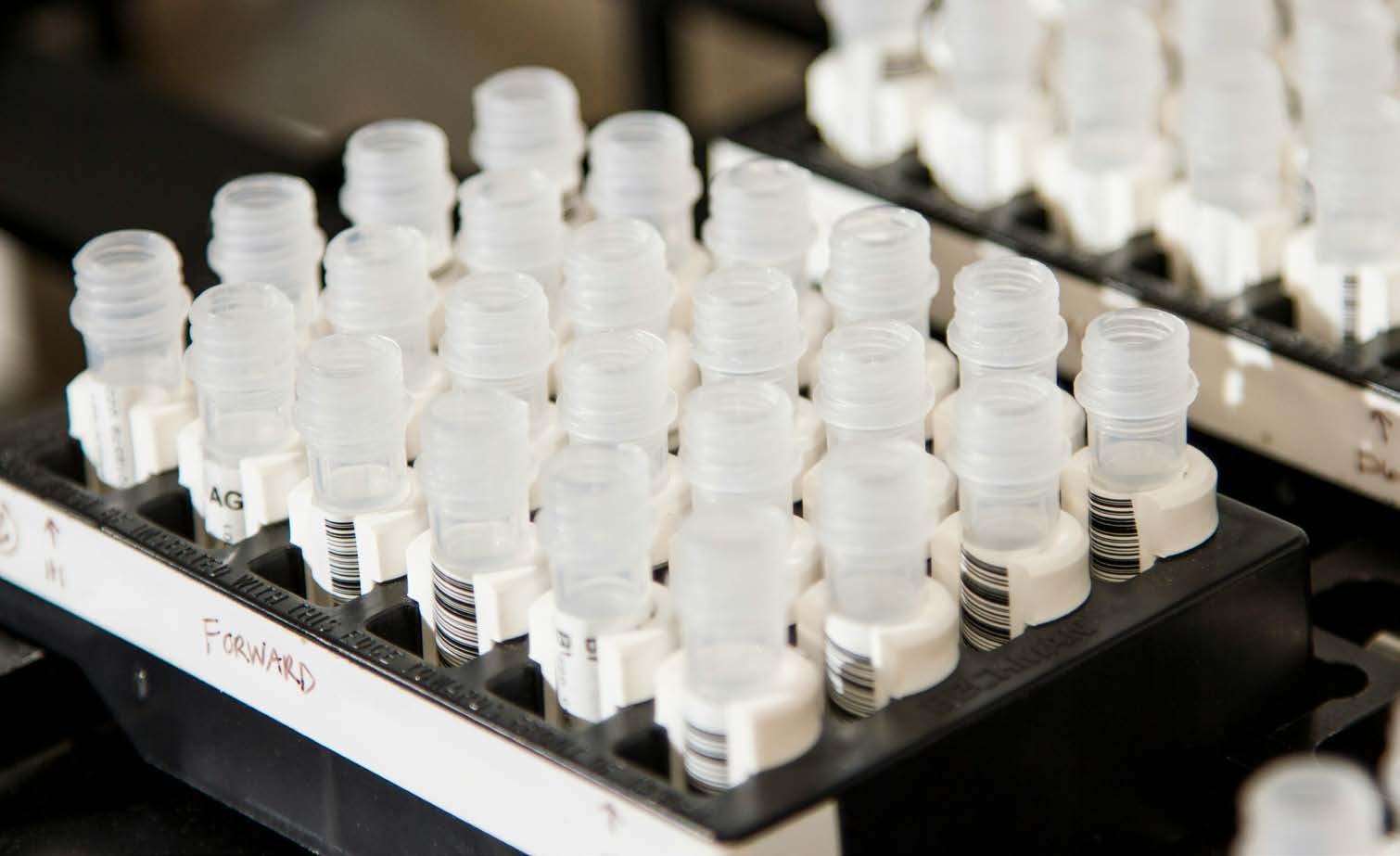
phagocytosis and engulfs the interloper, preventing it from causing further damage or disease. The phagosome then fuses with a lysosome, which digests the pathogen using the same acid and proteins used for autophagy. But it goes even further than that! In specific types of white blood cells, lysosomes will save pieces of the offending pathogen, called antigens, and recycle them as training tools for the immune system. The antigens are then present ed to immune cells so that they can learn to recognise and respond to future threats.
NOT ONE, BUT TWO NOBEL PRIZES
In the seven decades since their serendipitous discovery, lysosomes have generated two Nobel Prizes. The first was awarded to Belgian biochemist Christian de Duve in 1974, who accidentally discovered them while trying to isolate an enzyme (glucose 6-phosphatase) thought to be important in diabetes. After several failed attempts, De Dube used differential centrifugation (a technique developed by one of his co-awardees, Albert Claude) to separate broken-down cells into different fractions based upon the size and weight of each material, hoping that it would make it easier to isolate the elusive glucose 6-phosphatase.
Working with the fractions, Dube was surprised to find that one of those fractions contained particles able to damage proteins and other cellular components. Following a few more tests, he deduced that these strange particles must be hidden away in living cells to avoid internal damage. Dube collaborated with experts in electron microscopy to find the storage site of these aggressive enzymes, naming them lysosomes (meaning a body or thing that causes lysis, breakdown or damage, a reference to their digestive properties).
Subsequent work by Dube and others, including 2016 Nobel Prize winner Yoshinori Ohsumi, would detail the functions of lysosomes in the cell. Ohsumi’s work specially focused on autophagy, the most famous role of the lysosomes. He used mutant yeast that were unable to degrade vacuoles, which caused lysosomes to accumulate within the cells when they were starved of nutrients. With this model system, Ohsumi engineered a reliable way to turn on autophagy in yeast, a technique that would be foundational to his future work in elucidating the molecular details of the process. Ohsumi then exposed his yeast cells to mutationinducing chemicals, carefully observing which mutations caused the cells to lose their ability of autophagy. Over time, he identified the essential genes for autophagy, and characterised the proteins that they encoded, uncovering many of the core mechanisms of this important cellular process.
EMERGING RESEARCH
ON LYSOSOMES: WHAT ELSE DO THEY DO?
Given the intensive research on just autophagy alone (estimated to be over 60 papers per week in 2017), future scientific breakthroughs related to lysosomes are almost certainly on the horizon. Contrary to their reputation as rubbish bins or destroyers, contemporary research on lysosomes highlights the many other cellular processes in which they are involved, including cellular signalling, nutrient sensing and metamorphosis. There is also much interest in understanding how lysosomes interact with diseases such as cancer, and how they may prove to be a fertile testing ground for innovative medical interventions such as gene therapy.
LYSOSOMES IN CELLULAR SIGNALLING AND REGULATION
Perhaps the most significant shift in our understanding of lysosomes outside of de Dube and Ohsumi’s work is the now several decades’ worth of evidence that these small but mighty organelles are far more than a biochemical dead end where compounds (or pathogens) are destroyed. Lysosomes are dynamic regulators within the cell. They often act as “launch pads” for signals between organelles, including the cell’s mission control, the nucleus. Lysosomes therefore actively participate in several important pathways, influencing processes as diverse as transmitting signals within the cell, metabolic adaptation, cell growth and specialisation, and the quality control of proteins and other organelles.
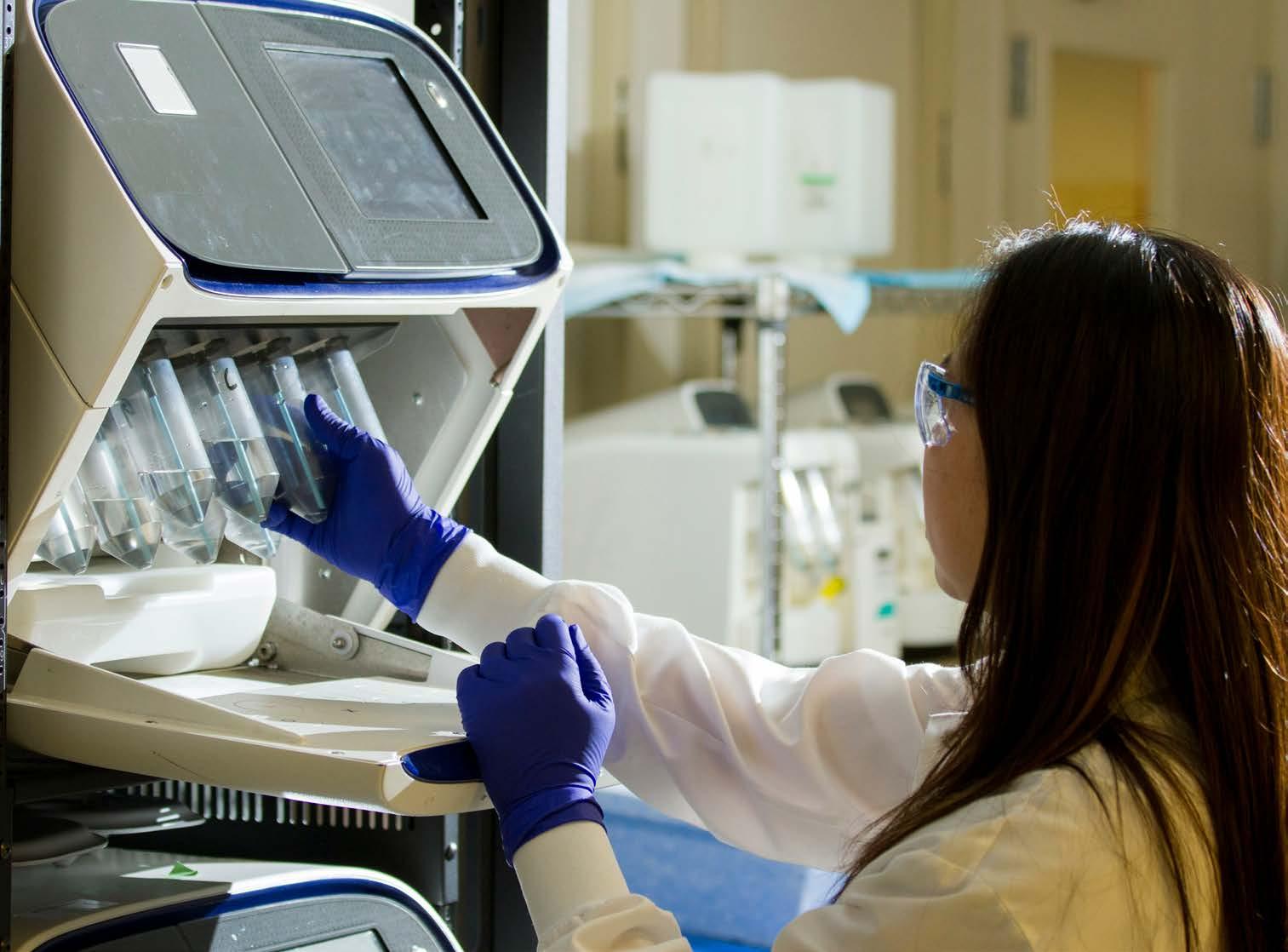
NUTRIENT SENSING AND GROWTH PROCESSES
Because lysosomes spend a lot of their time degrading and recycling cellular materials, they are uniquely positioned to keep tabs on a cell’s nutritional status. Exactly how they do this remains somewhat mysterious, but it likely involves mTORC1 (mechanistic target of rapamycin complex 1), a protein complex termed the ‘master growth regulator’ of cells. mTORC1 effectively tells cells to make more proteins, but only when conditions are just right, including there being enough nutrients and growth factors available to use. mTORC1 can’t do its job without the help of the lysosomes: mTORC1 has to physically bind to the lysosome’s surface to send its signal. This means that in addition to being responsible for getting rid of clutter inside a cell, lysosomes are also a crucial piece of how cells control their growth and protein production.
Aside from mTORC1, the other major cellular signal involving lysosomes is the transcription factor EB (TFEB), a protein that modulates when certain genes are turned on or off. TFEB is sometimes called the ‘master of lysosomes’, because many of the genes that it targets are related to autophagy or specific proteins found within these organelles. But that’s not the only thing that TFEB does. For one, its intertwined with mTORC1, meaning that it likely influences many of the same pathways. More broadly, TFEB also interacts with other heavy hitters in cellular signalling like PGC1ɑ, which controls mitochondrial growth and fatty acid metabolism, as well as PINK1 and Parkin, which induce the breakdown of damaged mitochondria. Through their close association with TFEB, and the many effects of TFEB in the cell (some of which have yet to be characterised), lysosomes are probably involved in a lot more cellular pathways than we give them credit for.
LYSOSOMES IN INSECT METAMORPHOSIS
Lysosomes are not just an organelle of growth, but of transformation. Lysosomes play a crucial role in metamorphosis, the extreme physical changes that occur when animals like insects and amphibians develop into their adult forms. Before a caterpillar can earn its wings as a moth, it first has to break much of its body down into the necessary building blocks. That’s where autophagy, and by extension, lysosomes, come in.
In moths and caterpillars, several organs, including the silk glands, fat body (an organ that is similar to a combination of adipose tissue and liver) and midgut, are remodelled during metamorphosis, and this involves huge increases in the presence of lysosomes in these tissues. The lysosomes do
what they do best—autophagy—breaking down these larvae tissues into their core components.
TFEB ALSO INTERACTS WITH OTHER HEAVY HITTERS IN CELLULAR SIGNALLING LIKE PGC1.
With the advent of sophisticated tools and models, researchers have turned their attention to understanding the molecular basis of autophagy, especially how it interplays with the related but distinct process of programmed cell death (apoptosis) that also occurs during metamorphosis. Work on fruit flies as well as silkworms suggests that the complexity goes so far as to vary between organs— autophagy is important for the destruction of larval midgut and salivary glands, but it is apoptosis and not autophagy that enables remodelling of the abdominal muscle.
LYSOSOMES IN HUMAN HEALTH AND DISEASE
Lysosomes are implicated in the initiation and development of numerous diseases, caused both by specific defects within the lysosomes and by less specific underlying mechanisms, like cancer. Understanding exactly how lysosomes change in patients with these conditions could lead to new therapies and better quality of life, and such work accounts for much of the contemporary research on lysosomes.
LYSOSOMAL STORAGE DISEASES
Like any organelle, lysosomes can themselves be dysfunctional or defective. Lysosome storage disorders are caused by inherited defects in the genes responsible for lysosomal enzymes, membrane proteins or other components. Over time, cells with dysfunctional lysosomes accumulate undigested debris, leading to a diversity of symptoms depending upon exactly which of the lysosomes’ proteins are affected. Cells with lysosomal defects also tend to show collateral damage in the form of dysregulation of the autophagy process (even
Top right: EM graph of one of the lysosome storage diseases in the kidney, showing large amounts of accumulated material
Photo credit: Pr Marie-Claire GUBLER, Paris, France.
Bottom Right: silkworm moth, eggs, cocoon Photo credit: David Clode (Unsplash)
Bottom: white blood cell ingesting anthrax Photo credit: Volker Brinkmann GUBLER, Paris, France.
LYSOSOMES ARE NOT JUST AN ORGANELLE OF GROWTH, BUT OF TRANSFORMATION.
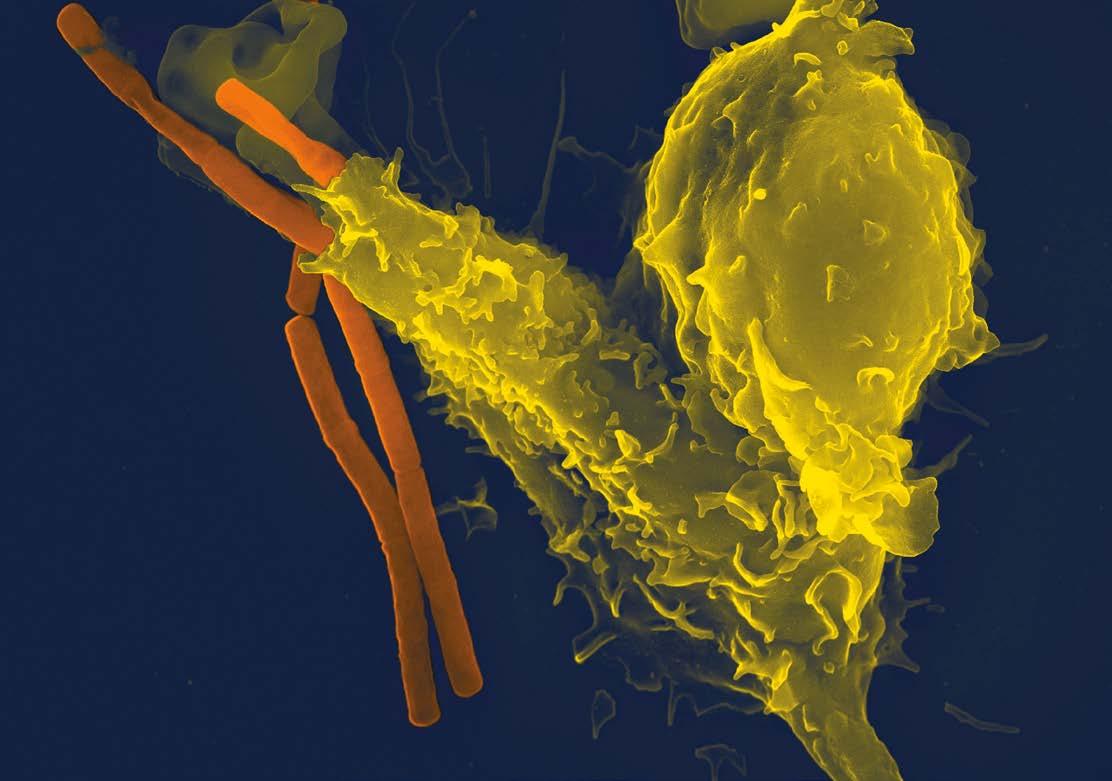
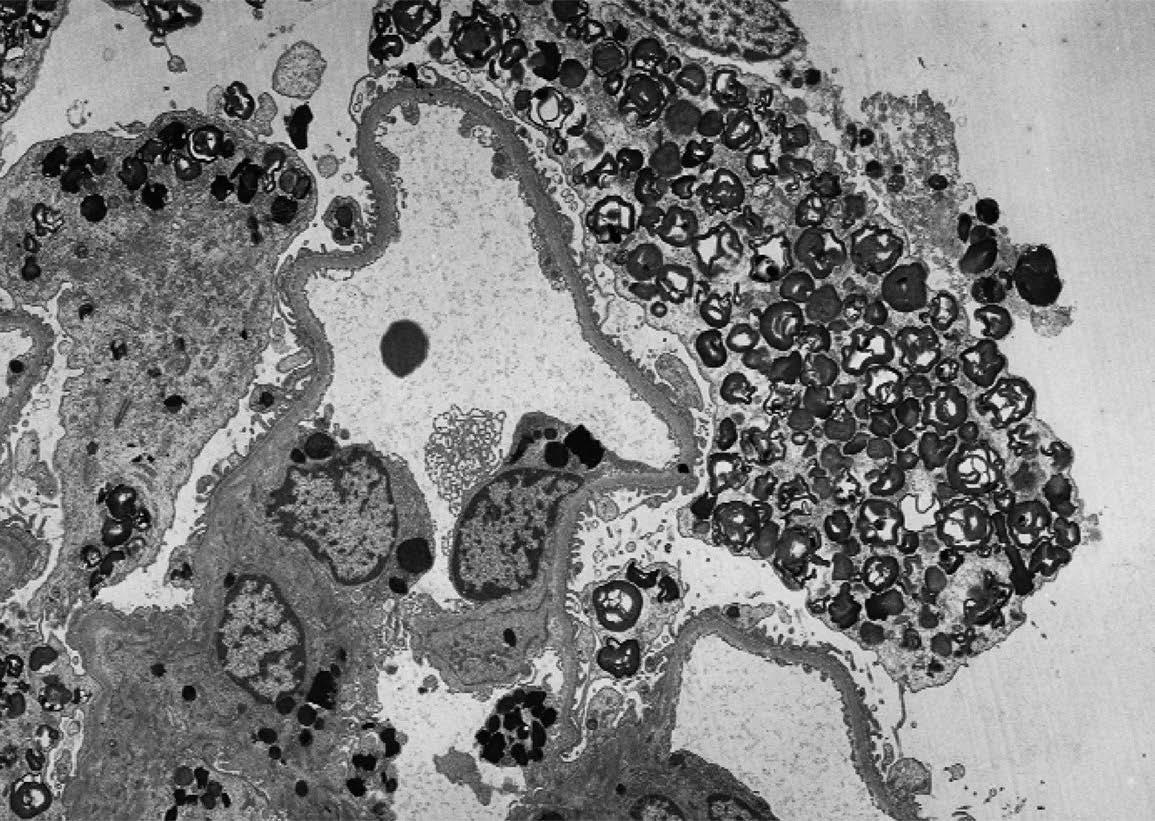
for molecules that should be unaffected by the patient’s specific mutation) and impairments in the essential mTORC1 pathway.
Though individually rare, lysosomal storage disorders are relatively common when considered as a group, affecting as many as one in 5000 people, so there is a lot of interest in uncovering the mechanisms, and potential treatments, of these conditions. Moreover, lysosomal storage disorders can be extremely debilitating for patients—over two thirds of them are associated with neurodegeneration. Unfortunately, the currently available treatments for lysosomal storage diseases are limited, focusing on alleviating specific symptoms such as by replacing defective enzymes with transfusions or even bone marrow transplants.
However, with the rapid pace of innovation in cell and molecular biology in the last couple of decades, including the advent of CRISPR gene editing approaches, things may soon change. Because many lysosome storage diseases can be traced back to mutations in a single gene, they are good candidates for gene therapies, where a functional copy of the affected gene is delivered to the patient’s cells. Several clinical trials for gene therapies targeted towards lysosomal storage diseases are currently underway. Early evidence suggests that results are promising, though there is still much work to be done before they become standard medical practice.
CANCER AND CANCER TREATMENT
The defining feature of cancerous cells is aggressive, unchecked growth and proliferation. Cancer cells must synthesise vast amounts of protein, DNA and fats to support their high metabolism. At the same time, they also need to remove damaged and degraded cellular components as quickly as
possible so that they can scrap them for parts. As the arbiters of autophagy, a key piece of the cell nutrient cycle, lysosomes play an important role in cancer progression and are increasingly viewed as a possible target for cancer treatment.
Cancerous cells tend to bump up nutrient-scavenging processes, including autophagy, which allows them to survive in unfavourable conditions such as poor blood supply or following chemotherapy. Lysosomes can even protect cancer cells by stashing chemotherapy drugs within them, preventing them from reaching their intended targets within the cell and making them less effective. Lysosomes are also implicated in various other cancerous processes, including altered growth and energetics,
promoting tumour spread and helping cancer cells escape detection by the immune system.
The general idea of targeting lysosomes in cancer treatment is that disrupting the lysosomes will make cancerous cells weaker and easier to treat. Though still in the early stages, some potential approaches include using agents that raise the pH inside the lysosome, rendering many of its enzymes nonfunctional, or that prevent lysosomes from fusing with autophagosomes, a critical step in autophagy. Early clinical trials suggest that patients provided with such antilysosome drugs in addition to other treatments, such as radiation, survive longer and seem to have slower tumour progression. However, with only two autophagy-inhibiting drugs available, it will be a while before they are considered standard treatment.
RECYCLER, DEFENDER AND MORE
Lysosomes are far more than their reputation as destroyers or garbage dumps. As recycling centres, lysosomes are intricately involved in cell growth, not just by obtaining the required building blocks, but also in giving the cell the go ahead to start construction. In animals like insects, lysosomes go even further, as key players in the process of metamorphosis. Finally, lysosomes are increasingly being considered as a potential therapeutic target for diseases like cancer as well as a viable testing ground for innovative approaches like gene therapy.
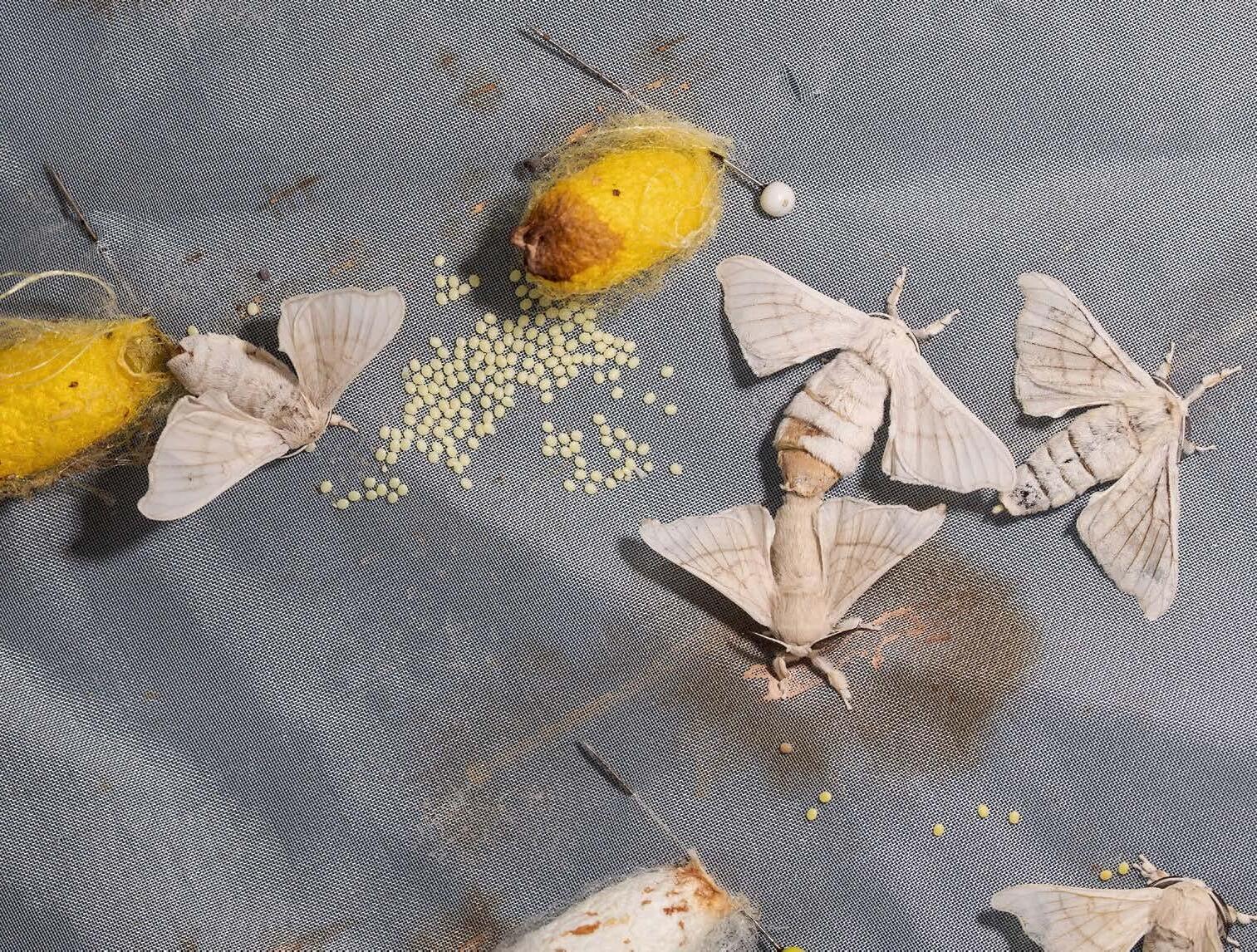
LEARNING THE INS AND OUTS OF VACUOLES
BY ALEX EVANS
Vacuoles are everywhere. Present in at least some form in cells across the plant, fungi, animal, protist and bacterial kingdoms, they truly represent a ubiquitous element of eukaryotic life. But despite their near omnipresence, the role that vacuoles play within cells of different organisms, and often within the same organism, can vary wildly, so let’s hear about some of those roles from SEB’s cell biologists.
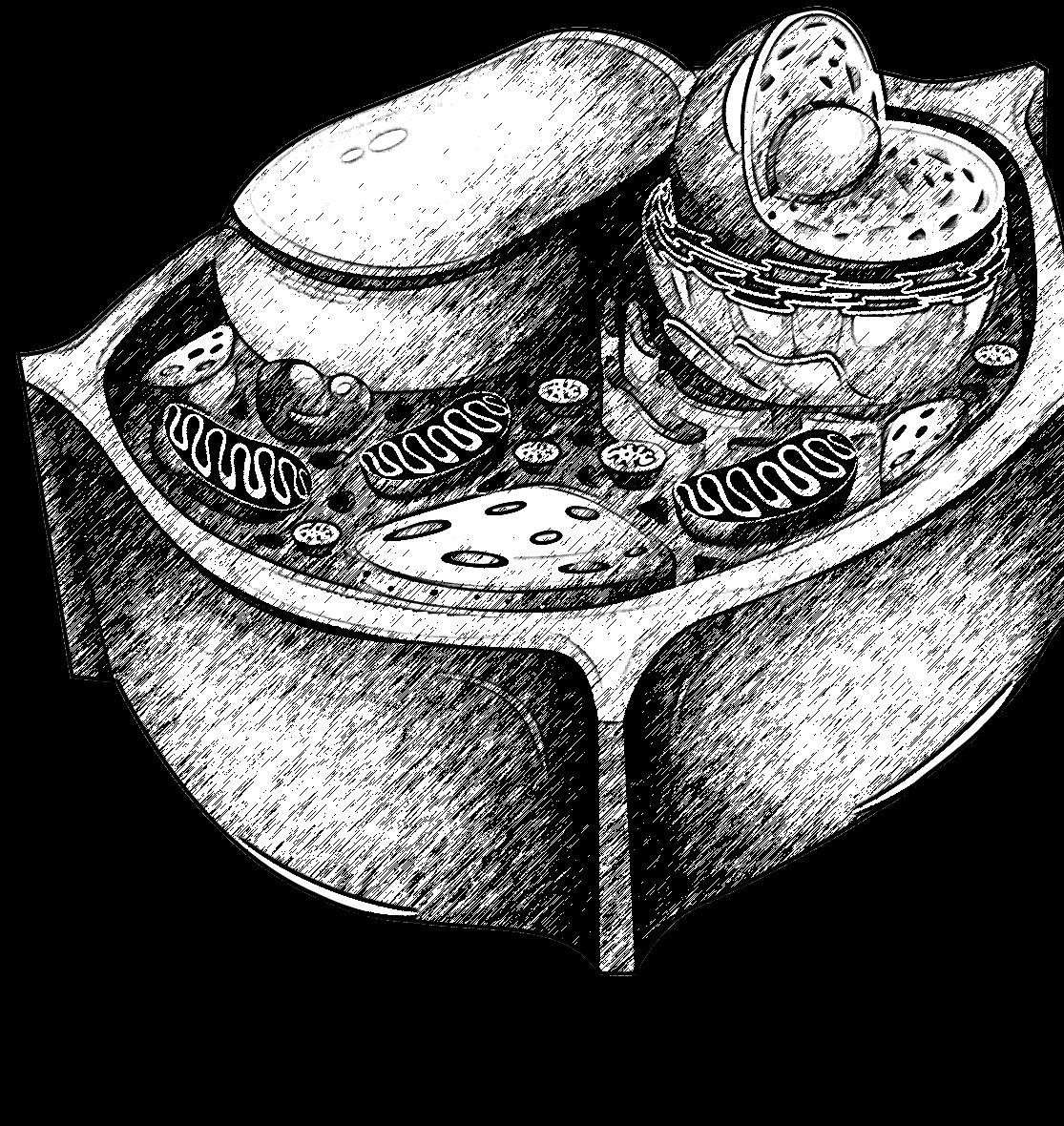
The vacuole is a vitally important organelle for all plants, carrying out multiple life-critical functions— but to assume that all plant vacuoles are created equal would be wrong. For this, we can thank Lorenzo Frigerio, professor in the School of Life Sciences at the University of Warwick, UK, who first got hooked on plant vacuole research in the midnineties. ‘I spent 6 months in the lab of Natasha Raikhel, one of the world’s authorities on vacuoles,’ he explains. ‘I became fascinated by the topic of the secretory pathway and how proteins move from A to B.’ Following this initial introduction to the mysterious organelle, Lorenzo then took up his first postdoc with Alessandro Vitale at the National Research Council in Italy, where he began researching storage proteins within the vacuole.
During this time, it was largely understood that there were two mutually exclusive forms that plant vacuoles could take, one being the lytic vacuole for storing cell waste and the other for storing proteins. Lorenzo’s primary focus was the protein storage vacuole. ‘I wanted to understand which signals were required to direct storage
Opposite Page Right:
Root tip cells showing high levels of growth due to vacuolar size changes
Photo credit: David Scheuring
Opposite Page Left:
3D reconstruction of a vacuole based on confocal z-stack imaging
Photo credit:
Ann-Kathrin Rößling
proteins to the vacuole,’ says Lorenzo. ‘In fact, my first postdoc in Warwick was working with Lynne Roberts on the trafficking of ricin to the vacuole.’ While castor plants are known for producing beans containing the potent ricin toxin, they are able to do so without being affected by the toxin’s harmful effects. ‘However, if you take ricin externally and then give it to castor bean cells, you can actually kill them,’ he says. ‘So, I ended up identifying the vacuolear sorting signal and the trafficking pathway for ricin, which showed that ricin is kept as an inactive precursor until it reaches the vacuole and then it is cleaved into its active dimeric form.’
Lorenzo’s continued research in this topic only served to increase his interest in the dichotomy between lytic and storage vacuoles in plants. ‘I decided to systematically explore how many distinct vacuoles there really are in the model plant Arabidopsis,’ he says. ‘In 2007, we showed that in any given cell, you only find one type of vacuole at a time. If it’s a vegetative cell, you get a lytic vacuole, and if it’s a seed cell, you get a storage vacuole.’ This observation led Lorenzo to elucidate the biogenesis of protein storage vacuoles. ‘In 2018, we published a paper in which we were able to use three-dimensional, serial blockface scanning electron microscopy (SBF-SEM) to reconstruct the whole process,’ he explains. ‘We were able to show that, effectively, storage vacuoles are the evolution of an initial, lytic-like vacuole that exists in the early embryo.’
The next step happened by chance. The cover image of the journal featuring Lorenzo’s protein storage vacuole biogenesis study drew the attention of a German physicist named Roland Knorr, who got in touch with Lorenzo to let him know that the storage vacuole division observed in late stages of seed maturation could be the result of liquid–liquid phase separation. ‘I’d never even heard of it, so we started collaborating and we actually established that vacuole division seems to be initiated by this biophysical process, which is driven by the storage proteins themselves.’ It appears that when storage proteins reach a critical concentration within the vacuole, they are able to form droplets that actually remodel the vacuole membrane and bring about vacuolar division in a process that appears to be physical rather than genetically coded.
Putting his research to one side, Lorenzo has another claim to fame that centres around his love of vacuoles. In 2011, Lorenzo teamed up with fellow SEB member Anne Osterrieder, who was working at Oxford Brookes University at the time, and the musician Cyrus Mower to create The Vacuole Song—a musical tribute to this wonderful organelle. ‘It’s really just a funny song about vacuoles, but there is a lot of good science in there,’ he explains. ‘This remains my single most important contribution to biology, with 83,000 views on YouTube. It’s not Gangnam Style, but it’s not bad!’
ONE ENZYME, MANY FUNCTIONS
In the world of microalgae, which is a much bigger world than you might expect, vacuoles can function a little differently to their plant and animal counterparts. Daniel Yee, an algal cell physiologist at the University of Grenoble-Aples, France, is researching the cellular mechanisms of integration and adaptation in marine plankton, with a focus on how diatom cells are able to store nutrients and synthesise their unique cell walls in different environmental conditions.
Diatoms are encased in a crucially important cell wall made of silica that is first synthesised inside the cell, and then gets extruded outside of the cell. ‘Silicon deposition vesicles (SDVs) are transient compartments within diatoms where silica is biomineralised for producing their shells,’ explains Daniel. ‘Silica biomineralisation is a central function of the diatom life cycle, and my research provided physiological evidence that pH control by vacuolar H+-ATPase (VHA) is crucial for advancing various steps of cell wall synthesis, cell division and the nanoscale architecture of silica shells.’ VHA is a surprisingly well-conserved enzyme that is commonly found in the membranes of vacuoles in many eukaryotic organisms, and it assists with proton transport in and out of the cell. ‘I was introduced to VHA during my PhD with my mentors Mark Hildebrand and Martin Tresguerres at the Scripps Institution of Oceanography,’ says Daniel. ‘VHA can influence intracellular pH and produce electrochemical gradients across cellular membranes, so I was interested in understanding how this conserved protein functions in diatoms.’
To reach this understanding, Daniel relied on a range of different equipment that helped him to determine the role of VHA in not only cell wall synthesis, but in other functions too. ‘My research combined transgenic tools in diatoms with livecell imaging using epifluorescence and confocal microscopy,’ he explains. ‘By combining these tools with carefully designed experiments, I was able to characterise protein dynamics to link VHA
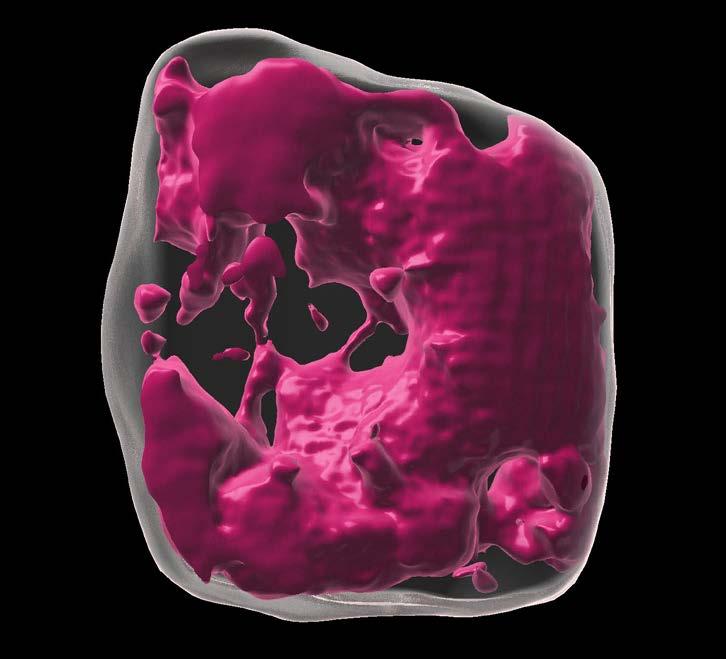
with multiple physiological roles in diatom cells, including silica biomineralisation, photosynthesis and vacuole homeostasis.’
‘I was impressed to discover how a single protein complex like VHA was able to simultaneously contribute to multiple physiologies of a unicellular organism,’ he says. ‘For example, I observed VHA in vacuoles translocated to the SDV to produce the cell wall, but also found it present around the chloroplast to help drive a carbon concentrating mechanism (CCM) for photosynthesis.’ While these tiny unicellular diatoms may seem small and fragile, they are among the most diverse and abundant aquatic lifeforms on the planet and make up a significant proportion of the ocean’s biomass. Their impact on global oxygen production and the silicon and carbon cycles cannot be overstated, so Daniel has been keen to find out how resilient these cells are to environmental change. ‘Intracellular pH regulation by VHA is a form of cellular homeostasis that enables the cell to carry out essential functions despite external environmental fluctuations,’ he says. ‘In my experiments investigating VHA in the CCM, I showed that diatoms could quickly adapt to varying inorganic carbon levels to maintain similar rates of photosynthesis and growth.’ However, as promising as this may sound, Daniel adds that these findings are the result of experiments lasting hours and days, so care needs to be taken when extrapolating to any longer-term scenarios.
Ultimately, Daniel’s research demonstrates the evolutionary flexibility that vacuoles offer. ‘I like to think of vacuoles and their membranes as a “room of requirement” in eukaryotic cells,’ says Daniel, comparing their adaptability to the magical multifunctional room from the Harry Potter series. ‘In diatoms, they likely evolved to form the SDV and were the source for membranes that now surround diatom chloroplasts.’ However, his work is not yet finished and there are still lingering questions that he wishes to solve. ‘I have yet to experimentally link VHA in diatom vacuoles membranes to a specific cellular function, but I suspect it may serve in nutrient storage and buoyancy,’ he suggests. ‘I think investigating the regulation of VHA activity in diatoms can be used to further understand the roles of membrane dynamics and turnover in rapidly dividing eukaryotic cells.’
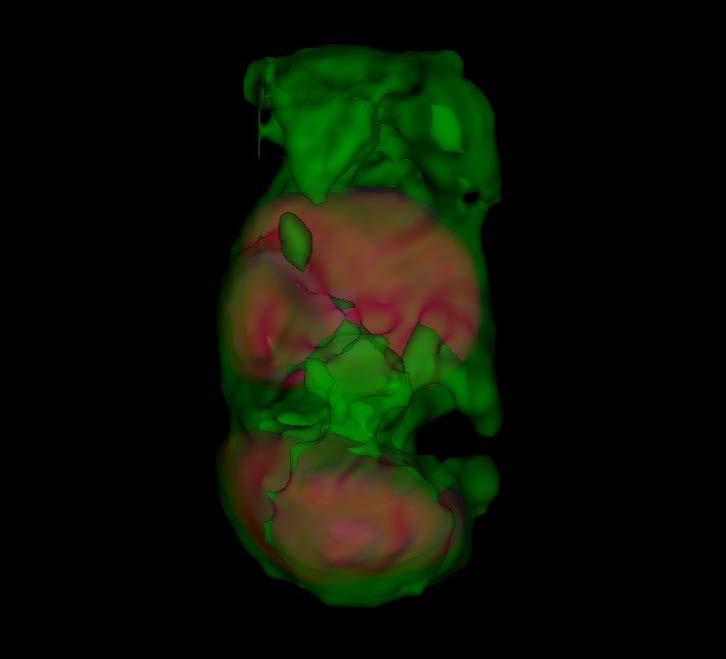
SIZE DOES MATTER
Upon his first introduction to a plant vacuole, the sheer size initially came as something of a surprise to Jurgen Kleine-Vehn, now a professor and Chair of Molecular Plant Physiology at the Centre for Integrative Biological Signalling Studies (CIBSS) at the University of Freiburg, Germany. ‘Initially, a vacuole was just a big lysosome for me,’ he explains. ‘However, upon delving into plant biology, I couldn’t ignore the stark contrast in organelle size—while animal lysosomes are relatively small, plant vacuoles can occupy a staggering 80–90% of the cellular space!’ Jurgen’s interest in vacuolar research was then piqued by how little we seemed to understand about the close relationship between vacuole size and overall size of the cell. ‘When I established my independent research line, exploring this correlation became a fascinating possibility,’ he says. ‘Since then, we have addressed mechanisms governing vacuole size regulation and its implications for cellular expansion.’
This mystery of how vacuoles get so large and their importance to cellular growth has played a key role in Jurgen’s lines of research. ‘Plant cells possess a remarkable ability to enlarge extraordinarily fast, a process which is crucial for plants to be the first to explore their surroundings,’ he explains. ‘Central to this phenomenon is the dynamic expansion of vacuoles during cell enlargement.’ Interestingly, while vacuoles are generally thought to take up a vast quantity of a plant cell, that is not always the case. Rather, they initially occupy a much smaller fraction of the cell—approximately 30% in the root meristem. ‘However, during cellular expansion, the vacuoles undergo a dramatic increase in size, ultimately occupying the majority of the cell’s volume,’ he says. ‘This remarkable enlargement allows plant cells to efficiently become big without the need to significantly increase their cytoplasmic content.’
Thanks to Jurgen’s research, we also now know how vacuoles are able to integrate signals from their cellular environment. ‘Our work has identified a molecular mechanism by which cell wall properties are sensed and influence the intracellular expansion of the vacuole,’ he explains. ‘Through the interaction of extracellular leucine-rich repeat extensins with the receptor-like kinase FERONIA, the cell wall is sensed and conveyed to the cell, linking the extracellular cues with intracellular processes.’ This mechanism allows for the cell wall to loosen with vacuolar expansion, which further highlights this intricate relationship between vacuole morphology, cell signalling and cellular growth.
In order to unravel these mysteries, Jurgen and his team employ a combination of molecular, cellular and physiological techniques to investigate the role of vacuoles in cell signalling. They principally
I LIKE TO THINK OF VACUOLES AND THEIR MEMBRANES AS A ‘ROOM OF REQUIREMENT’
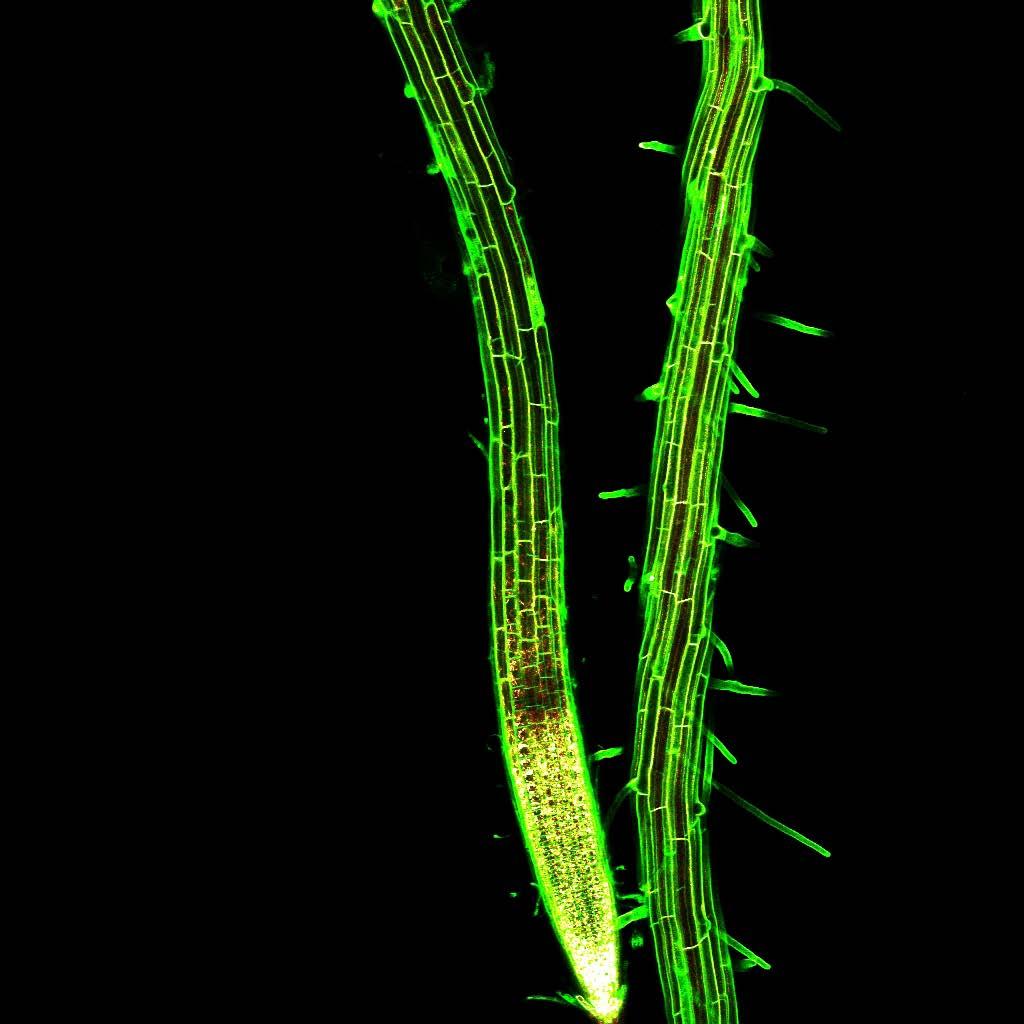
rely on advanced microscopy techniques, such as confocal microscopy and SEM-based 3D nanometreresolution imaging, which allow them to study the morphology and dynamics of vacuoles up close. ‘These imaging methods allow us to visualise vacuolar structures with high precision and detail, providing insights into their organisation and dynamics within plant cells,’ he says. ‘Particularly, confocal imaging is an invaluable tool for studying the 3D structure and dynamics of cellular organelles like vacuoles in living plant tissues.’ Additionally, the team relies on molecular biology techniques to manipulate gene expression and protein levels. ‘This includes genetic modification of model plants like Arabidopsis thaliana as well as gene knockdown or overexpression experiments using transgenic approaches,’ he says. ‘These molecular tools allow us to investigate the function of specific genes and proteins involved in vacuolar regulation and signalling pathways.’
For Jurgen, there is still plenty to learn about these intracellular relationships, as well as the vacuole’s other important roles. ‘Besides understanding how vacuoles help plants grow in a diverse set of conditions, the vacuole plays a major role in water-use efficiency as well as managing cellular nutrient homeostasis,’ he says. ‘By unravelling the intricate mechanisms governing vacuolar regulation and cellular growth coordination, we contribute to the broader knowledge of cell biology and signalling networks.’
VACUOLES KEEP IT FLEXIBLE
One of the wonders of cell biology is the opportunity to explore the fundamental rules by which organic
Above:
Root tip cells showing high levels of growth due to vacuolar size changes
Photo credit: David Scheuring
Right:
Root tip cells showing high levels of growth due to vacuolar size changes
Photo credit: David Scheuring
life must abide, but some rules are not as static as you may think. ‘For me, it’s intriguing that even small changes on the cellular level can have an impact on the entire plant,’ says David Scheuring, research group leader in the field of plant cell biology at the University of Kaiserslautern-Landau in Germany. ‘This is why I started my own research group, investigating regulation of vacuolar morphology.’
During David’s PhD, he was working on vesicle trafficking towards the vacuole and soon became fascinated by the relatively large size of the organelle within the plant cell. ‘In the tobacco mesophyll protoplast I was working on, it occupied more than 90% of the cellular space,’ he explains. Following this, during a postdoctoral position in Austria, he learned more about the role of vacuolar size in cell elongation and plant growth. ‘This allows cells to expand without the need to generate large amounts of cytosolic matter and is especially important in rapidly expanding tissue, such as the root tip or pollen tube,’ he explains. ‘Restricting vacuole size thus represents an efficient mechanism to inhibit cell size and, eventually, plant growth.’
By combining genetics, through CRISPR mutagenesis and overexpression, with high resolution and super-resolution microscopy, David is able to pull structural insights from 3D-rendered models of vacuoles and their respective cells. One of the most impactful findings for David has been that cellular organelles are actually very dynamic and are not as fixed as some may believe. ‘During my PhD, we demonstrated that early endosomes (trans-Golgi network) mature into late endosomes (multivesicular bodies) by protein sorting and this was certainly a key finding,’ he says. Soon after this, David started working on the vacuole and was fascinated by its
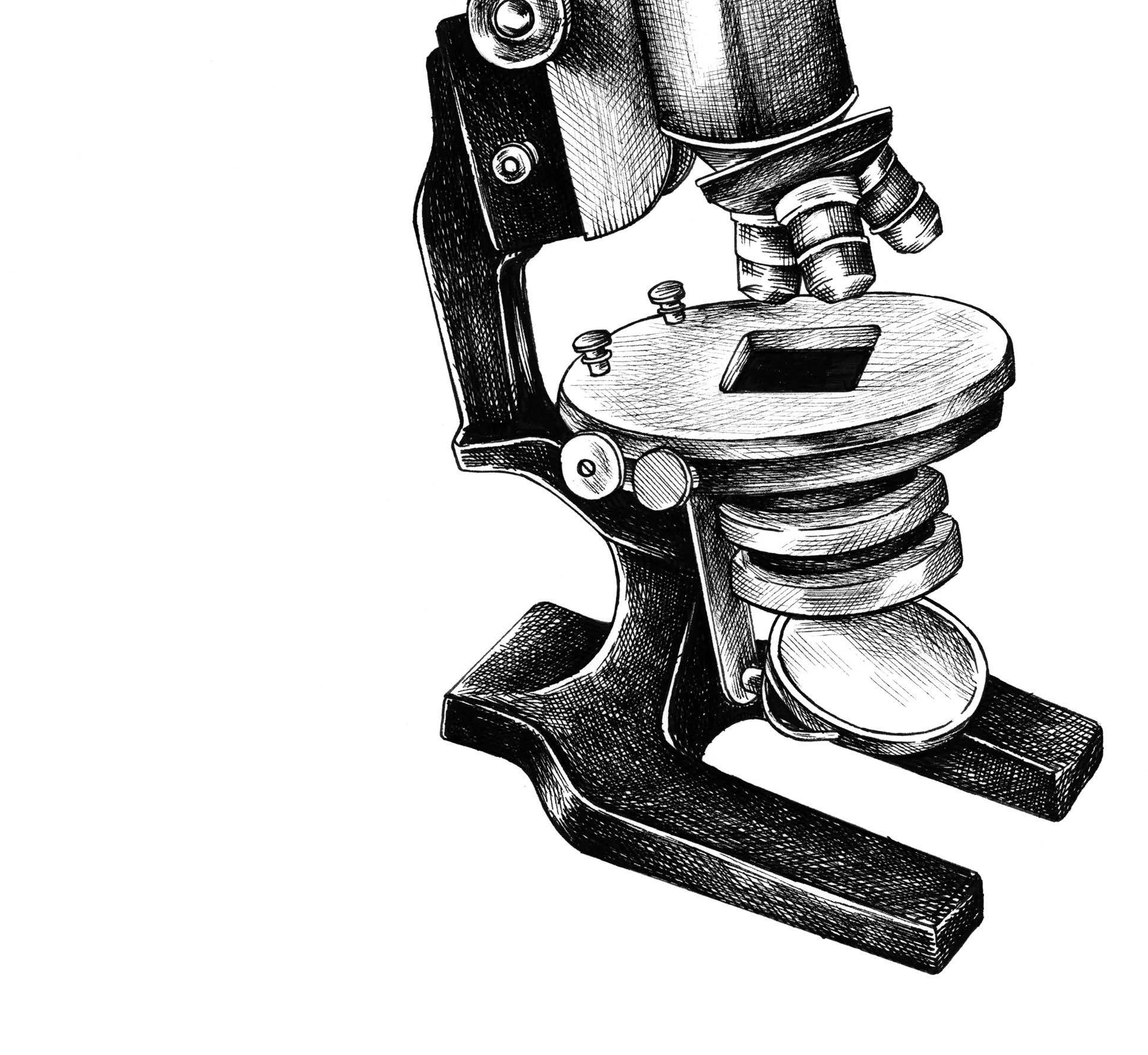
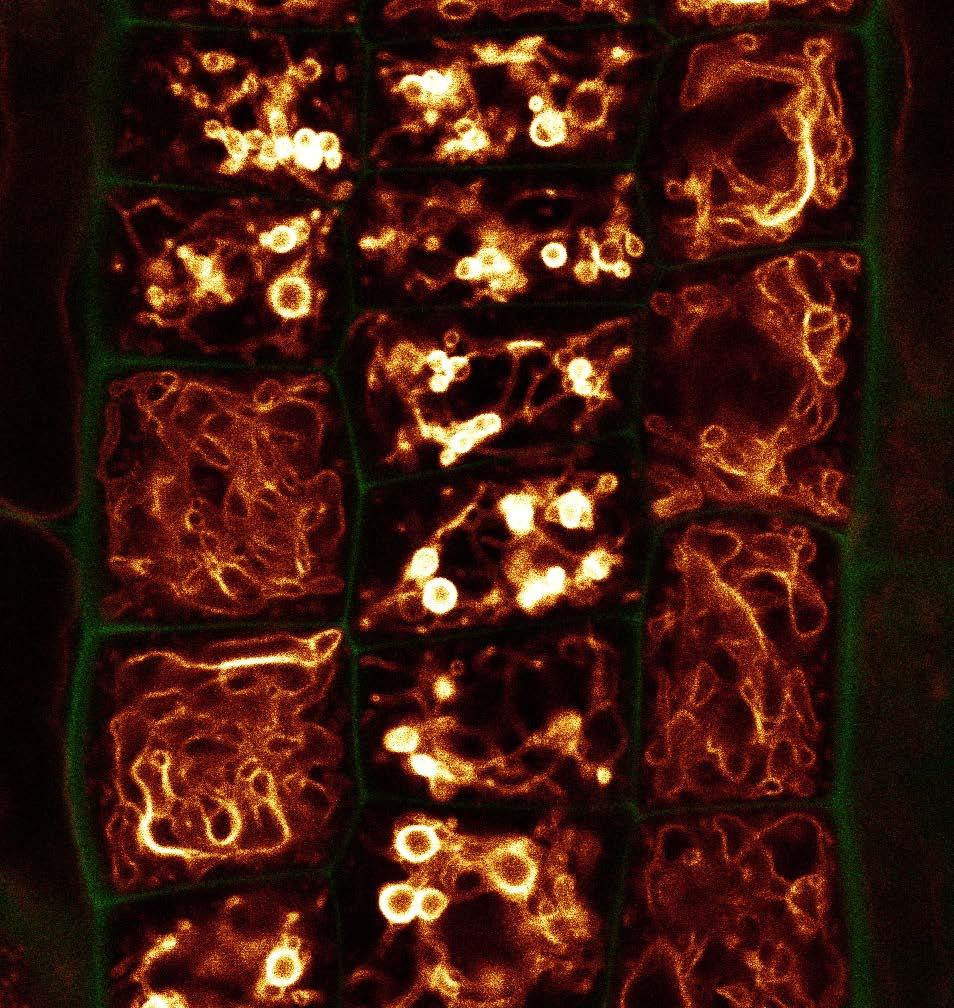
One additional aspect of David’s work hasinvestigated the family of Networked proteins (NETs) that connect different organelles to actin filaments, and appear to play important roles in vacuole formation and the establishment of membrane contact sites between vacuoles and the endoplasmic reticulum. ‘The finding that NET3 and NET4 both interact with the same proteins although they are localised to the endoplasmic reticulum and the vacuole respectively was very surprising for me,’ he says. ‘I think that this might contribute to the cellular flexibility and plasticity of plant growth.’
Finally, David shares an update on where his research has led him thus far. ‘Recently, we found that signalling for growth regulation and response to environmental stresses might use entirely different pathways; however, the plant hormone salicylic acid impacts both processes,’ he says. ‘We plan to extend our findings here and the ultimate goal would be to generate more robust plants without any growth penalties.’ With an eye for the next step for his research, David is keen to keep exploring the delicate balance between cellular and subcellular growth, and the stress responses. ‘At the moment we are characterising plant responses against biotic stress, using the pathogenic fungus Botrytis as a model organism,’ he says. ‘In the future, I would like to explore how different processes are targeted by using the same stimulus, such as salicylic acid.’
THE VERSATILE PLANT VACUOLE
BY CAROLINE WOOD
In school biology textbooks, plant cell vacuoles are typically reduced to little more than fluid-filled sacs that control turgor pressure. But plant scientists are increasingly revealing key roles for the vacuole in a diverse range of functions, from defence and stress adaptation, to nutrient cycling and cellular repair. Caroline Wood takes a look at recent studies published in the SEB’s journals which highlight the importance of this often-underappreciated organelle.
ENGINEERING VACUOLES FOR ENHANCED PHOSPHOROUS
RECOVERY
Phosphorous plays a critical role in our food systems, with about 82% of the phosphorous mined globally used to make fertilisers. However, release of phosphorous into the environment from industrial wastewater, sewage and agricultural run-off has devastating impacts on ecosystems, such as promoting harmful algal blooms. Furthermore, with phosphorous being a finite and nonrenewable resource, these significant losses into the environment could potentially threaten future food security.
Clearly, effective phosphorous recovery strategies are urgently needed; however, conventional treatment processes are highly energy-intensive. An attractive alternative is to use organisms that can accumulate phosphorous, such as bacteria and algae. But although bacteria-based systems have been used successfully to remove phosphorous from wastewater, these typically have high carbon and nitrous oxide emissions, with the recovered phosphorus being difficult to reuse easily.
According to Keke Yi (Chinese Academy of Agricultural Sciences), algae could be a much more promising candidate. ‘Algae preferentially absorb and use phosphorous as inorganic phosphate and
they store any excess as polyphosphate compounds in algal vacuoles,’ he explains. ‘They offer an attractive nutrient-removal alternative because they grow fast, use nutrients in wastewater, have low operating costs and produce biomass suitable for algae-based fertiliser production.’ But up to now, algae-based phosphorous removal systems have been hampered by low efficiency and low phosphorous-accumulation capacity. However, as Keke’s team have demonstrated, genetic engineering approaches could soon overcome these challenges.
‘In the algae Chlamydomonas reinhardtii, phosphorous-deficiency responses are regulated mainly by the transcription factor phosphate starvation-responsive 1 (PSR1), so we hypothesised that inducing continuous phosphorous-starvation signalling by overexpressing PSR1 could enhance the efficiency of phosphorous uptake,’ Keke says. ‘To enhance the capacity of phosphorous accumulation, meanwhile, we proposed to knock out the phosphate transporter C1 (PTC1) gene, because our group recently discovered that disabling this gene in C. reinhardtii causes phosphorous to accumulate in the vacuoles.’1
To investigate this, Keke’s group combined knocking out PTC1 and overexpressing PSR1 in a single C. reinhardtii strain, then tested the ability of the engineered strain to remove phosphorous from wastewater collected from a chemical plant.2 ‘Measuring the residual phosphorous in the wastewater showed that the engineered strain removed 97% of the total phosphorous from
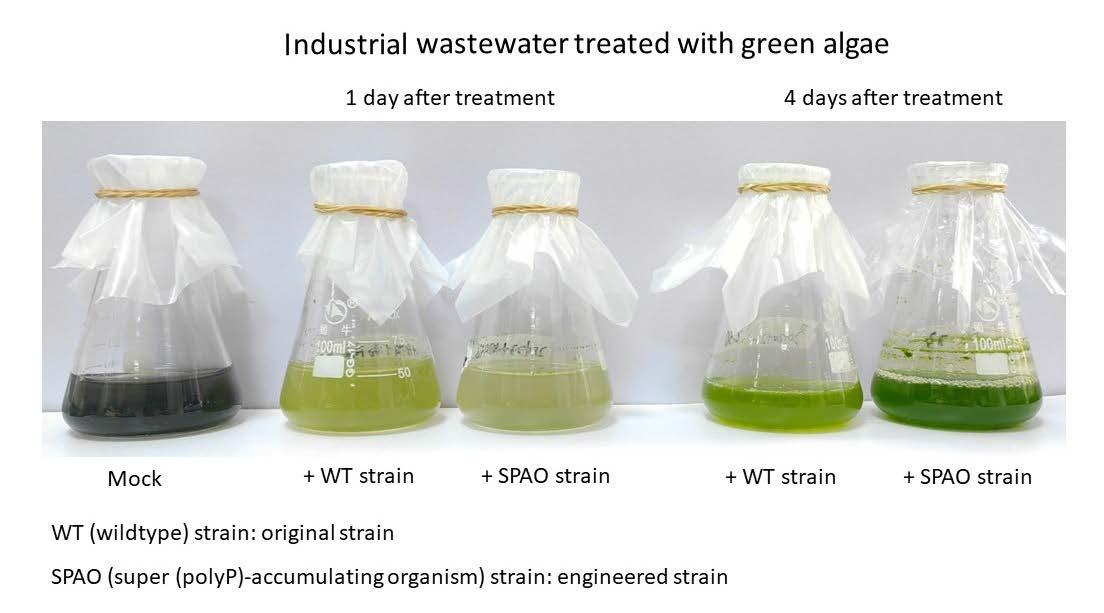
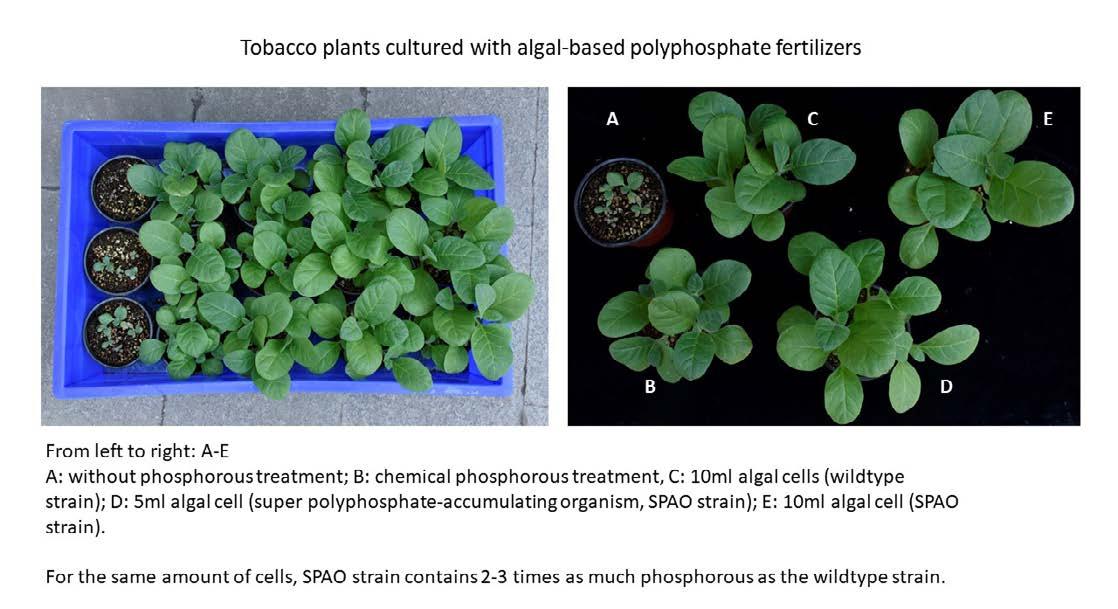
the wastewater after 60 hours, and it recovered all the phosphorous within 72 hours,’ Keke says. In contrast, a wild-type strain only succeeded in removing around 65% of the phosphorous from the wastewater. Furthermore, the engineered strain enhanced C. reinhardtii’s phosphorous-storage capacity to around 7% dry biomass—the highest phosphorous concentration in plants to date.
Besides showing clear promise for phosphorous removal, the engineered strain also proved to be an effective algal-based fertiliser. ‘We found that tomato plants treated with the powdered engineered algal cells as the only phosphorus resource showed enhanced growth performance and greater biomass compared with plants treated with a chemical phosphorous fertiliser or powdered wild-type algal cells,’ says Keke. ‘These results support the growing interest in algal fertiliser as an environmentally friendly, pollution-free alternative, owing to the tremendous potential to immobilise nutrients in the vacuole, then make them bioavailable through controlled release. With phosphorous signalling and accumulation pathways being conserved across green algae, we envisage that a broad range of genetically engineered microalgae could be developed into tailored solutions that combine phosphorous recovery with a slow-release fertiliser.’
THE VACUOLE AS A DEFENSIVE ARSENAL
with enhanced disease resistance, because vacuoles can act as a repository of secondary metabolites, including defensive compounds. ‘Under normal conditions, these toxic compounds are stored in the vacuole in a nonfunctional form,” says Wangsheng Zhu (China Agricultural University). ‘For example, defensive benzoxazinoid compounds are hydroxylated to form glycosides that are stored in the vacuole. But when the plant cell is damaged during a stress condition, the vacuole will be ruptured and these stored defensive metabolites will be activated and released. Therefore, plant vacuoles can be regarded as “arsenals” for responding to biotic and abiotic stresses, providing plants with a large and continuous supply of ammunition.’
According to Wangsheng, this natural arsenal could serve as a starting point to address some of the most devastating plant pathogens. His own interest focuses on diseases affecting maize, one of the most important crops for food, livestock feed and energy production. ‘Worldwide, the estimated loss in maize production due to disease and insect pests is estimated to be around 15%,’ he says. ‘One of the most damaging of these is corn stalk rot: a soil-borne disease caused by Pythium pathogens.’
Recent years have seen ‘vacuole engineering’ also become a promising avenue for developing crops
MEASURING THE RESIDUAL PHOSPHOROUS IN THE WASTEWATER SHOWED THAT THE ENGINEERED ALGAL STRAIN REMOVED 97% OF THE TOTAL PHOSPHOROUS FROM THE WASTEWATER AFTER 60 HOURS
In a recent genome-wide association study, Wangsheng’s research group identified ZmBGLU17, which encodes a -glucosidase enzyme, as a new disease-resistance gene for maize stalk rot.3 By carrying out confocal microscopy on fluorescently tagged lines, they established that ZmBGLU17 localised to the vacuole and apoplast. ‘We hypothesised that ZmBGLU17, as a vacuolar glucosidase, may function to activate defensive glycoside compounds upon cell rupture during pathogen attack,’ says Wangsheng. To investigate this, the group engineered ZmBGLU17overexpression maize lines and found these contained significantly higher levels of 2,4-dihydroxy7-methoxy-1,4-benzoxazin-3-one (DIMBOA), a defensive benzoxazinoid metabolite normally sequestered in the vacuole as a glycoside. ‘In field trials, these ZmBGLU17-overexpression lines had a significantly lesser stalk rot disease phenotype than control lines, indicating that the accumulation of DIMBOA enhanced resistance to Pythium pathogens.’
Interestingly, apoplast-located ZmBGLU17 appeared to be associated with lignin formation, with ZmBGLU17-overexpression lines showing enhanced lignin accumulation in the cell wall. ‘This made us wonder if ZmBGLU17 could also bolster resistance to insect pests,’ says Wangsheng. ‘So, we tested the plants in a feeding assay using the Asian corn borer Ostrinia furnacalis.’ The larvae fed with leaves from ZmBGLU17-overexpressing maize were significantly smaller than those fed with leaves from wild-type plants, indicating that ZmBGLU17, by increasing lignin accumulation, offers protection against piercing-sucking and chewing insect pests. ‘In addition, DIMBOA is also a good defence metabolite against corn borer and aphids,’ adds Wangsheng. ‘Therefore, ZmBGLU17
PLANT VACUOLES CAN BE REGARDED AS ‘ARSENALS’ FOR RESPONDING TO BIOTIC AND ABIOTIC STRESSES, PROVIDING PLANTS WITH A LARGE AND CONTINUOUS SUPPLY OF AMMUNITION
Above:
Comparison of industrial wastewater samples treated with a wildtype algae and an algae strain engineered to accumulate phosphate more efficiently.
Comparison of tobacco plants cultured with chemical and algalbased polyphosphate fertilizers.
Photo credit: Xianqing Jia.
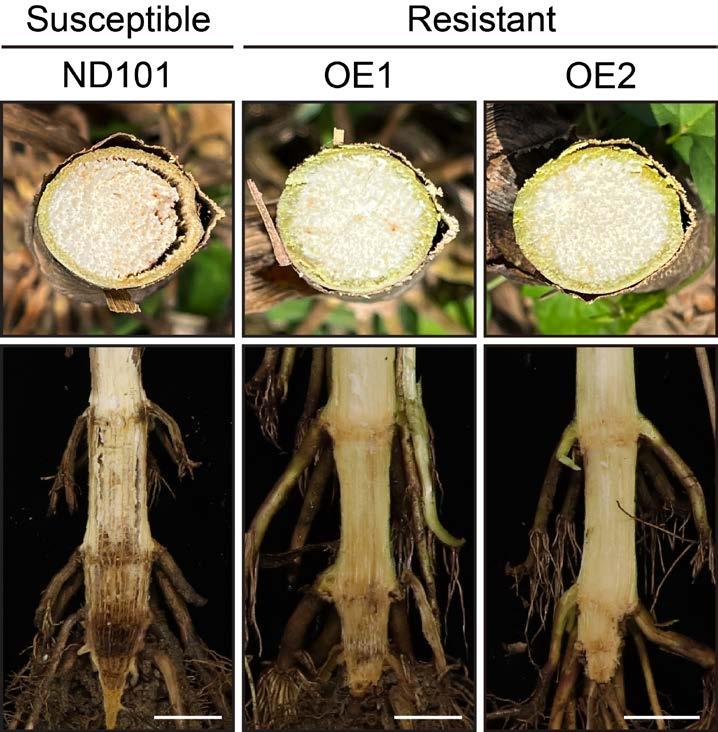
is an ideal candidate gene for breeding maize that are resistant to disease and a broad variety of insect pests.’
Importantly, overexpressing ZmBGLU17 only slightly increased the level of DIMBOA, therefore avoiding the negative effects of excessive DIMBOA accumulation on plant growth. ‘This was confirmed in our field trials, which found that ZmBGLU17overexpressing maize demonstrated normal growth and a similar yield to control lines,’ says Wangsheng. ‘Overall, this indicates that ZmBGLU17 is an ideal disease-resistance gene, conferring broad-spectrum resistance without a yield penalty.’
‘We are now planning to use gene editing technology to generate ZmBGLU17-overexpression lines in multiple cultivated varieties,’ he adds. ‘In addition, we would like to verify the function of the homologous gene of ZmBGLU17 in other Poaceae crops, such as rice, wheat and sorghum, and test whether ZmBGLU17 can be applied in different crops for pathogen resistance.’
THE VACUOLE AS A SOPHISTICATED DEGRADATION AND RECYCLING MACHINE
Besides being a source of compounds for selfdefence, plant vacuoles can also be a force for self-destruction. For instance, during programmed cell death, hydrolases from the vacuole are released into the cytoplasm, resulting in the full-scale degradation of cellular components. But degradation can also be highly selective: in the process of autophagy, specific cellular components become sequestered within double-membraned structures (autophagosomes) which then fuse with the central vacuole to be broken down by proteases. New research is revealing autophagy to be an exquisitely regulated process, and one that plays a key role in diverse functions, from nutrient regulation to seed and root development.
‘The past few years have seen selective autophagy emerge as a vital process in plants, functioning like a precise cleaning crew within cells to target specific cellular components for degradation,’ says Clelia De-la-Peña (CICY, Unidad de Biotecnología, México), who led a recent review of autophagy for The Plant Journal.4 ‘This process is crucial for recycling nutrients, especially under starvation conditions, maintaining cellular health by removing dysfunctional organelles, and helping cells adapt to various stresses.’
called Rubisco-containing bodies. These travel through thin tubular extensions of the chloroplast that project into the cytoplasm, before being released and travelling to the vacuole. ‘The formation of Rubisco-containing bodies is a complex process that probably serves more than one purpose,’ says Clelia. ‘These functions may include controlling the quality of proteins, adapting to stress, allocating resources and controlling autophagy. More research is needed to fully understand the exact mechanisms and control pathways that help Rubisco-containing bodies form and work in plant cells.’
AT THE CORE OF SELECTIVE AUTOPHAGY IS ITS DYNAMIC INTERACTION WITH DIVERSE SIGNALLING PATHWAYS, WHICH FINELY TUNE THE AUTOPHAGIC ACTIVITY TO A HIGH LEVEL OF PRECISION
According to Clelia, the vacuole’s ability to recognise and take in such a diverse range of autophagy cargo demonstrates how important it is for keeping cells in balance, recycling resources, controlling important cellular processes and adapting to stress. ‘Enhanced understanding of selective autophagy could revolutionise agricultural practices by developing crops that are more resilient to environmental stresses and diseases,’ she adds. ‘By developing crops that can better manage and use their cellular resources, we can enhance their stress tolerance, increase yields and ultimately contribute to global food security and sustainable agricultural practices.’
The process is both highly dynamic and tightly controlled, as Clelia explains: ‘As plants encounter various stress factors such as drought, salinity and pathogen attacks, selective autophagy adjusts its mechanisms accordingly to maintain cellular homeostasis and prevent unnecessary loss of essential cellular machinery. At the core of selective autophagy is its dynamic interaction with diverse signalling pathways, which finely tune the autophagic activity to a high level of precision.’ For instance, there are distinct degradation pathways for different cellular components, including proteins, the endoplasmic reticulum, peroxisomes, ribosomes and mitochondria.
Clelia’s research focuses on the interactions between genes and specific receptors that facilitate chloroplast degradation (chlorophagy), aiming to understand how plants manage and recycle chloroplast components under stress conditions. ‘Chlorophagy is a particularly finely balanced system, which befits the fact that these organelles are responsible for capturing solar energy and driving the process of photosynthesis,’ she says. ‘In addition, chloroplasts also serve as major stores of protein, accounting for 50–75% of total protein and nitrogen contents in leaves.’
Consequently, chlorophagy exhibits some unique forms of degradation. For example, during senescence and under specific biotic and abiotic stress conditions such as high-light exposure, carbon starvation and bacterial pathogens, Rubisco (a critical enzyme involved in CO2 fixation) can become sequestered within specialised autophagosomes
A MODEL SYSTEM FOR PLANT SCIENCE IN OUTER SPACE
Besides agriculture on Earth, the vacuole is attracting interest for an even more ambitious application: growing crops in outer space. ‘Growing healthy plants in microgravity will be a requirement for long-term missions in space, but this poses a multitude of stresses on plant growth,’ says Marcela RojasPierce (North Carolina State University, USA). ‘For instance, plants grown on the International Space Station (ISS) demonstrate profound changes in gene expression, protein abundance and directional growth. Understanding how microgravity causes these effects is essential if we are to design plant growth systems that will ensure a reliable food supply.’
Marcela’s research has demonstrated that plant vacuoles could act as a perfect model to systematically investigate the impacts of microgravity on plants—and how these could be mitigated. ‘Previous studies led by Elison Blancaflor (NASA Kennedy Space Center) showed that Arabidopsis root cells grown at the ISS had more and enlarged vacuoles compared with plants grown on Earth.5 These observations—and the prominent size of plant vacuoles—made us realise they could be ideal models to study organelle dynamics in space.’
‘We hypothesised that alterations in vacuole fusion events were responsible for this enhanced
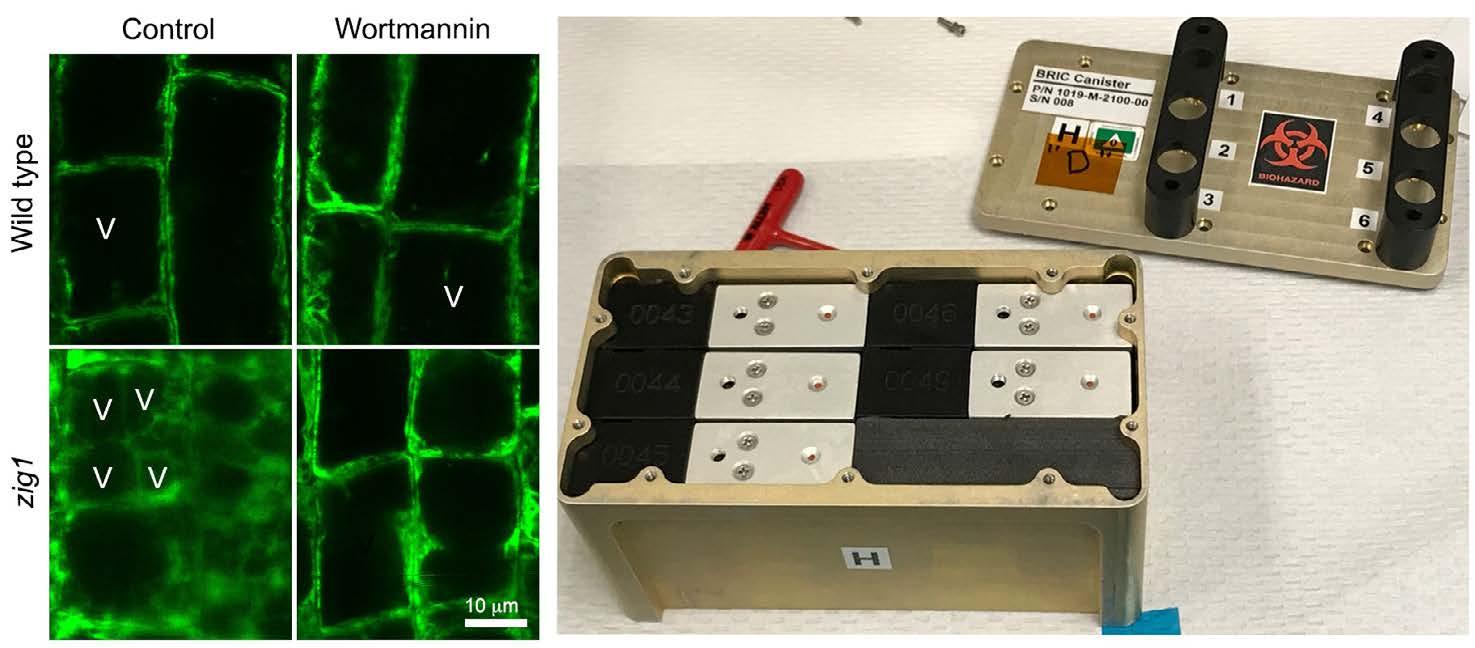
vacuolation. This is because the central vacuole grows concomitantly with the cell when smaller vesicles fuse with it,’ she adds. ‘So, we sought to develop a test to investigate whether membrane fusion could be altered by microgravity.’6 To do this, the group used the Arabidopsis zigzag-1 (zig1) mutant, which has a fragmented vacuole phenotype because it lacks a crucial component of the SNARE complex that mediates vesicle fusion. However, the wild-type phenotype can be partially restored in zig-1 when treated with the chemical inhibitor wortmannin (WM), meaning that the number of vacuoles in WMtreated zig-1 plants can be used as a proxy for vacuole fusion events.
PREVIOUS STUDIES SHOWED THAT ARABIDOPSIS ROOT CELLS GROWN AT THE INTERNATIONAL SPACE STATION HAD MORE AND ENLARGED VACUOLES COMPARED WITH PLANTS GROWN ON EARTH. THIS MADE US REALISE THAT VACUOLES COULD BE IDEAL MODELS TO STUDY ORGANELLE DYNAMICS IN SPACE.
Marcela’s team first engineered control and zig-1 Arabidopsis plants to express a green fluorescence protein (GFP) tag which specifically targeted the vacuoles. The seeds were then sent to the ISS in Petri Dish Fixation Units, specially designed to enable astronauts to apply preloaded chemical solutions to the plants under microgravity conditions. Four days after germination, the seedlings were treated with WM, then chemically
fixed in formaldehyde 2 hours later. On their return to Earth, the samples were analysed using confocal microscopy and compared with ground controls.
The results revealed that root cells of zig-1 plants grown in microgravity had an enhanced phenotype, with more vacuoles per cell. Furthermore, WMinduced vacuole fusion also appeared to be delayed by microgravity conditions. ‘We observed a higher number of vacuoles in the root cells of WM-treated zig-1 grown on the ISS when compared to the ground, suggesting a delay in zig-1 vacuole fusion during flight, says Marcela. ‘This demonstrates that this sensitised genotype can act as a model system to explore the effects of microgravity on a process as fundamental as membrane trafficking. Even so, I was surprised that vacuole fusion was not affected to a greater extent by microgravity because there are many cellular and tissue abnormalities associated with that stress, including alterations in the cytoskeleton, that we expected could affect the fusion of vacuoles.’
‘In addition to the main findings, this study resulted in a new protocol (developed by postdoctoral researcher Mengying Wang) for inhibitor treatment and tissue fixation in space that is compatible with preserving fluorescent proteins,’ she adds. ‘This enabled us to be the first to carry out a major confocal imaging assay after a flight experiment, and it opens up the possibility of tapping into a myriad of applications of GFP-fluorescence for studying how microgravity affects plant cell growth and function.’
If you are hungry for more innovative plant science research, make sure you join the SEB at the 2024 Annual Conference in Prague. The provisional programme (available on the SEB website) includes sessions on genomic and epigenetic plasticity in plants, plants’ responses to temperature fluctuations, translational plant biodiversity and novel mechanisms of receptor kinase activation in plants.
References:
1. Wang L, Jia X, Zhang Y, et al. Loss of two families of SPX domain-containing proteins required for vacuolar polyphosphate accumulation coincides with the transition to phosphate storage in green plantshttps://doi.org/10.1016/j. molp.2021.01.015. Mol Plant 2021; 14: 838–846.
2. Wang L, Jia X, Xu L, et al. Engineering microalgae for water phosphorus recovery to close the phosphorus cycle. Plant Biotechnol J 2023; 21; 1373–1382.
3. Liu C, He S, Chen J, et al. A dual-subcellular localized β‐
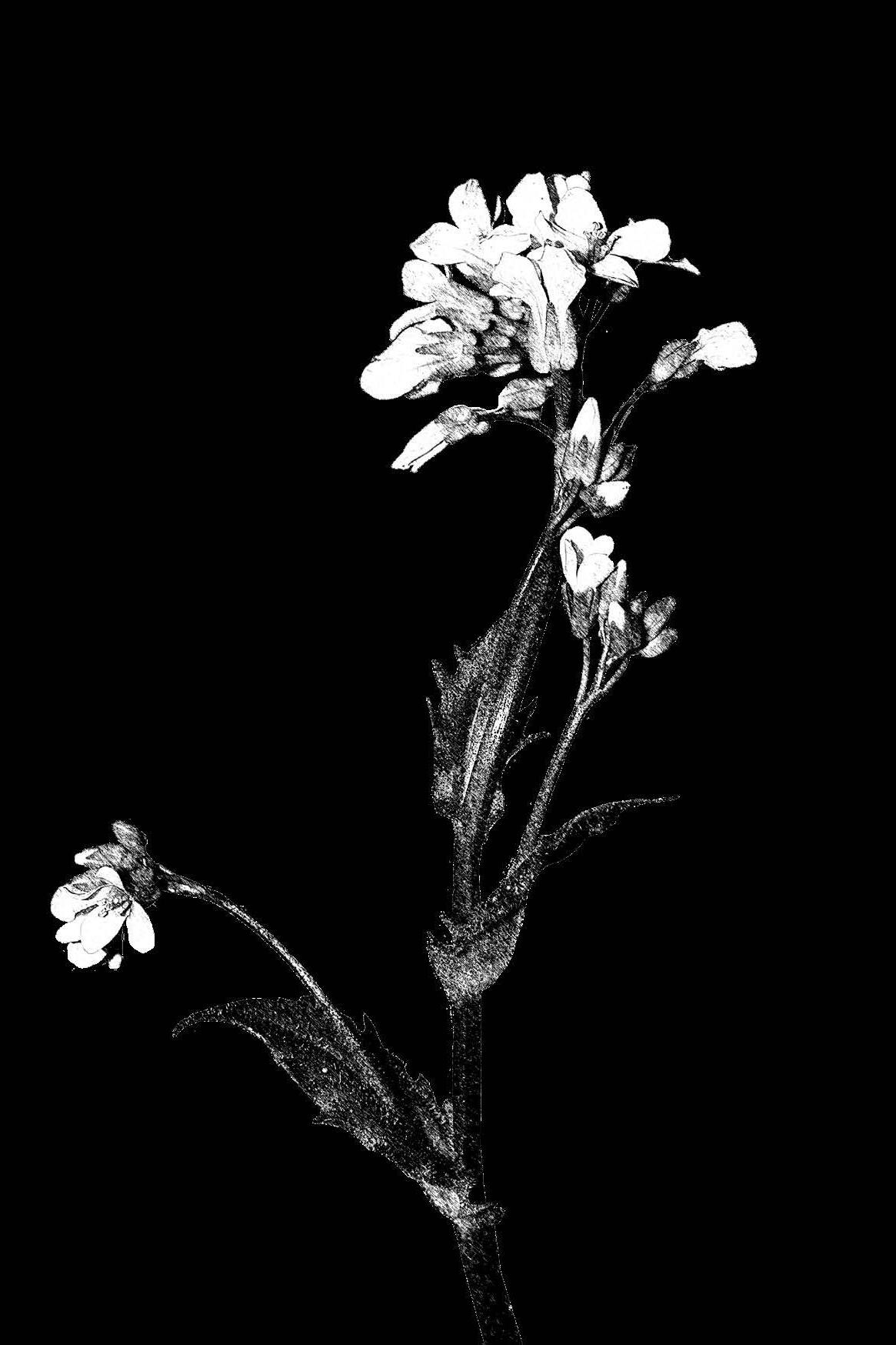
Mengying wang.
Opposite Page Top: Wildtype (ND101) and ZmBGLU17 overexpression (OE1 and OE2) maize lines infected by Pythium aphanidermatum, which causes maize stalk rot. ZmBGLU17 overexpression lines contain significantly higher levels of lignin and the defensive benzoxazinoid metabolite DIMBOA (2,4-dihydroxy-7-methoxy-1,4-benzoxazin-3one).
Photo credit: Liu, Chuang, et al. 2024
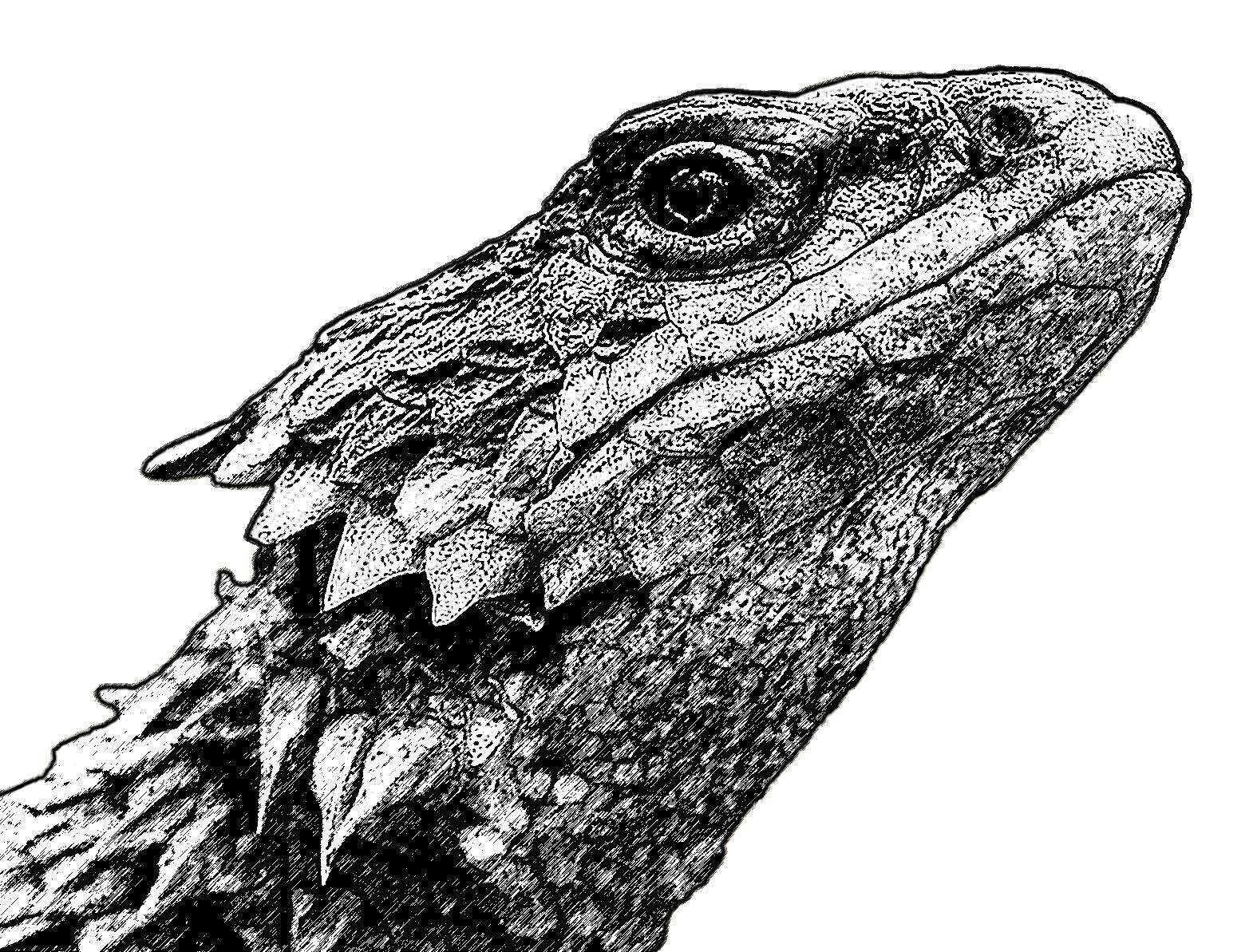
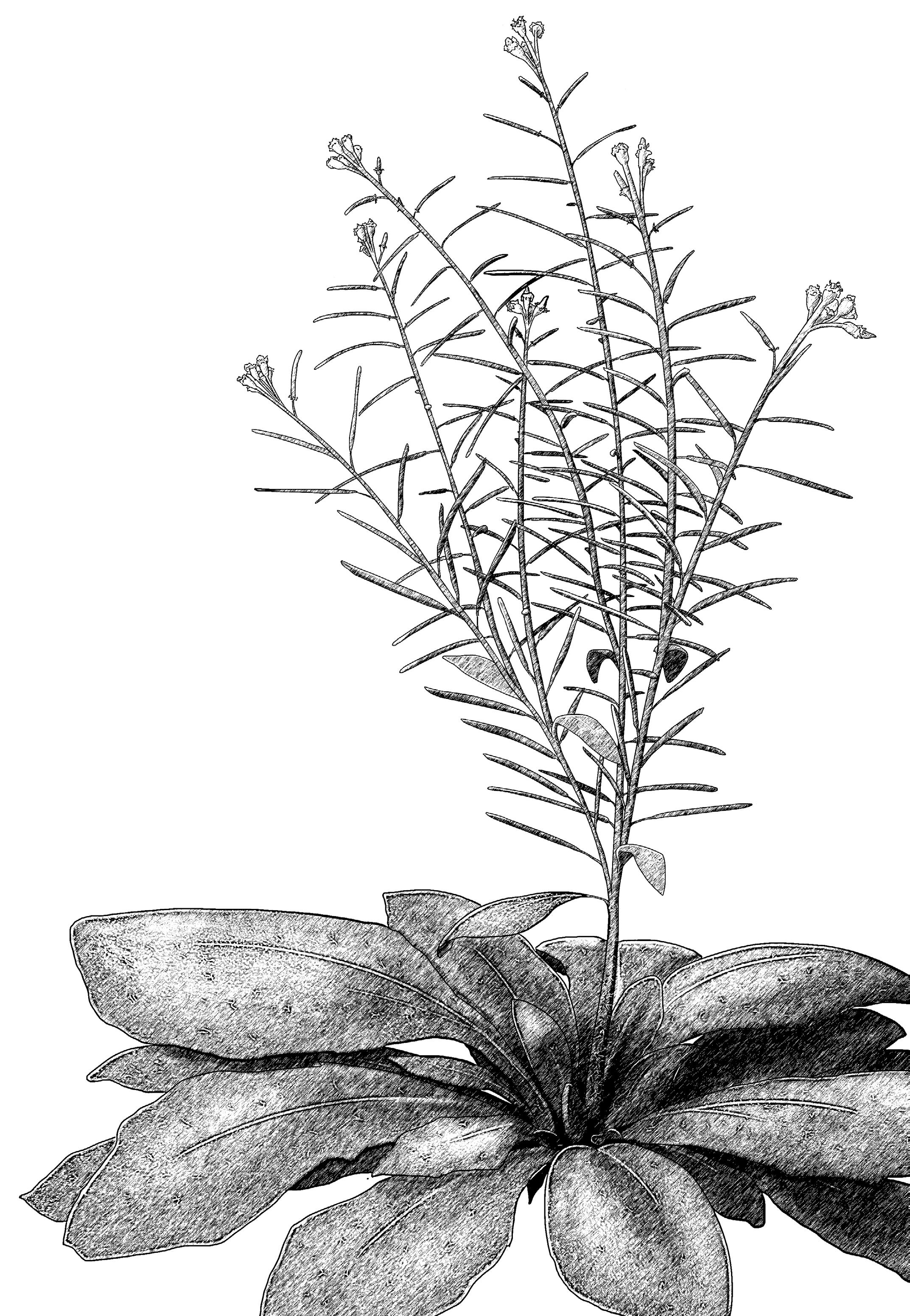
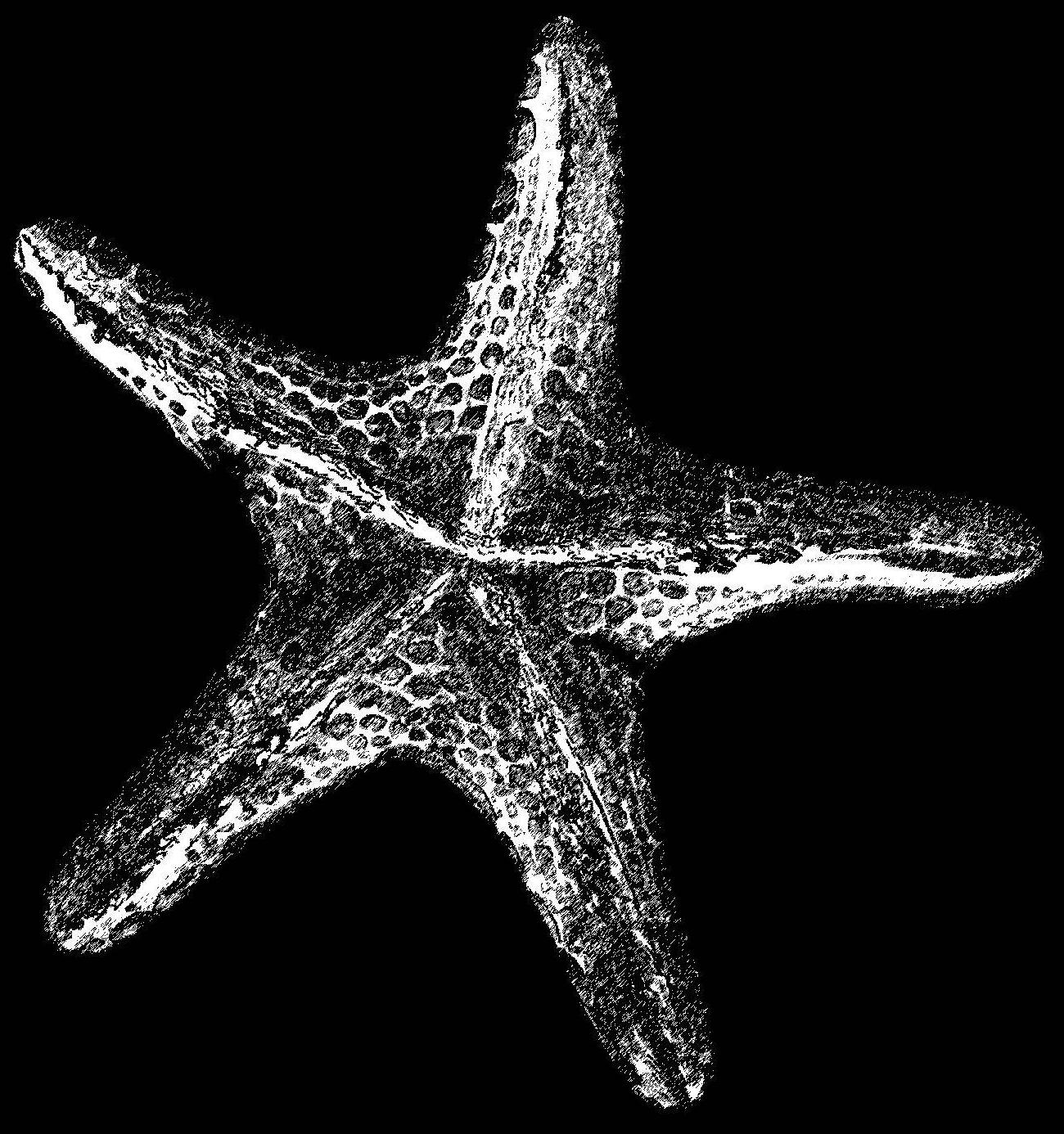
MEET OUR 2024 PRESIDENT MEDALISTS
This year’s awards were presented at the SEB Conference 2024.
Many congratulations to our very worthy winners of the 2024 SEB President’s Medal awards
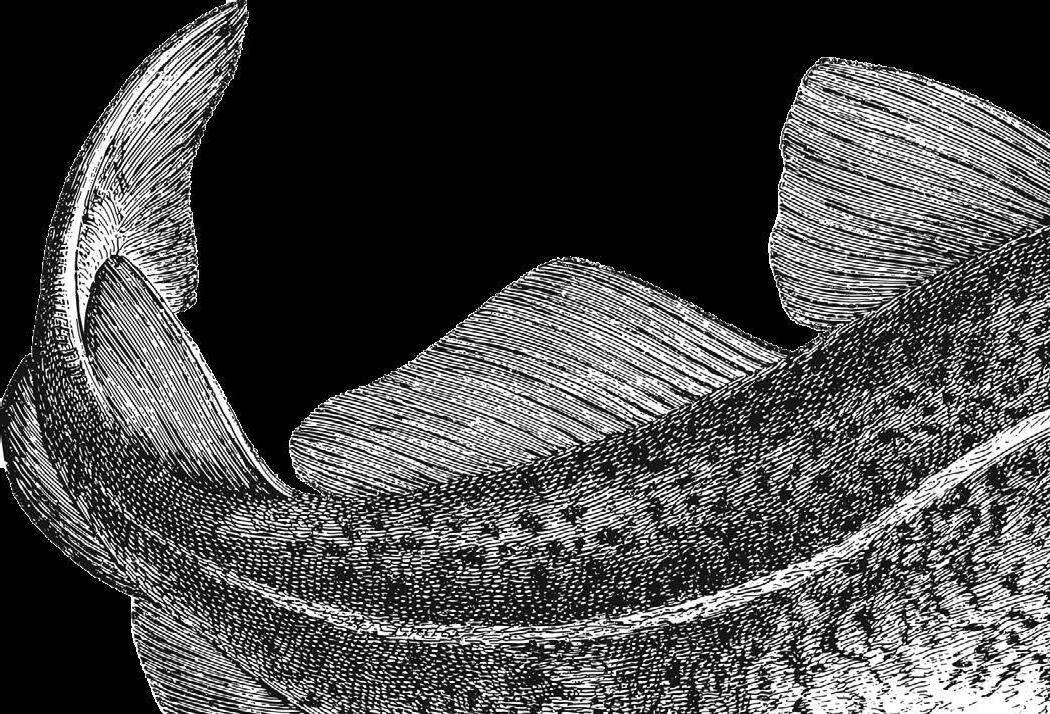
TOMMY NORIN (DTU AQUA)
Animal Biology Section

Tommy is an experimental animal ecological physiologist working with aquatic ectotherms, primarily fish. His research is focused on understanding the functional and ecological consequences of variation in whole-animal metabolic rate, especially variation among individuals within species, and how this variation interacts with the environment to determine responses to environmental and climate change. Among other things, his work has shown how variation in metabolic rate – both on its own and through its scaling relationship with body mass – can shape the performance of individuals through interactions and trade-offs with food intake and growth, behaviour, and differential sensitivity to environmental temperature, salinity, and oxygen availability.
Tommy received his PhD in 2014 from the Section for Zoophysiology at Aarhus University in Denmark, after which he did three postdocs at Memorial University of Newfoundland in Canada, the University of Glasgow in Scotland, and at the National Institute of Aquatic Resources (DTU Aqua) in Denmark. Tommy is now a Senior Researcher at DTU Aqua..
MOOTAZ SALMAN
(UNIVERSITY OF OXFORD)
Cell Biology Section

Mootaz is a Group Leader in Cellular Neuroscience and MRC Career Development Fellow. He is interested in investigating mechanisms of blood-brain barrier (dys)function in neurodegenerative diseases using patient-derived stem cells, gene editing (CRISPR-Cas 9) and organ-on-a-chip technologies.
After graduating with a Bachelor of Pharmacy with Honours (BPharm(Hons)) from the University of Mosul, he studied for Masters and Doctoral degrees at Sheffield Hallam University, investigating the mechanisms of brain water transport where he discovered a novel pharmacological framework for developing drugs to treat traumatic brain injuries and stroke.
He held his postdoctoral fellowship at Harvard Medical School and Boston Children’s Hospital where he spent 3 years. During this time, he developed 3D in vitro models to investigate mechanisms involved in improving the effectiveness of therapeutic antibodies for Alzheimer’s disease in collaboration with Biogen.
He moved to Oxford and joined DPAG in late 2020, working on CRISPR/Cas9 genome engineering of human iPSC-derived neurons from Parkinson’s patients to investigate molecular disease mechanisms in collaboration with GSK. In 2021, he was awarded the Leverhulme Research Fellowship that enabled me to start his independent work and he became a Departmental Research Lecturer.
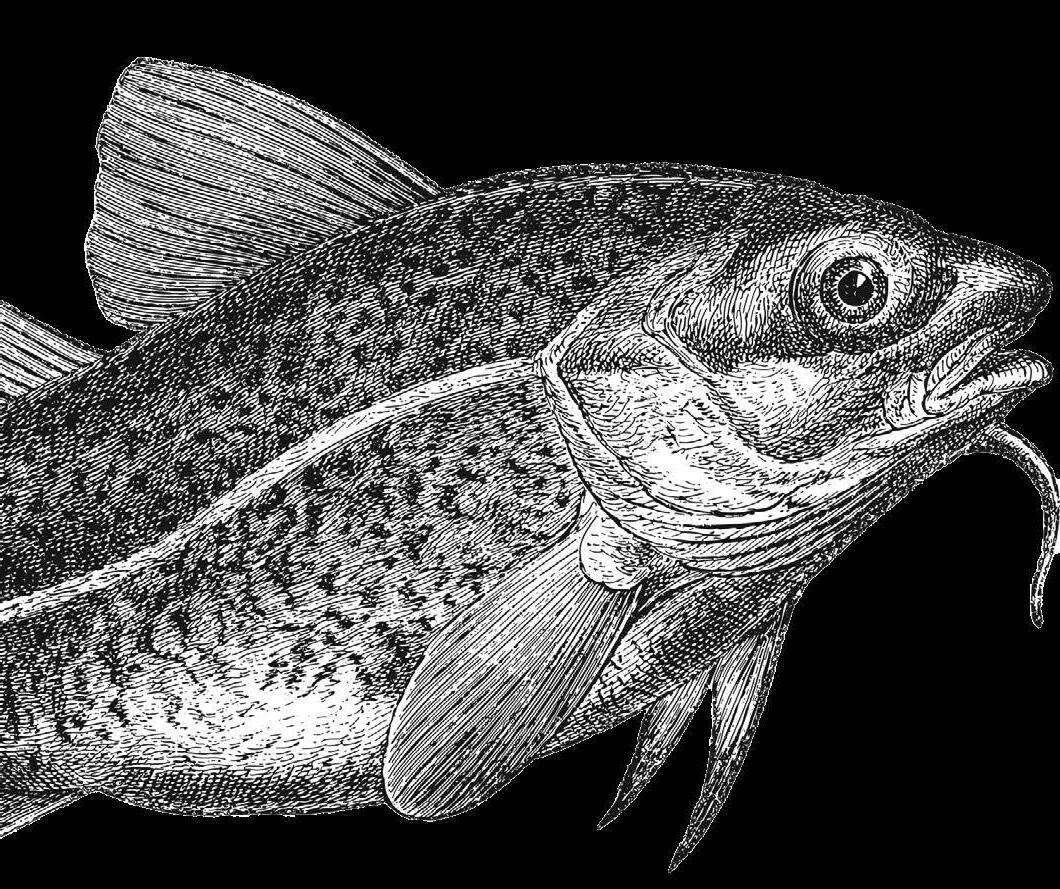
In 2023, he launched his research group at DPAG and Kavli Institute for Nanoscience Discovery, which is funded through my MRC Career Development Fellowship.
His group aims to investigate mechanisms of blood-brain barrier (dys)function in neurodegenerative diseases and brain injuries using patient-derived stem cells. They design and build innovative dynamic 3D multicellular in vitro model to accurately recapitulate the brain and BBB function under neuroinflammation and other neurodegenerativerelevant conditions..
PALLAVI SINGH (UNIVERSITY OF ESSEX)
Plant Biology Section

Pallavi grew up in India surrounded by rice fields and her grandfather’s mango orchards, sparking her interest in plants at an early age. She obtained her BSc (Botany, Chemistry) and MSc (Biochemistry) at University of Lucknow (India). In 2011, she was awarded the CSIR-Junior Research Fellowship to pursue a PhD at National Institute of Plant Genome Research, New Delhi (India), where she worked on defining MAPK signal transduction networks and submergence tolerance in rice. Pallavi’s PhD work has been recognised by INSA- and NASIYoung Scientist Awards (2019, 2017) from the Academy of Sciences in India. In October 2015, she joined Cornell University (USA), where her work on rice-xanthomonas interactions revealed a novel role of pathogenic TAL-effectors in bidirectional transcription in rice, contributing to the understanding of disease susceptibility. In 2017, Pallavi moved to University of Cambridge (UK) to work with Professor Julian Hibberd and was appointed the John Henry Coates Research Fellow at Emmanuel College in 2018. At Cambridge, her research focussed on transcriptional regulation of C4 photosynthesis.
Her work demonstrated that C4 plants utilise C3 ancestral gene regulatory networks to rewire C4 photosynthesis, marking a crucial conceptual advancement in comprehending the evolution of C4 photosynthesis. Moreover, her pioneering work on monocot grafting overturned the consensus dating back thousands of years that cereal and related species do not graft. These findings have provided a valuable research tool to explore plant physiology, genetics and inter-organ signalling in various cereal crop systems.
Since September 2022, Pallavi is a Lecturer at the University of Essex (UK). Her research group focuses on studying various aspects of water use strategies in crop plants. The lab aims to enhance photosynthetic productivity by concentrating on the complementary requirement to balance plant water supply with carbon gain, maximising water use efficiency. The overarching goal of their research is to develop more water-efficient crops and promote climate-smart agriculture.
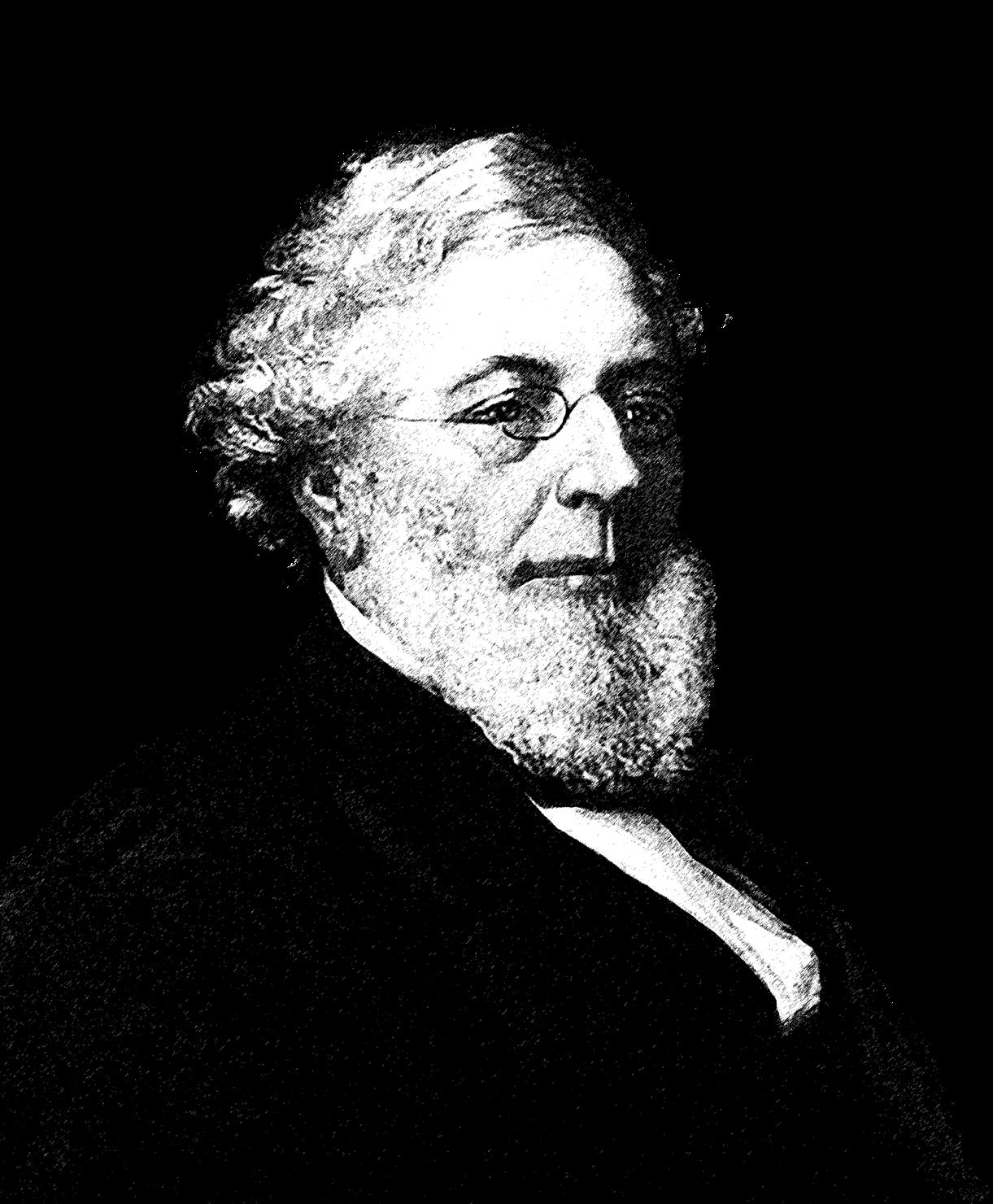
MEET OUR 2024 PLENARY LECTURERS WINNERS
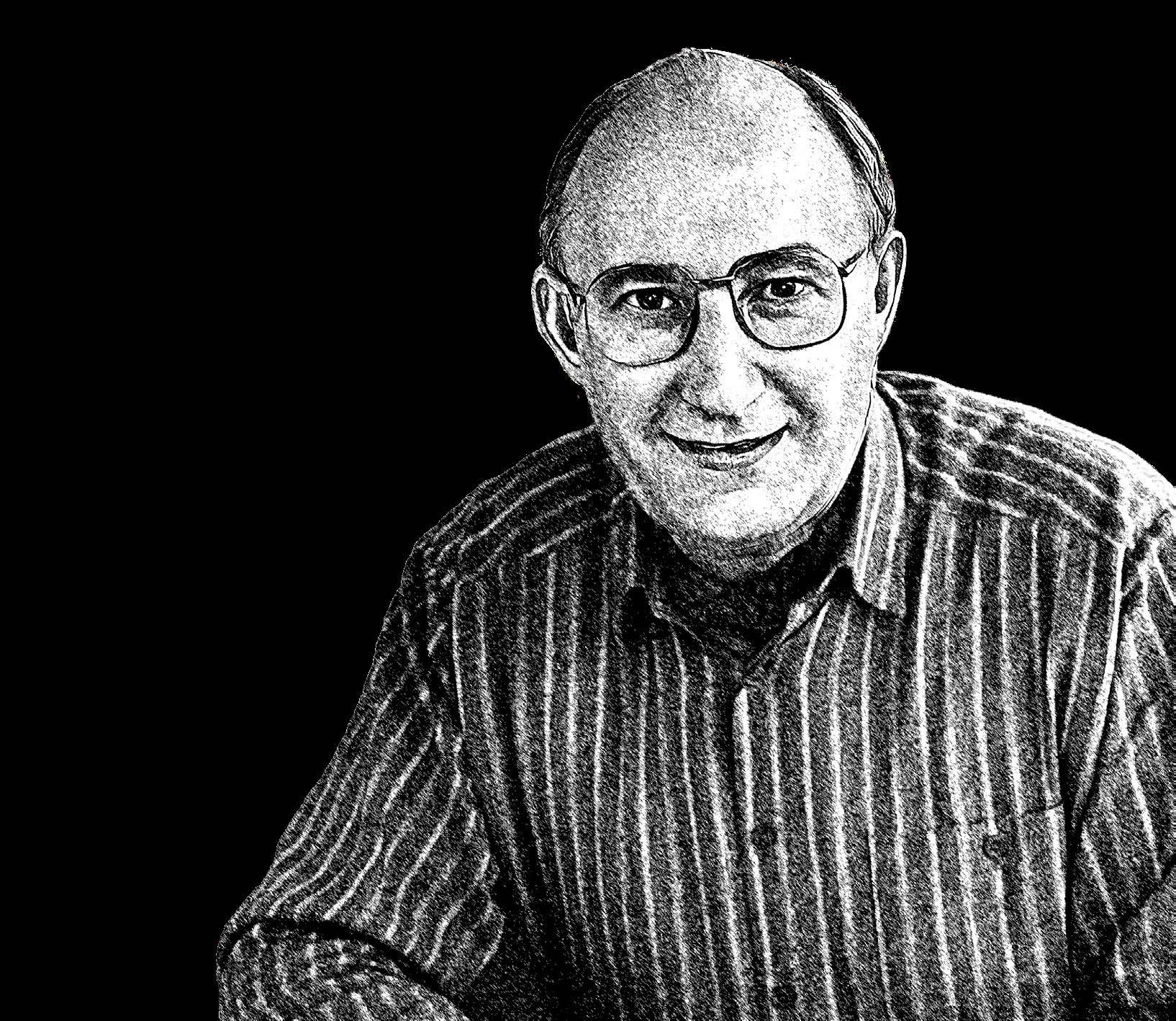
Each year at the Annual Conference of the SEB, the work of George Parker Bidder III and Harold Woolhouse are honoured with plenary lectures alongside the Cell Biology plenary lecture.
Lecturers are nominated by the committees of their respective sections and are given by prominent scientists in their fields of research.
IJEOMA FLORENCE UCHEGBU (UNIVERSITY COLLEGE LONDON)

of Professor at University College London (UCL). Recognized for her outstanding contributions to the field, she is a Fellow of the Academy of Medical Sciences and an Honorary Fellow of the Royal Society of Chemistry. Beyond her academic roles, Uchegbu serves as a governor on the board of Wellcome, a prominent biomedical sciences research charity. Additionally, she is a member of the Academy of Medical Sciences Council and serves as Chief Scientific Officer of Nanomerics Ltd., a company focused on developing medicines for sight-threatening illnesses.
In November 2023, Uchegbu was elected to the prestigious position of President of Wolfson College, University of Cambridge, a testament to her leadership and academic prowess. Her advocacy extends beyond academia; she has played pivotal roles, including Chair of the Academy of Pharmaceutical Sciences and Scientific Secretary of the Controlled Release Society. Notably, Uchegbu’s efforts as the UCL Provost’s Envoy for Race Equality led to significant institutional changes, such as the removal of the names of prominent eugenicists from UCL’s buildings in 2020.
As an inventor, Uchegbu has licensed medicines developed in her laboratory to Virpax Pharmaceuticals, furthering the impact of her research. Her innovative technologies have been recognized with prizes from esteemed institutions such as the Royal Society of Chemistry and the Royal Pharmaceutical Society, underscoring her significant contributions to pharmaceutical science.
SEUNG YON RHEE (MICHIGAN STATE UNIVERSITY)
Woolhouse Winner

Seung Yon Rhee is an esteemed Professor in the Department of Plant Biology at Michigan State University. With a background in biochemistry and molecular biology, her research primarily focuses on understanding the molecular mechanisms underlying plant metabolism and development. She earned her Ph.D. from Seoul National University and completed postdoctoral research at Michigan State University and the Carnegie Institution for Science.
Dr. Rhee has made significant contributions to the field of plant biology, particularly in elucidating metabolic pathways and their regulation. Her work involves utilizing interdisciplinary approaches, including bioinformatics, metabolomics, and synthetic biology, to unravel the complexities of plant metabolism. Through her research, she aims to enhance our understanding of how plants synthesize and regulate metabolites essential for growth, stress responses, and interactions with the environment.
In addition to her research endeavors, Dr. Rhee is committed to mentoring the next generation of scientists and fostering collaborative research efforts. She has received numerous awards and honors for her contributions to plant biology and has published extensively in peer-reviewed journals. Dr. Rhee’s work continues to have a profound impact on our understanding of plant biology and holds promise for addressing global challenges in agriculture and sustainability.
TOBIAS WANG (AARHUS UNIVERSITY)
Bidder Winner

Professor Tobias Wang of Aarhus University, Denmark, is deeply intrigued by the intricate mechanisms governing animal physiology, particularly their ability to thrive in extreme environments. His research delves into various physiological adaptations that enable animals, including humans, to survive under challenging conditions.
Wang’s investigations encompass a wide range of topics, from the acid-base balance and cardiovascular function of anoxic turtles to the remarkable ability of giraffes to withstand immense blood pressure for cerebral perfusion. He also explores how air-breathing fishes navigate oxygen-deprived tropical waters and investigates the functional implications of the undivided cardiac ventricle in amphibians and reptiles.
Moreover, Wang conducts integrative studies on the metabolic, gastrointestinal, and cardiorespiratory responses of digesting snakes, providing valuable insights into the physiological processes of these fascinating creatures. His work not only enhances our understanding of animal biology but also sheds light on the mechanisms underlying human health and adaptation..
WHEREABOUTS UNKNOWN: MAPPING OF SUBCELLULAR AUXIN AND CYTOKININ DISTRIBUTION
BY GWENDOLYN KIRSCHNER
THE PLANT JOURNAL - Fluorescence-activated multi-organelle mapping of subcellular plant hormone distribution. https://doi.org/10.1111/tpj.16456
The phytohormones auxin and cytokinin (CK) are key regulators of plant development and growth. The intracellular localisation of hormone transporters and receptors is often known, but not the intracellular distribution of the phytohormones or their metabolites. Previous studies used sedimentation velocity, density-gradient centrifugation, electrophoretic mobility or immunoaffinity purification to analyse phytohormone distribution in cell organelles, but only one organelle could be analysed at a time.
Skalický et al. analysed the intracellular distribution of auxin and CKs by developing FluorescenceActivated multi-Organelle Sorting (FAmOS). This technique enabled the simultaneous fractionation of nuclei, chloroplasts, mitochondria, and endoplasmic reticulum (ER) from the same sample.
The authors used an undifferentiated pluripotent cell line of Arabidopsis originating from root tissue. They detected the four organelles using autofluorescence or organelle-specific fluorescent dyes (Figure 1A) and measured the size, granularity, complexity, and specific fluorescence of the organelles to develop a sequential gating strategy: the diameter size was used for excluding debris and aggregates, and the characteristic fluorescent signal was used to identify the organelle type. They distinguished between droplets containing a single organelle or multiple ones by measuring the ratio of each fluorescence signal width to the respective area (Figure 1B). They confirmed the identity of the organelles per population using antibodies for marker proteins and proteomic analyses. Vacuoles were not included in the sorting because of their fragile nature but isolated in parallel by density gradient centrifugation.
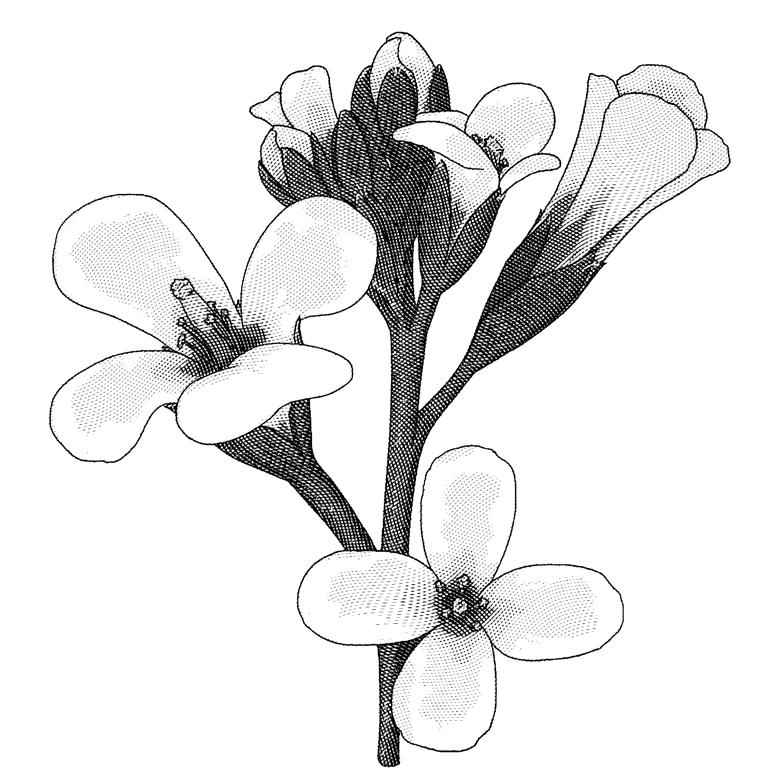
To quantify endogenous auxin and CK metabolite levels, the authors used ultra-sensitive Liquid chromatography–mass spectrometry/ mass spectrometry on 200,000 organelles of each population, and on the isolated vacuoles. All data were normalized based on the protein content of the organelle fractions, in pmol/µg of proteins, and isotope labelling of the hormones confirmed negligible metabolic turn-over of auxin and CK throughout the fractionation.
The authors found that all auxin-related metabolites were present in all organelles, but enriched in vacuoles (Figure 1C). IAA-amino acid conjugates, however, were only detected in vacuoles, suggesting transport into vacuoles. Cis-zeatin types, the most prevalent type of CK, exhibited a maximum in the vacuole, followed by high abundance in the ER (Figure 1C). CK O-glucosides were only detected in vacuoles, supporting the hypothesis that CK storage forms are located there. CK nucleotides were not detected in the vacuole, but in the chloroplasts, confirming previous studies that the biosynthesis of CK nucleotides by isopentenyl transferases occurs mainly in chloroplasts. CKs are known to promote chloroplast development, and accordingly, CK bases as active compounds were mostly detected there.
The intracellular distribution map of auxin and CK created by Skalický et al. facilitates a better understanding of their signalling, transport and metabolism. The FAmOS method should be applicable to different tissue types and organs, to mutant and overexpressing lines as well as to other plant species, and could be coupled with proteomics, metabolomics and transcriptomics. This will help to reveal organelle-specific processes and to analyse the function of phytohormone transporters. ⊲
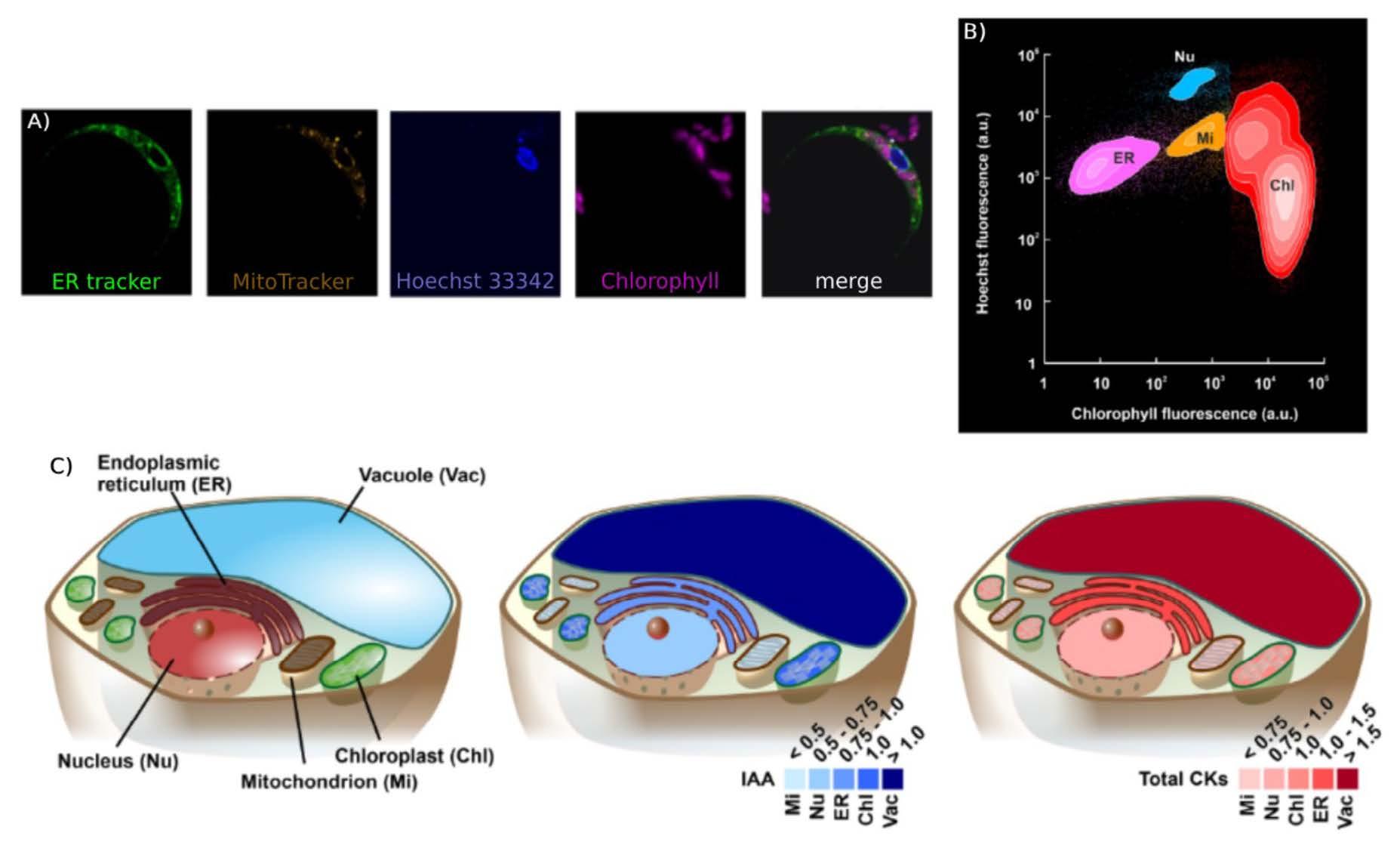
Figure 1: Mapping of auxin and cytokinin to the cell organelles by organelle sorting and ultra-sensitive mass spectrometry.
A) Cell organelles in Arabidopsis protoplasts visualised with markers; endoplasmic reticulum (ER, green), mitochondria (orange), nuclei (blue), chloroplasts (magenta).
B) Separation of organelle population after their identification; Chl = chloroplasts, Mi = mitochondria, Nu = nuclei.
C) Relative distribution of auxin (IAA) and total cytokinin (CK) metabolites between the analysed organelles.
SAFE RICE TO SAVE LIVES
JXB (Journal of Experimental Botnary)
BY MAREIKE JEZEK
Genetic engineering low-arsenic and low-cadmium rice grain By Yuejing Gui, Joanne Teo, Dongsheng Tian, Zhongchao Yin Journal of Experimental Botany, Volume 75, Issue 7, 27 March 2024, Pages 2143–2155, https://doi.org/10.1093/jxb/erad495
Rice is a staple food worldwide and eaten by billions of people on a daily basis. High levels of toxic arsenic and cadmium in the grain have raised severe concerns about its safety for human consumption. Gui et al. (2024) used genetic engineering to combat this problem.
Rice is a staple food worldwide and eaten by billions of people on a daily basis. High levels of toxic arsenic and cadmium in the grain have raised severe concerns about its safety for human consumption. Gui et al. (2024) used genetic engineering to combat this problem.
Rice is a staple food in major parts of the world. Especially in Asian countries, rice not only provides calories and nutrients to billions of people every day but is also an integral part of their culture. Traditionally celebrated as a symbol of life and fertility, the grain’s shiny image has suffered in recent years since it has been identified as the main food source of inorganic arsenic, a toxic trace element found in rocks and sediments around the globe. Arsenic is released into the environment as a by-product of mining activities and use of arsenic-containing pesticides. Chronic exposure
THE AUTHORS FOUND THAT ALL AUXINRELATED METABOLITES WERE PRESENT IN ALL ORGANELLES, BUT ENRICHED IN VACUOLES (FIGURE 1C).
increases the risk of various forms of cancer as well as pulmonary and cardiovascular diseases. Nowhere can the adverse effects of arsenic be better seen than in Bangladesh, where what started out as a national health program to save lives ended in the worst mass poisoning in history. Throughout the first half of the 20th century, cholera and other infectious diseases were a constant threat to the population that relied on polluted rivers and lakes as main water source. The 1970s saw massive efforts from the government and international aid agencies to supply the nation with “cleaner” groundwater by building thousands of wells across the country. Unbeknownst to all, the groundwater in Bangladesh is naturally high in arsenic, a slow killer that only reveals its grim face after years of constant exposure. Millions of people were, and still continue to be, slowly poisoned by drinking arsenic water and eating arsenic rice. Bangladesh has the highest rice consumption worldwide with over 250 kg per year per capita, the daily diet thus represents a significant route of arsenic exposure. The problem may be especially severe in Bangladesh but high arsenic levels in soils and consequently rice are also found in China, India, South East Asian countries, and parts of the United States, among others. No other crop accumulates as much of this metalloid as rice. The anaerobic conditions in the flooded paddy soils that rice is grown in make arsenic more available for uptake into the plant. Since the chemical properties of arsenic are similar to phosphate and silicon, for which rice has highly efficient uptake and transport systems, it accumulates to high concentrations in the grain. The problem is aggravated when contaminated water is used for rice field irrigation. Changing the farming practice to more aerobic soil conditions is impossible in many low-lying waterlogged areas, and also drastically increases the bioavailability and plant uptake of cadmium,
THE AUTHORS FOUND THAT ALL AUXINRELATED METABOLITES WERE PRESENT IN ALL ORGANELLES, BUT ENRICHED IN VACUOLES (FIGURE 1C).
another highly toxic element of major concern for food safety.
Gui et al. (2024) have approached this problem and genetically engineered rice with low concentrations of arsenic and cadmium in the grain. Within plant cells, both elements are stored in the vacuole, a membrane-bound organelle where toxic compounds are sequestered. Before being transported into the vacuole the metals are bound in the cytosol to small detoxifying molecules called phytochelatins to prevent their interference with metabolic processes. Gui et al. have generated rice overexpressing a phytochelatin-synthesizing enzyme and two transporters that facilitate arsenic and cadmium uptake into the vacuole. The plants accumulated increased levels of arsenic and cadmium in roots and nodes, the thickened joints along the stem at which leaves emerge, and significantly reduced allocation into the grain (Figure 1C). When grown in cadmium- and arseniccontaminated soil, the concentrations of the toxic elements in the grain were far below the current limits set by the World Health Organisation that are considered safe for consumption. Importantly, plant growth, reproduction, and agronomic traits such as panicle morphology, seed size and 100-grain weight were not negatively impacted by the gene overexpression (Figure 1A, B). The authors show convincingly that this could only be achieved by gene-stacking through the synergistic and additive effect of co-overexpressing several selected genes.
The work by Gui et al. is an impressive example of how biotechnology can be used to secure food safety. The team, with the support from Temasek Life Sciences Laboratory and Temasek Trust, is now aiming at commercialising the lowarsenic and low-cadmium rice to benefit both rice farmers and consumers, and the approach holds much potential to improve human health and save lives.
THE AUTHORS FOUND THAT ALL AUXINRELATED METABOLITES WERE PRESENT IN ALL ORGANELLES, BUT ENRICHED IN VACUOLES (FIGURE 1C).
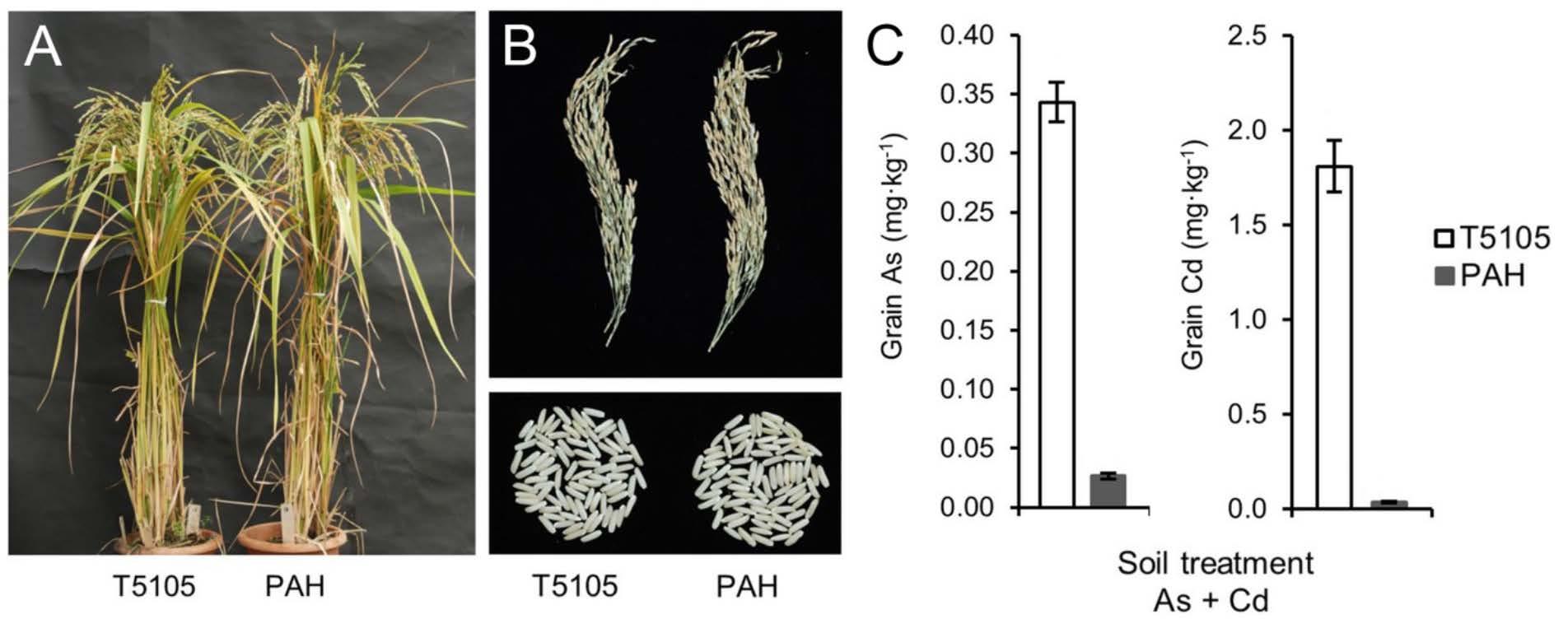
Figure 1: Gui et al. (2024) genetically engineered rice with improved cellular systems for detoxification of arsenic (As) and cadmium (Cd). Plant growth (A) and agronomic traits such as panicle morphology and seed size (B) were not different between the transformed plants (PAH) and wild type plants (T5105), but they accumulated significantly less toxic elements in the grain when grown in arsenic- and cadmium-contaminated soil (C).
IN SCOTLAND.
Bring your business event to a destination that fights against climate change, values thriving communities, embraces innovation and has sustainable development as a priority.
Enable global solutions with your business event in Scotland and join us on the journey to change.
To find out more visit: BusinessEvents.Scot


“I
love how innovation and discovery are driving scientific advances in direct response to user-inspired research and problems,” says Ross Sozzani, Chair of the SEB’s Cell Section and a professor in the Department of Plant and Microbial Biology at North Carolina State University, who is also working hard to grow new opportunities for the next generation of agricultural scientists.
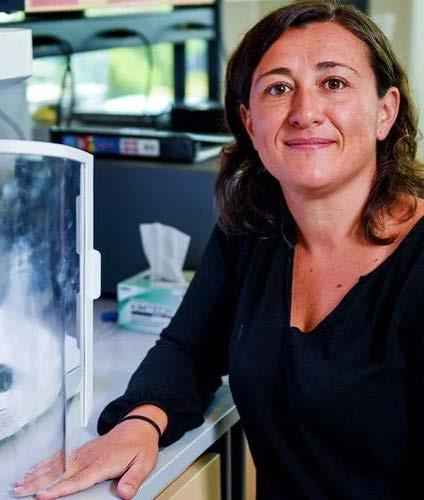
ALEX EVANS, IN CONVERSATION WITH...
ROSS SOZZANI
Hi Ross! What first got you interested in the cellular biology of plants?
I got my bachelor’s and my master’s degrees in Italy as a 5-year programme, with the last 2 years focusing on my main interest in molecular biology. I was really interested in the players of the cell cycle and the proteins that regulate gene expression. It was during my first internship that I got to discover plants, including the model plant, Arabidopsis thaliana, and I came to really love this species as a tractable system for asking complex questions. Through my postdoctoral training at Duke University, I was working again with Arabidopsis and fell even deeper in love with plant cell biology. Now, I’ve moved on from that model species, which is still my favorite, into crop plants so that everything we have learned from a cellular molecular aspect about plant cell biology can be translated into crops.
This sounds like a move into more applied science - I’m aware that you recently co-founded a bioscience startup company?
Yes, I co-founded Raleigh Biosciences together with Philip Benfey to achieve user-inspired research that addresses real problems and puts solutions into practice. I love learning from advances in animal science, and we have replicated certain aspects such as 3D bioprinting. Instead of 3D printing ink or plastic, we use ‘bioink,’ or living plant cells. Mimicking the natural environment helps keep cellular signals and cues occurring as they would in soil, so 3D bioprinting provides a better opportunity for high throughput processing and control over the architecture of the cells after bioprinting, such as layers or honeycomb shapes. This shows that 3D bioprinting can be useful to study cellular regeneration in crop plants.
With these potential applications for agriculture, what could 3D bioprinting bring to help safeguard against food insecurity?
That’s an excellent question, and that is related to my role in STEPS (the Science Technology for Prosper Sustainability and North Carolina Plant Science Initiative)1, where I am looking at phosphorus sustainability. Our vision is to reduce
the input of phosphorus into the environment, which we know can cause eutrophication and other downstream problems. We’re looking at how we can work together with other disciplines like material science and chemical engineering on new ways to recover phosphorus from the environment. For example, we can use 3D bioprinting as a highthroughput screening tool for different synthetic phosphate materials.
As well as your cellular research, you recently published an article in Plant Cell about the historical and ongoing under-representation of Black Americans and People of Colour within agricultural science, and a new network created to address this.
I lead on a National Science Foundation (NSF) program called AI2EAR (Accelerate Integration of Engineering and Agricultural Research)2, which is pronounced “eye-to-ear”. We have a fantastic director for broadening participation, Terry Long, and she surveyed interdisciplinary groups to identify and address any problems for inclusivity in science. We had a clear revelation that, in the space of STEM and especially in agriculture, there’s not an equal representation of gender or race, and so there is an interest in bringing in a more diverse group of people that will bring diverse perspectives with them. One way of doing this is to bring more digitalization into agriculture, and so AI2EAR is accelerating the integration of plant science and engineering in agriculture research through artificial intelligence. For example, for small and middle-sized farms, we can build AI applications for them that identify pests or pathogens and help tailor their approach to using fertilizer or pesticides.
You are now the new section chair for the sales section for the SEB, congratulations! What do you hope to achieve with this role?
I’m still listening and learning, and I recently had a fantastic conversation with the prior chair, David Evans. I was very impressed by his engagement with the Cell Section, but what I want now is to bring the Cell Section to the interface of the other two Sections. Since the cell is the fundamental unit of
Below:
Ross Sozzani
Photo credit:
Ross Sozzani

all organisms, we can elevate the Cell Section to be an even more interdisciplinary aspect of both the Plant and Animal Sections. Cell biology research is thriving right now, but there are challenges we can overcome that will also help to elevate the other Sections too - so that is what I would like to see over the next few years as Cell Section Chair.
If we put research to one side, what do you enjoy doing outside of the lab?
I always love to travel. I feel that to travel is to see and hear different cultures, different environments and different languages. I travel so that I can have new hands-on experiences and listen to other people’s perspectives. I’m fortunate that, for example, next week I will visit one of our university partners at the University of Florida, and I can take the time to really be immersed in their space and understand the problems that they face. Not only from a research perspective, but I will also learn about any of their education hurdles that I can help with.
What is one thing that you are really proud of achieving in your career so far?
MY CAREER HIGHLIGHT IS THAT I BRING PEOPLE TOGETHER
My career highlight is that I bring people together and I would say that I am a bit of a trailblazer in terms of collaborative efforts. I want to make sure my students and postdocs can easily move forward because they have learned how to collaborate, communicate, and respect other people’s perspectives. I’m proud of building the momentum for a lot of these new collaborations.
Thank you for talking with me, is there anything else that you would like to share with our readers?
Just that I still have to learn a lot as Cell Session Chair, so I will always ask for understanding and patience. I will certainly benefit from being in Prague and getting to know everyone in person because that’s really important. And since it lies on the 4th July, it’s a good excuse to be very immersed in the conference because nobody emails me - everyone is taking a holiday in the United States!
References:
1. STEPS Centre Website: https://steps-center.org
2. AI2EAR Project Website: https://www.ai2ear.org
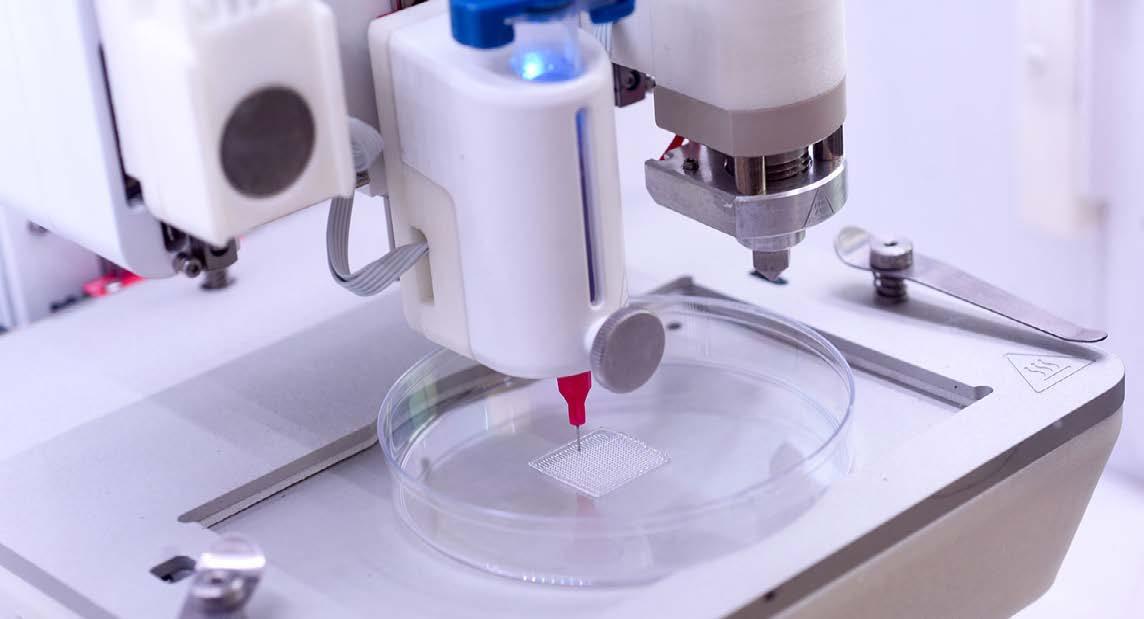
Photo credit: Ross Sozzani
WHAT I WANT NOW IS TO BRING THE CELL SECTION TO THE INTERFACE OF THE OTHER TWO SECTIONS
Below: The 3D bioprinters used to print plant cells.
Photo credit: Ross Sozzani
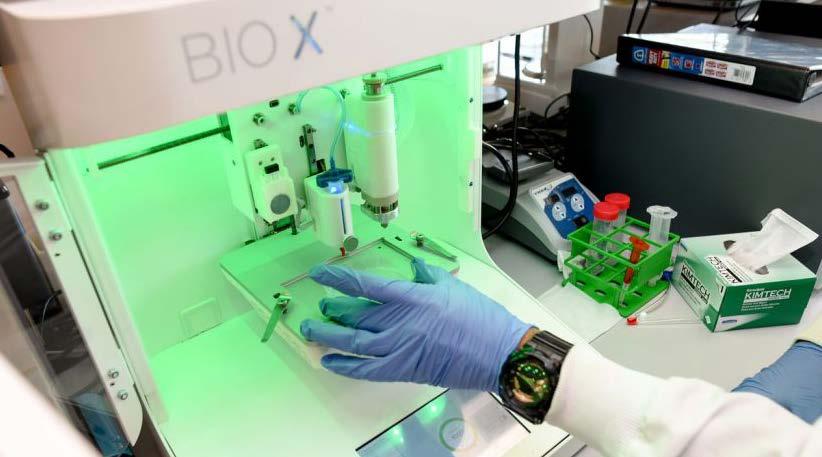
Left: Ross Sozzani at Raleigh Biosciences.
Below
George Bassel with a 3D digital reconstruction of the mature Arabidopsis embryo at cellular resolution, holding a 3D printed model of the same.
Photo credit:
Quincey Russell
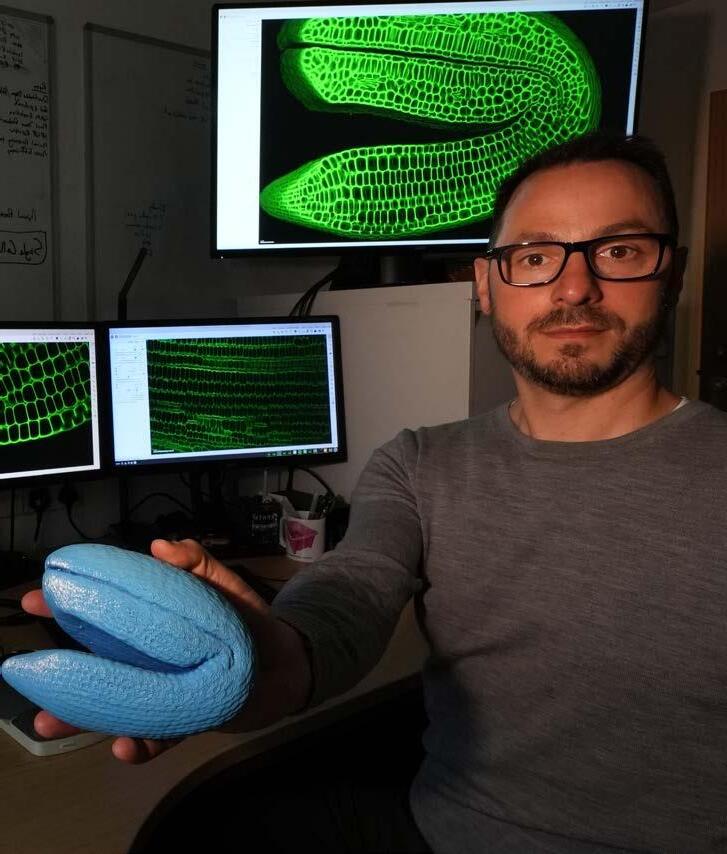
CAROLINE WODD, IN CONVERSATION WITH...
GEORGE BASSEL
How do you introduce yourself and your research?
I am a computational plant scientist based at the University of Warwick in the UK, and my research focuses on how plants process information from the environment to make decisions. I take an interdisciplinary and integrative approach towards this, bringing together molecular genetics, physiology, quantitative 3D image analysis, network science, and artificial intelligence (AI). The aim is to develop novel strategies to change the growth and form of plants, including applications for agriculture.
When did you first become interested in plant science?
About twenty-five years ago, as an undergraduate studying Biology at The University of Guelph in Canada, I had a lecture on the Malthusian Principle, which proved pivotal. I was struck by the tremendous difference between the rate at which food production was increasing relative to the growth of the human population. It was immediately apparent that this was a definitive issue of global significance, and therefore a good area for a biologist to focus on.
How did this lead to your PhD topic?
For my PhD, I worked on tomato and cloned its DELLA gene which regulates Gibberellic Acid signalling. At that time a lot of advances were being made in our understanding about the integration between hormone signalling, physiology, and molecular genetics. My thesis focused on elucidating how Gibberellic Acid promotes the breakdown of the endosperm in the seed to enable the growth of the embryo [1]. Around then, Nick Harberd at Oxford University demonstrated that DELLA genes were behind the dwarf wheat varieties that underpinned the ‘Green Revolution.’ So, these genes have a special place in agriculture.
What prompted you to start applying computational biology techniques?
I was drawn to studying complex processessuch as the transition between dormancy and
germination in seeds – and I realised that we needed more sophisticated processes in order to understand these fully. Experimental approaches tend to focus on establishing the activities of single genes, but these processes simply cannot be explained at such a reductionist level. There are so many additional layers of complexity, from the biomechanical processes that drive growth to the communication that occurs between cells. I was inspired to see how computational modelling and simulations could integrate these different aspects – for instance, in the work of Richard Smith and Enrico Cohen on plant morphogenesis at the John Innes Centre.
After you completed your PhD, you moved to the UK to join the University of Nottingham in 2009. What drew you here in particular?
I was awarded a Marie Curie Fellowship so took the opportunity to join the University of Nottingham with Michael Holdsworth and the Centre for Plant Integrative Biology (CPIB), which Malcolm Bennett had just established at Nottingham. It was an exciting moment for interdisciplinary plant science: for the first time, the Centre brought together people from very different disciplines to work on plant science problems. Being in that environment was a formative point in my training. I met many interesting people who expanded my horizons and introduced me to new ways of thinking.
In 2012, you moved to the University of Birmingham to start your own lab group. Here, you were awarded a grant for a research project called: ‘Do plant organs and computers process information in the same way?’ What was your motivation for this?
Much plant development research focuses at the molecular level, concentrating solely on genetics. If plants were single cells, then a gene-centric approach could explain the system. But most plants are multicellular, and communication between cells and organs results in emergent functions: there are higher order processes at play. For example, when a seed germinates or a plant flowers, no single cell is responsible - it is a collective decision across the multicellular community. However, we
lacked an effective way of investigating this. The project proposed viewing this problem through the lens of an analogy of looking at the architectures of supercomputers. These are not made of a single processor, but a distributed system of many different processors, all communicating with each other. So, in plants, cells represent individual information processors communicating outputs as mobile molecules communicated from cell-to-cell. Our hypothesis was that it is in the communication between cells that collective decision making takes place.
And how do you test this experimentally?
We created transgenic plants where cell-to-cell communication can be dynamically modulated and tested whether this impacts their ability to make collective decisions. So far, we have tested flowering time in Arabidopsis and the breaking of bud dormancy in hybrid aspen trees, both decisions that are regulated by temperature. I have continued this work since I moved to Warwick in 2019, and our findings indicate that impaired cell-cell communication does indeed mediate plant responses to the environment. This support our hypothesis that collective cellular decisionmaking mediates the integration of environmental signals into physiological responses in plants.
In 2019 you became a Fellow of the Alan Turing Institute, the UK’s national institute for data science and AI. How does this complement your work?
AI holds great promise for plant science, but a current major limiting factor is the creative use of these technologies; not so much ‘deep learning’ done by computers, but the ‘deep thinking’ done by humans. More fresh perspectives will help leverage the power of AI into beneficial agricultural applications. As the only plant scientist in the Institute (as far as I am aware!), I get to engage with many interesting people who are using AI in diverse domains, which exposes me to different ideas. Similarly, I enjoy attending the Annual Meetings of the SEB because it introduces me to areas outside my field of study. It is quite unusual for a single meeting to represent so many different scientific disciplines, and this mixing of minds makes for a fertile exchange of ideas.
Where do you see yourself in five years’ time?
I anticipate that I will still be working in the same area, although hopefully moving towards more practical applications. Recently, I have become very interested in enhancing the nutritional content and digestibility of plant-based protein. We absorb shockingly little of the protein content of many seeds, leaving huge scope for improvement.
You are a member of the scientific advisory board for the Food Standards Agency, part of the UK Government. Why do you think researchers should engage with policy makers? It is very important that policy decisions are rooted in scientific evidence, particularly when it
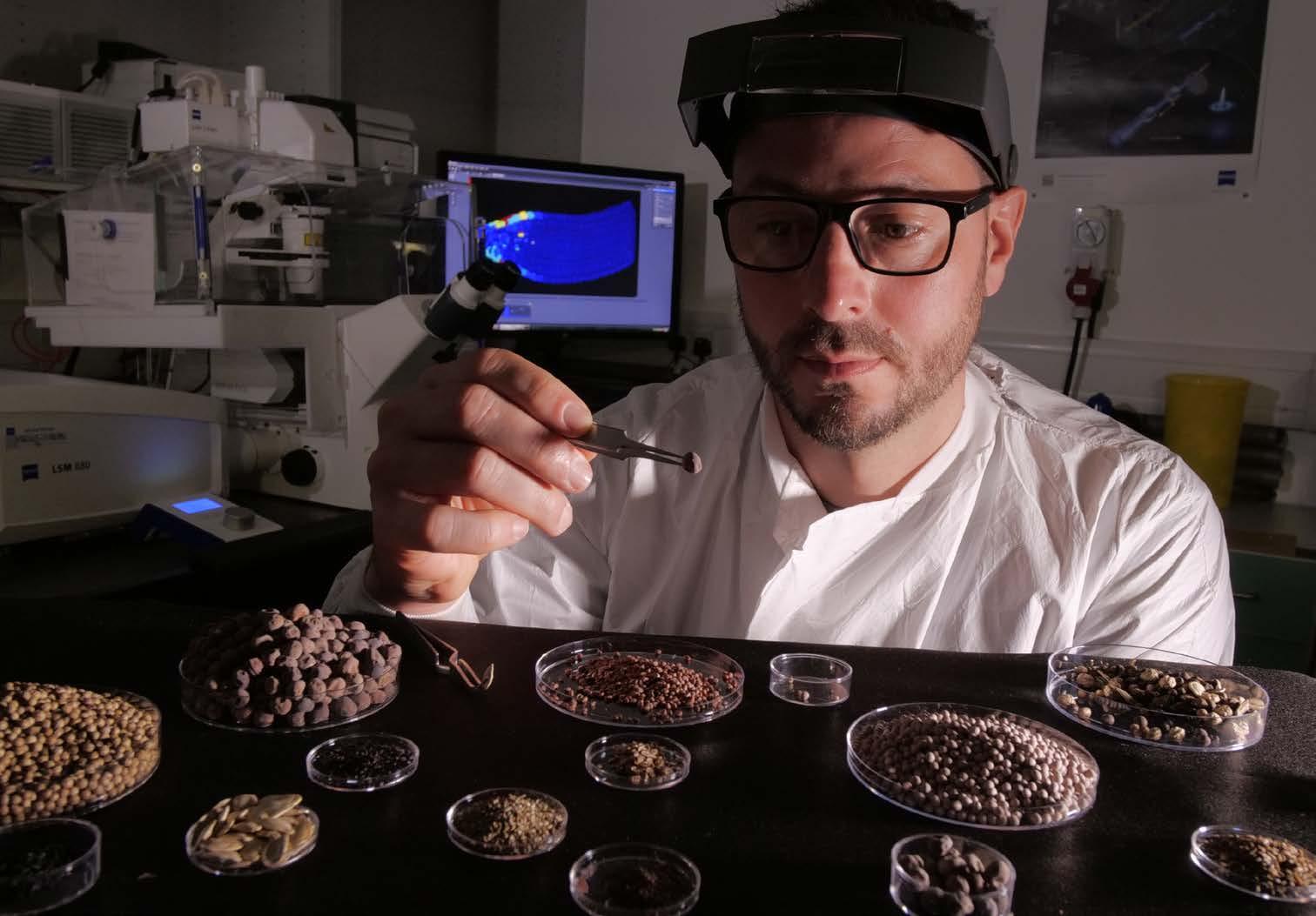
AI HOLDS GREAT PROMISE FOR PLANT SCIENCE, BUT A CURRENT MAJOR LIMITING FACTOR IS THE CREATIVE USE OF THESE TECHNOLOGIES; NOT SO MUCH ‘DEEP LEARNING’ DONE BY COMPUTERS, BUT THE ‘DEEP THINKING’ DONE BY HUMANS.
comes to regulation. For instance, I am currently advising on new policies about how future geneedited foods will be deemed safe for human consumption. Given there are people who are sceptical about novel foods, it is important that the science underlying these is properly understood and communicated. If these foods are ever to make a difference, they must be both legitimately safe and acceptable to the public.
What is the best advice that you have ever been given?
Make sure you are genuinely interested in what you do. When things get difficult (as they inevitably do in research), it will give you a source of strength. Of course, there are practical aspects to balance in a career – publishing papers, securing grants, etc – but the interest needs to be there, always.
What would your younger self think of what you do now?
I think he would be pleased to see that I had found a research niche that was contributing an alternative approach towards tackling the Malthusian Problem. A research life can be challenging at times, but being able to constantly experiment with new ideas and researchers gives me fresh energy, and is highly rewarding.
Above: George Bassel visually inspecting seeds. Photo credit: Quincey Russell
AMAR SURAPANENI SPOTLIGHT ON...
BY ALEX EVANS
The road towards experimental biology is never the same for any two researchers, and it is this diversity of experiences that makes our field so wonderfully rich. For Amar Surapaneni, a post-doctoral researcher at City University of Hong Kong, the road was full of surprises both great and small… very, very small.
y first career goal was actually to be a mechanical engineer,” he says, reminiscing about his first forays into the world of science. “I originally joined a software company and then worked as a research assistant at the Indian Institute of Technology in Bombay, but even then, I didn’t think of myself as a scientist.” However, it didn’t take long before some aspects of Amar’s work appealed to his sense of scientific curiosity and problem-solving. “I was testing an instrument that wasn’t working, and then I was able to make it work,” he says. “I had this Eureka moment and thought ‘ok, this is what I want, I want to be a scientist’.”
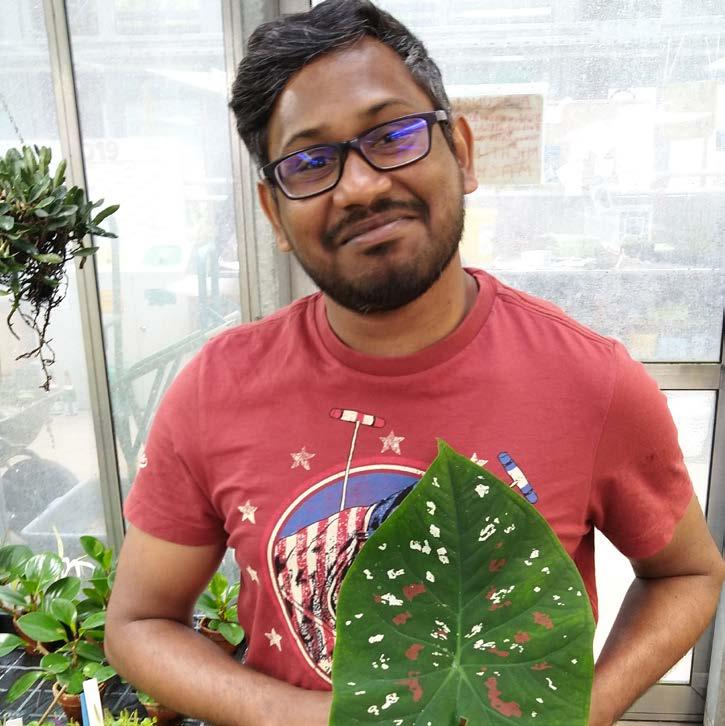
MAt the time, Amar was working on the mechanics of nanostructures, and he knew that this was the area of research that really captured his attention, resulting in him pursuing a Master’s degree in nanotechnology. While conducting a project on nanofluids for computers, his professor introduced him to another project that was based on bioinspired materials. “That shifted everything and I became fascinated about small-scale structures in nature,” he adds. Amar had originally planned to stay in India, but after seeing the Marie Curie fellowship with an opportunity to research abroad, he decided to give it a go and eventually secured funding for a PhD project with Thomas Speck’s plant biomechanics group at the University of Freiburg, Germany, working on plant-insect interactions. Most recently, he has been working at the City University of Hong Kong on the biomechanics of basking sharks and stingrays. “That’s been my journey so far,” he says. “It’s not a straight path but I’m really loving what I’m doing right now.”
Although still early into his research career, Amar has a relatively unique experience of specialising in both plants and animals, providing him with interesting comparative insights. “Both have their own unique characteristic features - the biomechanics of animals are a lot more wellstudied because they have to move around their environment,” he says. “Plant biomechanics are naturally less studied but are also really interesting because they don’t move, so they come up with interesting solutions to compensate.” Amar’s research is heavily driven by curiosity; finding the answer to nature’s mysteries remains at the core of all his investigations. Some of his most recent
research has focused on the structural coloration of the enigmatic bluespotted ribbontail rays, which possess incredible blue patterns on their skin that researchers believe to be a form of visual warning to potential predators. “These rays are a very interesting model because they have these very bright electric blue spots that appear blue from all angles, unlike other structural colours,” he says. Naturally-occurring blue pigments are rare in the animal kingdom, and many instances of blue colouration in nature are actually the result of structural, rather than chemical, colouration –such as those seen in peacock feathers. “My PI, Dr Mason Dean, asked if I wanted to find out what sort of structure produced these spots and I said yes!”
Amar’s investigation revealed a new cell type containing photonic glass (an array of tiny spherical particles that are able to scatter light in versatile ways) that was responsible for creating this fantastic colour1. While similar examples of naturallyoccurring photonic glasses have been found in other animals such as birds, this is the first time that it has been discovered in sharks and rays. “This photonic glass is made of small spheres that contain nanometre-scale crystals in a unique arrangement that produces colours,” he explains. “This structure and the spacing between the crystals reflect only this electric blue colour, which produces these striking bright structurally-coloured spots on their back that do not change with the angle of observation!”
In order to carry out his super-small-scale investigations, Amar relies on a suite of microscopy equipment to identify the different structures and mechanics at play in his biological samples, with Scanning Electron Microscopy (SEM) and Microcomputed Tomography (microCT) becoming vital tools in his arsenal. “The main issue with using such high-resolution techniques is sample preparation,” he says. “For looking at such small structures, you need to be very careful, but one of the nicest instruments I’ve used in the confocal laser scanning microscope which did not need a lot of sample preparation, just put a leaf cutting under the microscope and you get hundreds of nanometres of resolution!” Although a lot of Amar’s work takes place in his lab, he does still find time to get out and about, having just returned from a lab trip to Taiwan. “Fieldwork is really beneficial
Photo credit: Amar Surapaneni.
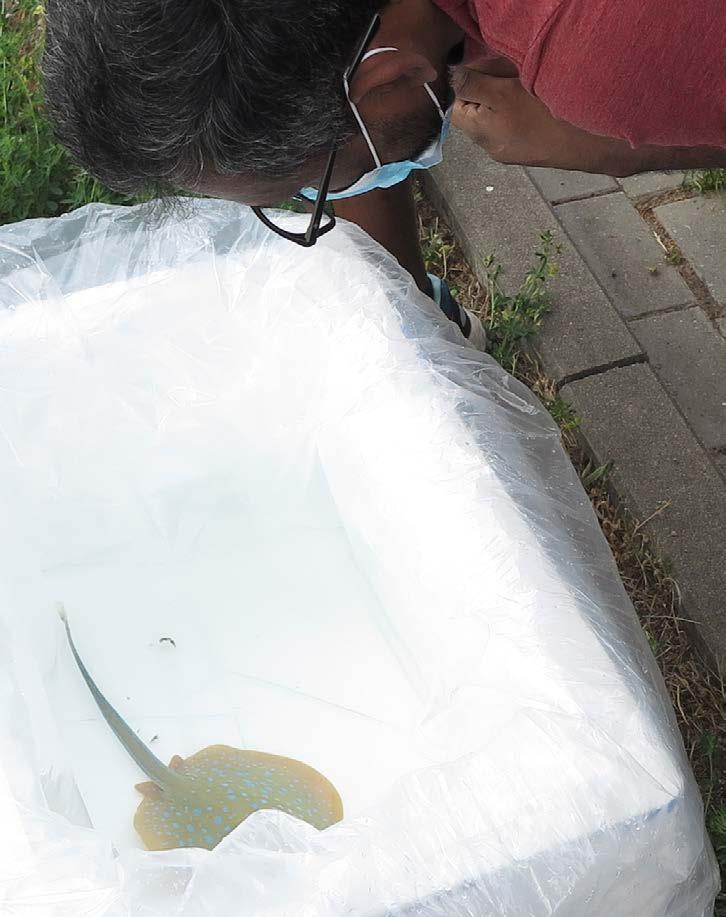
because there are some things you can’t really do just in the lab,” he says. “If I was a mechanical engineer working in a lab, then yes, it could mostly be done in a lab – but nature is so complicated, you need to go and see it in the wild.”
As with many other areas of material science, Amar’s interest in small-scale structures has interesting applications to real-world human problems. Agricultural practices have historically looked towards chemical solutions to deal with issues of pests and soil contents, resulting in effective-but-destructive fertilisers and pesticides. However, Amar believes that nature may be able to provide more mechanical solutions. “A lot of work has been happening in sustainable agriculture, such as plant-insect interactions,” he says. “I looked at the differences in how insects, such as crop pests, walk on young or adult leaves showed how plants can create wrinkly surfaces that make it more difficult for insects to walk on, which in turn could provide agricultural benefits, as well as possible adaptations for bio-inspired materials. As well as agriculture, bio-inspired structural colour solutions, such as those seen in the ribbontail rays, can also have more recreational uses – especially when it comes to celebrations.
“Soon it will be Holi in India, which is a huge festival that uses a lot of colours everywhere,” he explains. “If we could learn from nature and create safe structural-colour materials, manipulate their physics instead of their chemistry, it would show how important that biological inspiration can be.”
Amar’s research career has taken him across Asia and Europe, engaging in exciting collaborations with other researchers from universities, and garnering him features in Scientific American and Advanced Science News magazines and even an invitation to the Lindau Nobel Laureate meetingbut he’s not immune from experiencing culture shock whenever he lands somewhere new.
“It really changes your perspective, not just scientifically but also culturally,” he says. “Some University cultures are
Left: Amar and a ribbontail ray.
Photo credit: Amar Surapaneni
Right: Amar and his study species on the blackboard.
Photo credit: Amar Surapaneni
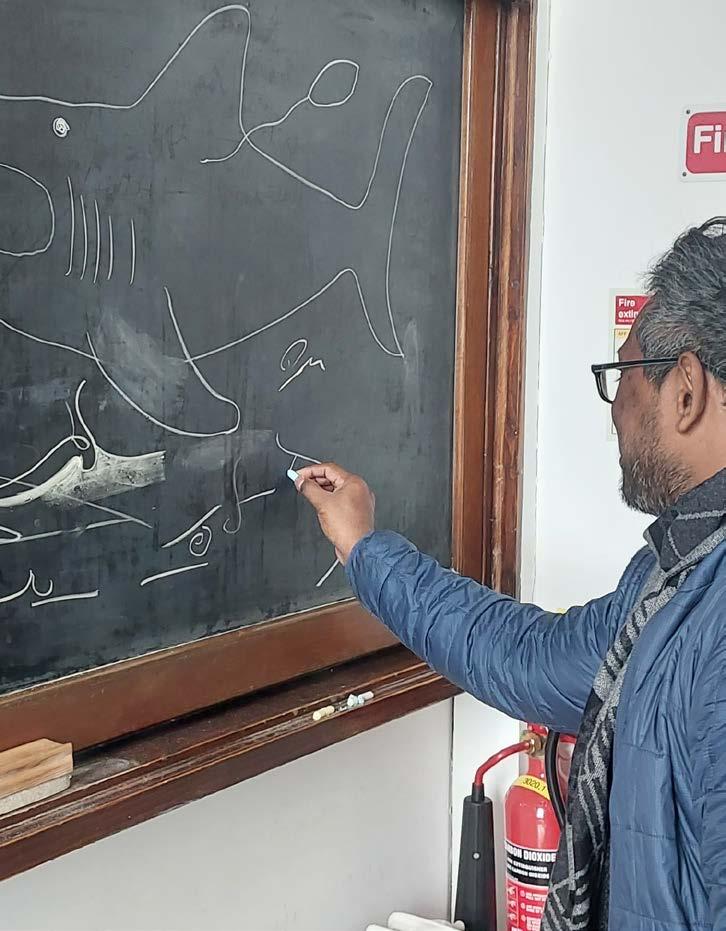
very competitive and focused on the application of research, while others will be mostly curiosityfocused - I think it’s really beneficial to explore all types.” Thankfully, Amar enjoys getting to see new parts of the world and making the most of his voyages abroad. “Usually, I’m a workaholic kind of guy, but I do love travelling and looking
I BECAME FASCINATED ABOUT SMALL-SCALE STRUCTURES IN NATURE
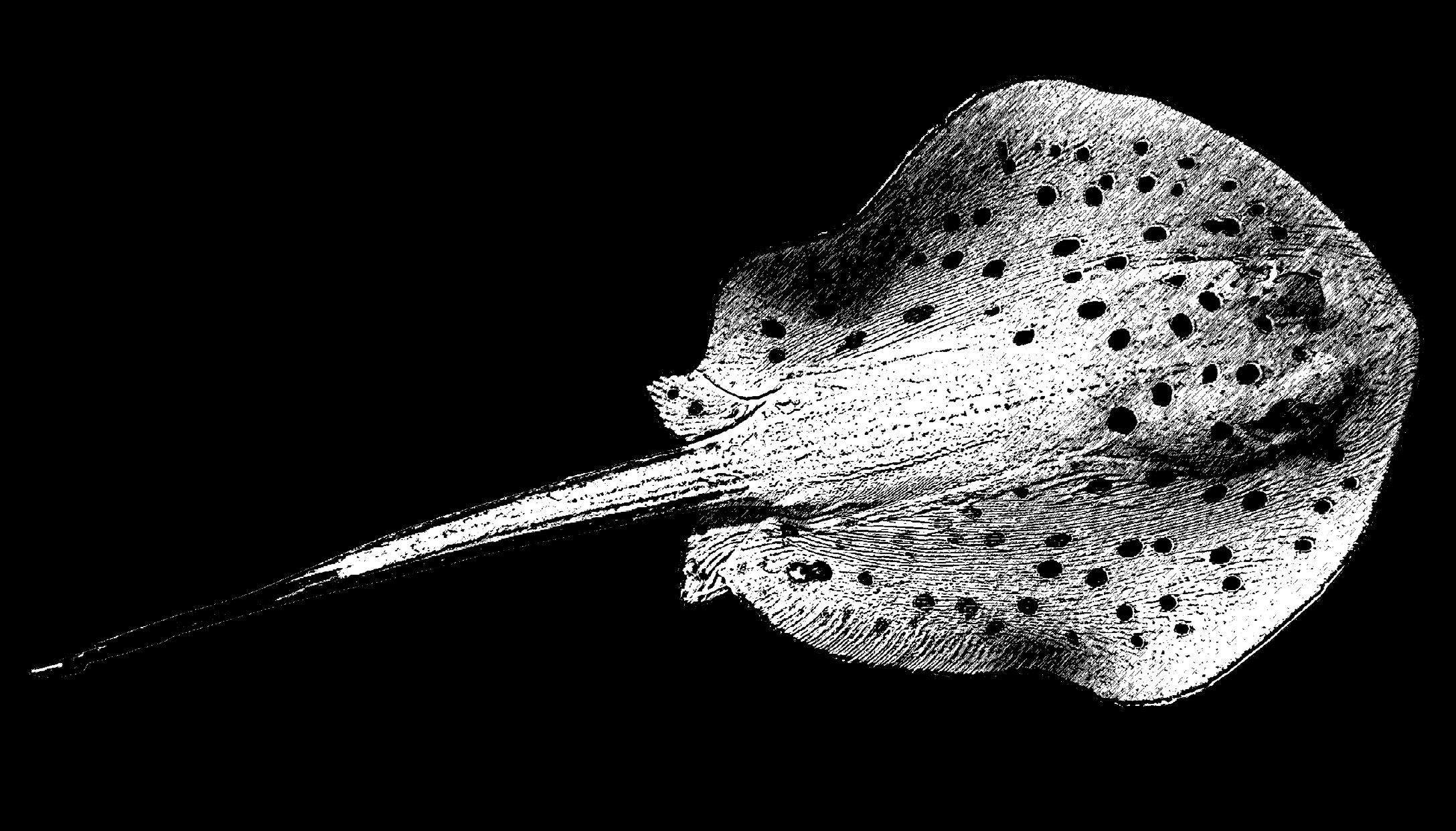
In a parallel universe somewhere, Tsu-Wei Chen is not a professor but instead a classical musician performing to packed-out concert halls across the world.
SUSANA CLUSELLA-TRULLAS SPOTLIGHT ON...
BY CAROLINE WOOD
If a tapestry were made of Professor Susana Clusella-Trullas’s career to date, it would be a very colourful one indeed, since ‘diversity’ is probably the best word to describe her work. Indeed, her research focuses on variety itself - specifically the physiological, behavioural, and morphological variation of ectotherms (particularly lizards and insects), and how this variation mediates these organisms’ responses to environmental change. Being based at Stellenbosch University’s School for Climate Studies and Department of Botany and Zoology in South Africa, she says, gives her access to the perfect ‘living laboratory’ to explore these questions. “The southern tip of Africa is such an amazing hotspot for both plant and animal diversity. There are so many different native habitats in close proximity – including mountains and ocean – it makes field work a dream!”
impacts the thermal landscape and available food resources for native wildlife6.”
Probing the diversity of life seems a natural career for one who was drawn to the outdoors and wildlife from an early age. “I had a very untraditional childhood in that I was born in Barcelona in Spain, but grew up in Abidjan in Côte d’Ivoire” says Susana. “So, I was surrounded by very tropical environments, and was drawn to the diversity of insects, plants, and wildlife all around. As a child, I wanted to be a wildlife vet but after finishing high school I went to the University of Perpignan in France to study Biology.”
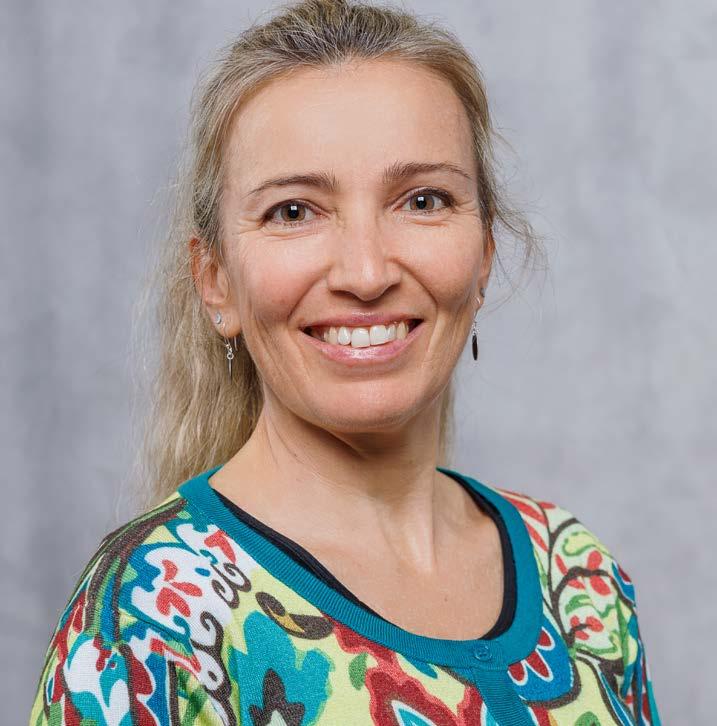
At her Climate & Invasions: Mechanisms in Ectotherms lab1, Susana’s team combines experiments, fieldwork, and theoretical models to understand how animals function in their environments, and how ecological and evolutionary processes shape their responses. Her areas of investigation are almost as broad as the range of species that she studies. Notable publications have included studies on thermal tolerance patterns across latitude and elevation2; the evolution of insect body colour under changing climates3; how environmental temperature alters digestive energetics in lizards4; and whether temperature exposures during larval stages have effects on performance at the adult stage in harlequin ladybirds5. These might seem disparate topics, however, as Susana says, they are all united in that they build knowledge that can ultimately improve our predictions of how sensitive species are to global environmental change.
Increasingly, her team are exploring the synergistic effects of climate change and other stresses with the aim of better understanding the direct and indirect impacts that result from these interactions. “Given the multidimensional nature of global change, we need to move beyond investigating single facets of contemporary climate change. A particular focus for our group is the interaction between climate change and species invasions –for instance, how the arrival of exotic plants
After graduating, Susana volunteered with a project working with olive ridley sea turtles in Costa Rica – an experience which first made her seriously consider a long-term career in research. “I found it absolutely fascinating, particularly the data analysis aspect. The project had collected data from thousands of different turtles over the years, and much of it hadn’t been looked at in depth, so I was really keen to dig into it and see what new insights we could get. I even ended up presenting some of our findings at a scientific conference.” Such was her enthusiasm, Susana undertook a Master’s degree working on the same turtle population, under the supervision of Professor Frank Paladino (Purdue University).
“My thesis topic was to develop quantitative measures of how much energy sea turtle hatchlings use to free themselves from the egg, then crawl to the surface and across the beach to reach the sea. We used methods that were very innovative for the time: for instance, injecting hatchlings with double-labelled water then estimating metabolic rates from the turnover of isotopes7 For someone who hadn’t really done physiological research before, it was a steep learning curve!”
Despite the challenging nature of the work, Susana realised she had found her niche. After a year and a half of sea turtle conservation work with the North Carolina Wildlife Commission, she moved to Philadelphia to complete her PhD with Professor James Spotila (Drexel University).
“At this point, I knew physiology was for me but I wanted to branch out to study other species. So, I switched to work on cordylid lizards, a very
Photo credit: Stellenbosch University.
diverse family of spiny lizards in South Africa that look like little dragons.”
It was at this point that climate change became her principal area of interest. “Cordylids demonstrate huge variation, with different body sizes, skin colours and properties. Our idea was to explore how these differences impact the body temperature of cordylids, and whether we can predict how they will respond to different future climate scenarios.” One key finding, she says, was that cordylids are able to effectively use the heterogeneity of their environment to regulate their body temperature and buffer temperature extremes8. “Being rock dwellers, cordylids can access a wide variety of different thermal zones, from warm exposed rock to cool, deep crevices. So, behavioural thermoregulation will likely be an important strategy to enable cordylids to cope with future climate change.”
On completing her PhD, Susana continued the research theme in a series of post-doctoral placements at Stellenbosch University, before launching her current lab group in 2012. Throughout that time, her scope has steadily increased to embrace other lizard families, various insect taxa and even velvet worms. “I like working on small invertebrates” she explains. “You can control conditions more precisely and they typically have a faster generation time than vertebrates, which is helpful for short-term student projects. However, I’m not adverse to the odd outlier!” In 2017, for instance, her expertise in energetics led to an invitation to join an international project investigating whether seabirds navigate oceans using infrasound (low frequency sound inaudible to humans). “It was really fun to work on something totally different and very multidisciplinary, involving mathematicians, physiologists, and physicists. Our modelling showed that, in theory, larger seabirds such as albatrosses may indeed use infrasound to complement their navigational decisions9.”
What with leading a lab group, teaching responsibilities, and publishing, Susana admits that life can feel a little too busy at times, but she finds the overall combination a rewarding one. “Perhaps the best part of my job is seeing my students develop, and become proficient researchers themselves. For instance, I teach a course on data analysis for second year undergraduates that is quite challenging and intense, and the students often struggle with it at the time. But by the fourth year, they have the foundation to make their own interpretations from data, which is really fulfilling to see. They’ll often say ‘At the time, we didn’t understand why we had to do all of those painful statistics, but now we know why!’”
Even so, Susana makes sure to carve out time for herself, her husband (also an academic), and two young girls to escape into the great outdoors, where her love of animals first began. “As I tell
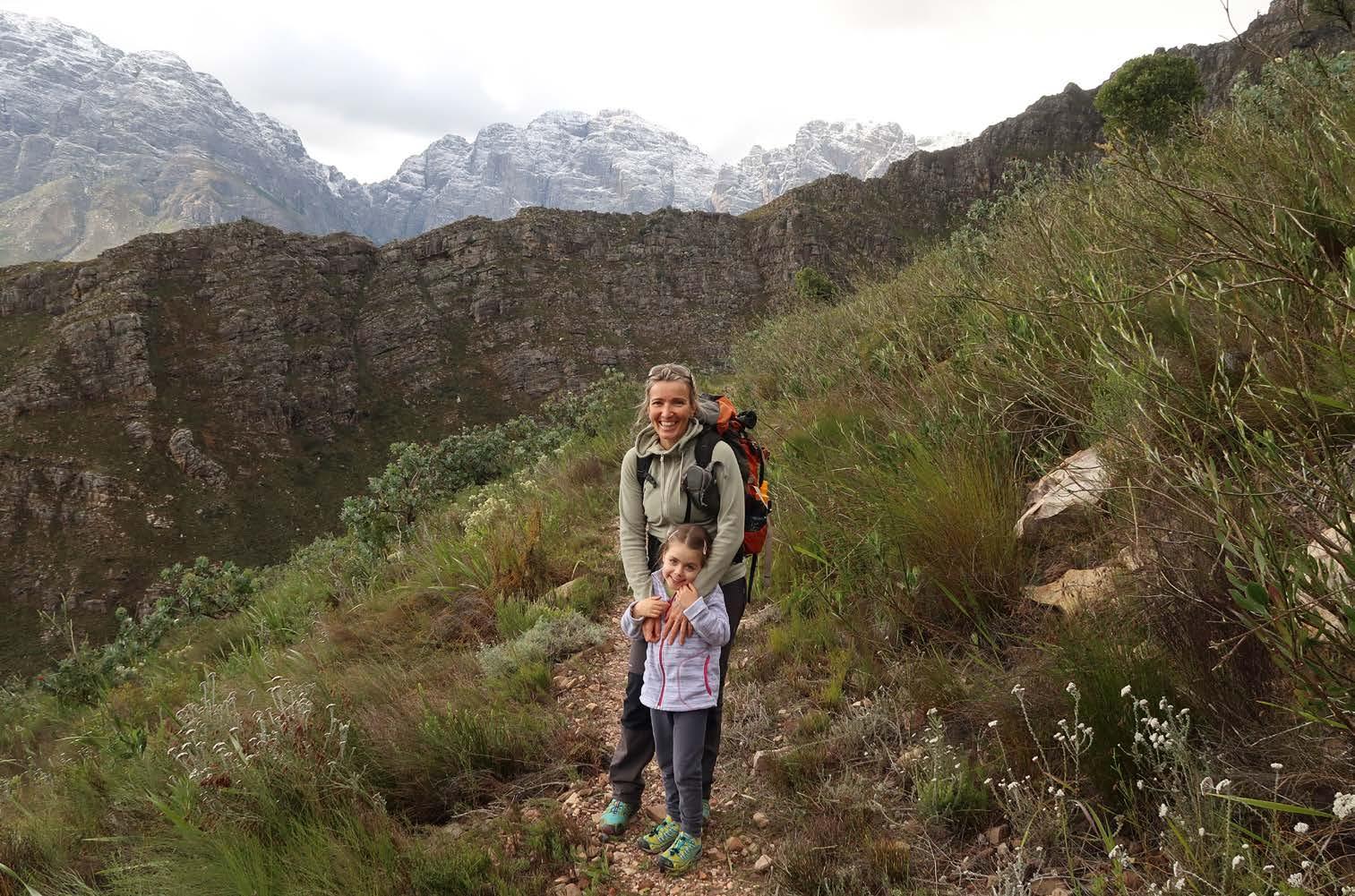
THE SOUTHERN TIP OF AFRICA IS SUCH AN AMAZING HOTSPOT FOR BOTH PLANT AND ANIMAL DIVERSITY. THERE ARE SO MANY DIFFERENT NATIVE HABITATS IN CLOSE PROXIMITY IT MAKES FIELD WORK A DREAM!”
my students, it is so important to keep a good balance in life. There can be such a rush to produce manuscripts and meet tight deadlines that it is easy to lose the time and space to be creative, read papers, brainstorm, and have some fun. Wherever I go, I’ll always find myself watching out for lizards!”
Above: Susana in her ‘campus backyard’: the Jonkershoek nature reserve, which allows her to study the unique species found in the plant-rich Fynbos vegetation.
Photo credit: Susana Clusella-Trullas
References:
1. ht tps://climelab.net/
2. Sunday, J., Bennett, J.M., Calosi, P., Clusella-Trullas, S., Gravel, S., Hargreaves, A.L., Leiva, F.P., Verberk, W.C., Olalla-Tárraga, M.Á. and Morales-Castilla, I., 2019. Thermal tolerance patterns across latitude and elevation. Philosophical Transactions of the Royal Society B, 374(1778), p.20190036.
3. Clusella-Trullas, S. and Nielsen, M., 2020. The evolution of insect body coloration under changing climates. Current Opinion in Insect Science, 41, pp.25-32.
4. Plasman, M., McCue, M.D., Reynoso, V.H., Terblanche, J.S. and Clusella-Trullas, S., 2019. Environmental temperature alters the overall digestive energetics and differentially affects dietary protein and lipid use in a lizard. Journal of Experimental Biology,222(6), p.jeb194480.
5. Shinner, R., Terblanche, J.S. and Clusella-Trullas, S., 2020. Across-stage consequences of thermal stress have traitspecific effects and limited fitness costs in the harlequin ladybird, Harmonia axyridis. Evolutionary Ecology, 34(4), pp.555-572.
6. Garcia, R.A. and Clusella-Trullas, S., 2019. Thermal landscape change as a driver of ectotherm responses to plant invasions. Proceedings of the Royal Society B, 286(1905), p.20191020.
7. Clusella-Trullas, S., Spotila, J.R. and Paladino, F.V., 2006. Energetics during hatchling dispersal of the olive ridley turtle Lepidochelys olivacea using doubly labelled water. Physiological and Biochemical Zoology,79(2), pp.389399.
8. ClusellaTrullas, S., Wyk, J.H. and Spotila, J.R., 2009. Thermal benefits of melanism in cordylid lizards: a theoretical and field test. Ecology, 90(8), pp.2297-2312.
9. Gillies, N., Martín López, L.M., den Ouden, O.F., Assink, J.D., Basille, M., Clay, T.A., ClusellaTrullas, S., Joo, R., Weimerskirch, H., Zampolli, M. and Zeyl, J.N., 2023. Albatross movement suggests sensitivity to infrasound cues at sea. Proceedings of the National Academy of Sciences, 120(42), p.e2218679120.
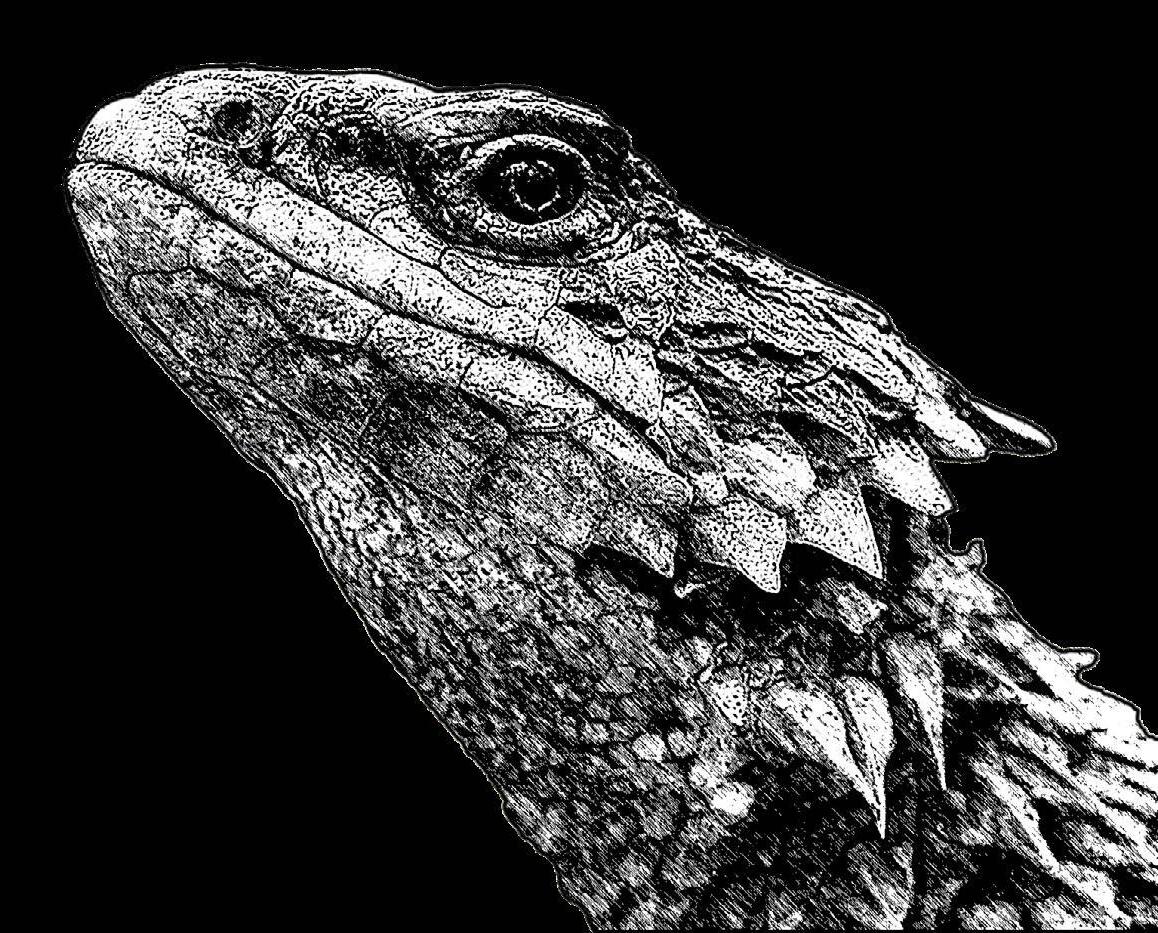
OUTREACH EDUCATION AND DIVERSITY
CENTENARY INFOGRAPHIC
SEB IN THE NEWS: A GLOBAL SHOWCASE OF SCIENTIFIC IMPACT
PROACTIVE SWIMMER IN THE SCIENCE SEA
SUPPORTING BIOSCIENCE RESEARCHERS IN HIGHER EDUCATION TEACHING: THE IMPORTANCE OF EDUCATIONAL RESEARCH GRANTS
STUDENT RESEARCH FEATURE: COMMUNICATING RESEARCH TO POLICY MAKERS- WHAT WORKS BEST?
CHAMPIONING SCIENCE: EMPOWERING EARLY CAREER RESEARCHERS




CENTENARY YEAR REVIEW
LEADERS OF THE FUTURE WEBINARS
Spotlighted mid-career researchers exhibiting exceptional respective fields. Featuring past SEB award winners, platform for awardees to delve into their research, career pivotal role SEB experiences and awards played in shaping
scientists of all career stages joined the conference making it the largest meeting in SEB history!
CAREERS AND COFFEE WEBINARS
200+ Non-members
148 Early careers 18 Awarded memberships
EVENTS:
Public Engagement Event
Wine and Wisdom quiz
Science Themed Walking Tour
Royal Society of Edinburgh
Lecture Evening
Press
342 Full members 291 Student members
Paul Nurse Keynote Talk
Lunch
Integrity Workshop
400 media appearances across 35 countries, showcasing the centenary conference and SEB member’s
Free webinar sessions offering career insights for biologists to transition away from acadmia. Title
A career in academic publishing
Page Careers in Technology Transfer
Moving to careers in Environmental Sciences and the Civil Service | Careers and Coffee (March)
Shruthi Krishnamurthy
Marcelo Paes
How mentoring/coaching changed my scientific career Damaris A. Odeny
From academia to industry. Let the industry surprise you!
Tatiana Paredes
Careers in marine consultancy and research Laura Williamson
A career in science comms & outreach
A career in science management – at the interface between science and administration Céline Hönl
Transversal Skills in Experimental Biology: from academia to project management and policymaking
Supported 10 members across the globe.
74
Javier Santos
REVIEW
trajectories, and
their journeys.
JOURNAL INITIATIVES
Scientists with Impact: An interview series showcasing inspirational researchers.
JXB Centenary Reviews: How plant science is addressing global challenges.
Conservation Physiology: Special 10-year anniversary edition celebrating their own milestone.
Science with Impact: Article collections highlighting SEB journal’s most impactful research throughout history.
ROYAL BOTANIC
BIRTHDAY CARD
217
messages from well-wishers sharing their SEB memories in our birthday card and guest book.
WIKIPEDIA EDITATHON
Training event resulted in significant Wikipedia contributions: 52 new or expanded articles
75,000 views of these articles.
HISTORY ARTICLES & VIDEO
smiley face stickers on our feedback sheets from children who took part in our plant-themed crafts and games.”
AWARDS NOMINATION TASK FORCE
New Awards Task Force aimed to diversify nominees for SEB awards. 20 members submitted 9 nominations. Half of SEB’s 2024 award winners were nominated by the task force.
GRANTS
people a total of:
£45,000
41 participants from 20 countries. Set to continue as a permanent feature in 2025, bringing lasting benefits
100,000
More than 100,000 impressions across social media platforms from both SEB and SciAni social media pages amplifying the Society’s visibility globaly.
12 history articles published showcasing findings from the SEB archives.
Attendees at centenary dinner gifted a ‘Celebrating 100 Years of SEB’ book.
FIELD TECHNIQUES WORKSHOP
Hands on event for environmental physiologists and experimental botanists, attracting 95 participants. 27 new or renewed SEB members.
SEB IN THE NEWS: A GLOBAL SHOWCASE OF SCIENTIFIC IMPACT
TSecuring media attention for scientific research is increasingly vital for raising awareness of its importance and impact. Engaging with the media not only boosts citations and research impact among fellow researchers but also facilitates dissemination to the public and policymakers, serving as a crucial channel for informing taxpayers and funders about the research they support financially. This contributes to increased funding, fosters positive public perceptions of research, and helps attract individuals to the industry. Recognising the significance of media coverage for our members, the SEB supported our members in sharing their research globally through various media platforms across our centenary year.
Throughout 2023, the SEB and our members made headlines across the globe, with over 400 appearances in news articles, TV segments, radio features, podcasts and various other forms of media. Spanning 35 countries, this extensive coverage underscored the universal appeal and relevance of experimental biology. It wasn’t just about academic recognition, it was about sparking conversations, challenging perceptions and inspiring action.
To enhance our members’ media engagement, we stationed a press officer at our centenary conference and issued press releases covering the research presented. We also established a press room, facilitating impromptu interviews and televised appearances for SEB members to share their insights globally in real time. This exemplified our commitment to fostering dialogue and engagement beyond academia’s confines and is something we will bring forward for future events.
These initiatives acted as catalysts, sparking interest among journalists and the public alike,

whether by shedding light on the threat posed by vineyard fungicides or by showcasing the resilience of pollinators aided by omega-3 oil. The SEB’s work transcends borders and language barriers, captivating audiences globally, from India Today to CNN Turkey, from The Times UK to El País Spain. The geographical spread of media coverage reflects the universal relevance of SEB members’ work. In the USA, where cutting-edge technology and extreme heatwaves dominated headlines, press releases on drone technology and heat stress resonated deeply. Notably, mainstream networks like Sky News and NBC featured the SEB’s work prominently, reflecting the widespread interest in these topics. Similarly, in central Europe, where vineyard industries are integral to the economy, research into the impact of fungicides on wild birds garnered significant attention, shining a spotlight on the environmental implications of agricultural practices.
Central to the SEB’s media outreach efforts was Alex Evans, who served as the SEB Press Officer at our Centenary Conference. His dedication and expertise ensured that the SEB’s research received the attention it deserved on the global stage. We are delighted that Alex will be joining us again for our Prague Conference this year. Looking ahead, the SEB remains committed to amplifying the voices of its members, offering support and guidance to those seeking to share their work with the world.
As we reflect on the media attention throughout 2023, one thing is clear: the impact of experimental biology research extends far beyond the laboratory walls. By harnessing the power of media and embracing collaboration, the SEB and its members have sparked conversations, challenged perceptions and inspired action on a global scale and will continue to do so into 2024.
Do you have work that you’d like us to create a press release for? Contact r.ellerington@sebiology. org to amplify your research impact! Our team will craft a press release to showcase your work to the world. Plus, as a SEB member benefit, you can access personalised 1:1 advice before your first media appearance. Don’t miss out—get in touch today to maximise your research’s reach and influence.
Explore some of the SEB media highlights throughout 2023, spanning news articles, podcasts, radio interviews and television appearances :
● India Today (India) How Hot is Too Hot for the Human Body to Function?
● Nutrition Insight (the Netherlands) Bees’ Knees: Immune-Boosting Omega-3 Oil Helps Pollinators Recover from Pesticide Poisoning
● AZO Life Sciences (Australia) Triazoles: A Threat to Wild Birds
● IFLScience (UK) Primate Clitorises Come in More Shapes and Sizes Than We Ever Imagined
● El Pais (Spain) Cuánto calor es demasiado: así reacciona nuestro cuerpo a las temperaturas extremas
● CBC Radio Active (Canada) Is Sunscreen Dangerous for Aquatic Life?
● The Times (UK) How 3D Images Can Put Injured Horses Back in the Saddle
● Zenger News (USA) Giant Six-Legged Robotic Fly Developed to Make AI Learning Quicker
● Sky News (UK) How Hot is Too Hot for the Human Body to Function? Study Reveals How We Respond to Heat Stress
● Scientias (the Netherlands) Wonderlijk maar waar: Omega-3 beschermt bijen tegen landbouwgif
OED SYMPOSIUM
EMPOWERING RESEARCH FOR COMMUNITY IMPACT
10-11 SEPTEMBER 2024
IMPERIAL COLLEGE
LONDON SW7 2BX
SEBIOLOGY.ORG #SEBOED24

EMPOWERING RESEARCH FOR COMMUNITY IMPACT
ABSTRACT SUBMISSION DEADLINE: 22/07/2024
REGISTRATION DEADLINE: 19/08/2024

PROACTIVE SWIMMER IN THE SCIENCE SEA
BY ANA CAROLINE COLOMBO AND REBECCA ELLERINGTON
When navigating the tumultuous sea of science research and academia, students may find themselves engulfed by crashing waves of information, tasks and decisions. Many are still learning how to swim in such a turbulent sea. Without guidance or a community, the chances of drowning in the overwhelming waters become very real. On top of this, peer pressure can increase the challenges and, perhaps worse, the pressure we impose on ourselves. Science is about experimentation, discussing ideas and exploring hypotheses. Yet, instead of embracing the journey of discovery, why do we so often fixate on achieving flawless results with the perfect methodology or unique pathways?
Recognising the need to provide support to those swimming and show the next generation that this scientific sea is for everyone, the SEB dived into outreach initiatives aimed at extending a helping hand to aspiring scientists. In the past few months, the SEB has participated in distinct events to disseminate science and opportunities, from career fairs in the UK, to delivering talks to undergraduates and postgraduates in Brazil, to science festivals open to the public.
Among the opportunities and activities shared in these events was a career guide showing the multiple pathways to a career in biology and how to get started, including a list of ideas to help school students and undergraduates gain experience in the field, such as options to engage with science communication, citizen science and STEM programmes and initiatives. Engaging with these extracurricular opportunities offers invaluable hands-on experience and a chance for students to discover if the reality of their chosen interest
lives up to the expectation. Scientific communities, such as learned societies (an official scientific community), can play a major role in professional development and the internationalisation of science, as highlighted in a university talk given by our own Ana Colombo. With a focus on opportunities and networking, these communities can offer a liferaft to those learning to swim in the science sea.
As well as supporting students at the start of their scientific careers, the SEB also sought to captivate the next generation of budding scientists by providing engaging activities tailored to children and families, involving thermal camera functionality and how microorganisms influence the taste of chocolate. Visitors were invited to actively engage with the task and think about what would happen – simulating a scientist’s quest.
Although the SEB activities and talks provide guidance and inspiration, they ultimately require action from the participants, either to engage in the activities or to use the information provided to help gain experience and in networking. Being proactive in science is key. Not to flood the metaphor, but while proactive undergraduates and postgraduates will still have to swim through the crashing waves, they can at least anticipate what is coming and pack their buoyancy aids!
Standing up for science and making our presence known in communities where scientific discourse
may not be mainstream serves a dual purpose. On one hand, it helps individuals outside of scientific circles or at an earlier stage of their scientific career to understand the significance of our work and why science is vital in addressing realworld challenges. On the other hand, engaging in outreach efforts allows us, as scientists, to learn from participants. They offer fresh perspectives that can broaden our understanding of our own research and its potential impact. Although it might sound contradictory and daunting for an overwhelmed swimmer to go out into unknown waters, undergraduates and postgraduates can, by actively participating in outreach, gain confidence, discover a new community and learn lessons from those outside of the scientific community. They may even get a fresh perspective and reignite their love of their chosen subject or reorient their way back into science. For those who want to test the waters or are confident to dive in, the SEB offers opportunities such as outreach grants and career events, as well as opportunities to volunteer at SEB outreach events like festivals.
By embracing unique approaches and seeking assistance and support as needed, we empower ourselves to engage with science on our own terms. After all, the journey of scientific exploration is diverse and multifaceted, and no singular pathway or format guarantees success. It’s about finding your own way and making meaningful contributions to the ever-evolving scientific landscape.
SUPPORTING BIOSCIENCE RESEARCHERS IN HIGHER EDUCATION TEACHING: THE IMPORTANCE OF EDUCATIONAL RESEARCH GRANTS
In the realm of higher education, bioscience researchers often find themselves transitioning into teachingfocused roles. Whether on teachingonly contracts or those that combine teaching and scholarship, these academics play a crucial role in shaping the next generation of experimental biologists. However, they face unique challenges, including limited job security and insufficient institutional support for career development.
Recent statistics from the Higher Education Statistics Agency (HESA) reveal that teaching-focused academics represent around 25% of all academic staff, with a significant proportion employed on part-time or fixed-term contracts, including zero-hours contracts. This situation underscores the need for greater support and recognition for individuals undertaking teaching responsibilities within the biosciences.
Recognising these challenges, the SEB has launched an Educational Research and Development Grant aimed specifically at supporting educators and academics involved in teaching within higher education. The grant seeks to empower these individuals to advance their understanding of teaching and learning while fostering innovation in pedagogy.
One of the primary objectives of the grant is to enable recipients to demonstrate evidence of innovation in teaching and their ability to secure external funding for educational research projects. This support is particularly critical given the current underfunding of initiatives focused on effective teaching at higher education levels. By providing financial assistance and training opportunities, the grant aims to enhance the quality of education for future experimental biologists through evidencebased learning approaches.
Eligibility for the grant is open to SEB members and any member of the science community involved in teaching in higher education. Applicants must have a minimum one-year employment contract with teaching responsibilities or a guaranteed one-year
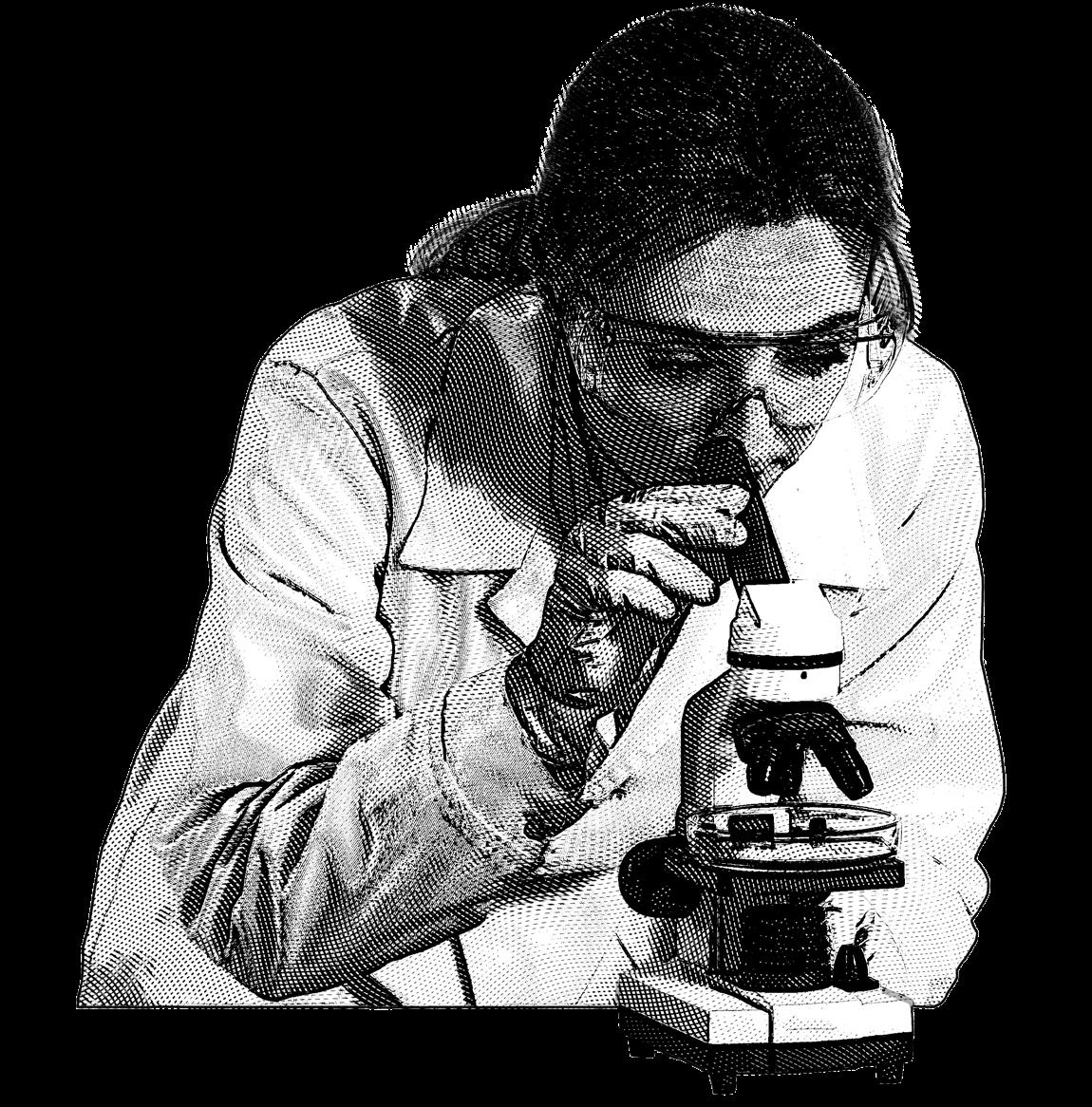
source of funding in a teaching-focused capacity. Importantly, the grant is available worldwide, reflecting the SEB’s commitment to supporting educational research on a global scale.
Successful applicants can receive grants of up to £2000 for SEB members and £200 for nonmembers. Projects eligible for funding include those focused on improving learning, teaching and assessment in experimental biology, as well as the development and dissemination of openaccess teaching resources for higher education.
Collaborative initiatives involving partnerships between institutions are encouraged, because they have the potential to broaden the impact and reach of educational projects. A notable example of successful collaboration in bioscience education is the partnership between scientists of the Microscopy Society of America and educators at the Lawrence Hall of Science. This collaboration resulted in the development of an outreach programme known as Microscopic Explorations, a publication that has been widely embraced by teachers for over 15 years. Such initiatives highlight the value of collaboration in enhancing bioscience education. The SEB aims to foster a community of biology higher education educators through this grant programme, facilitating peer networking and professional development opportunities.
Moreover, grant recipients have access to additional support, including training sessions on topics such as designing survey questionnaires and analysing quantitative education research data. These resources aim to equip educators with the necessary skills to conduct rigorous educational research and contribute to the advancement of teaching practices in the biosciences.
SUCCESSFUL
APPLICANTS CAN RECEIVE GRANTS OF UP TO £2000 FOR SEB MEMBERS AND £200 FOR NON-MEMBERS.
Supporting bioscience researchers who take on teaching-focused roles is vital for the advancement of education in experimental biology. Through initiatives like our new Educational Research and Development Grant, the SEB is paving the way for innovation and excellence in teaching, ultimately benefiting both educators and students alike.
For further reading on the challenges and opportunities faced by teaching-focused academics in the biosciences and valuable insights strategies for successful collaboration in higher education institutions, please refer to the following resources:
References: Hubbard K, Gretton S, Jones K, et al. Challenges and opportunities for early-career teaching-focused academics in the biosciences. F1000Research 2015; 4: 76.
Pelaez N, Anderson TR, Gardner SM, et al. A community-building framework for collaborative research coordination across the education and biology research disciplines. CBE Life Sciences Education 2018; 17: es2.
Abdulrahman AI-Y, Zahed AHM, Tierney WG (eds.). Successful Global Collaborations in Higher Education Institutions. Retrieved from https://library.oapen.org/bitstream/id/28ca1c77-64fe49c0-a248-2aa263306f6f/1007305.pdf
Jensen-Ryan D, Murren CJ, Rutter MT, et al. Advancing science while training undergraduates: recommendations from a collaborative biology research network. CBE Life Sciences Education 2020; 19: es13.
COMMUNICATING RESEARCH TO POLICYMAKERS: WHAT WORKS BEST?
BY CAROLINE WOOD
deally, new policies and legislation should be informed by the most relevant, up-to-date research evidence. But with the majority of policymakers lacking a scientific background, we can’t assume that research developments relevant to topical issues will naturally come to their attention. This makes it essential that researchers actively engage with policymakers; however, this typically has to be fitted in around a wealth of other responsibilities, from experimental work and teaching, to publishing papers and grant writing. So, when time and resources are limited—meaning that you can’t simply try every possible approach to reach policymakers—where should you focus your energies? A social media strategy? Direct correspondence with Members of Parliament (MPs)? Engaging with Parliamentary services? Or something else entirely?
But even when evidence reaches policymakers, key messages can be lost if it is not tailored to the audience’s needs. Policymakers typically have excessive demands on their time and attention, so information that does not appear useful risks being discarded. So how should information be presented to avoid this from happening?
My recent research project, ‘Communicating evidence to policymakers: what works best?’ set out to explore these questions in depth, and to develop a ‘best practice guide’ for communicating evidence to policymakers, based on how they actually find and use information. With funding from the Chartered Institute of Public Relations Research Fund, I questioned over 130 UK policymakers in a variety of different roles using a combination of one-to-one interviews and an online survey. My aim

was to establish how policymakers generally find and use evidence, what features made evidencebased information most useful to them, and what barriers limited their ability to find useful information. The findings were published earlier this year; here are a few of the highlights.
VISIBILITY AND TRADITIONAL MEDIA
HAVE A ROLE IN POLICY ENGAGEMENT
Internet searchers are by far the dominant information source for policymakers, with 79% of survey respondents saying they used Google ‘nearly always’ or ‘often’ when searching for evidence-based information. Other popular sources include reports from think-tanks, nongovernmental organisations (NGOs), learned societies and campaign groups; mainstream media and news outlets; and Parliamentary services, such as the House of Lords and House of Commons Libraries. Therefore, issuing press releases, publishing articles on websites and providing comments to the media can all count towards policy engagement.
Get to the point—executive summaries are a must! Policymakers are typically both highly timepressured and constantly bombarded with information from all directions. It is essential that information aimed at policy audiences is concise and easy to read, with the key points upfront and the relevance immediately clear. Use
executive summaries, a clear layout and informative headings so that your key messages and essential points can be located instantly.
MAKE SURE THE POLICY RELEVANCE IS CLEAR
One of the biggest challenges for policymakers is that information is frequently sent to them with no explanation as to why it is relevant to their area of policy. As one respondent put it, weighty reports that just landed on his desk with no context ‘just get thrown onto the pile and discarded’. This makes it critical to invest the time to ensure information is tailored to policymakers’ concerns, rather than simply directing them to an academic paper or regurgitating information published for other audiences. Explain upfront or include a cover note to say why the subject is timely and relevant to current policy developments.
UNDERSTAND THAT (YOUR) EVIDENCE IS JUST ONE PART OF THE PICTURE
For policymakers, it is very important that information considers the broader context surrounding an issue, and that it acknowledges the trade-offs associated with different courses of action. Consequently, if you are making specific recommendations, these should be framed within a
realistic assessment of the wider context, including economic, social and political impacts.
Bear in mind also that policymakers are often seeking to understand the degree of consensus about a particular issue. This makes it important to explain how individual publications (particularly of new research findings) relate to the wider evidence base.
ACCESSIBILITY IS ALL
Accessibility is the most common barrier for policymakers when it comes to finding and using evidence-based information. This includes information being hidden behind a paywall, not having access to the data underlying the information and not knowing how to locate information produced by specific groups. Parliamentary and local Government services do not typically pay for subscriptions to non-open access academic journals, so if your work is not published elsewhere, they are unlikely to come across it. Make sure that your information is accessible by removing paywalls, including downloadable PDF versions and republishing academic information on highprofile public platforms (such as The Conversation).
But accessibility also extends to the underlying evidence and data. Despite the need for information to be concise, policymakers generally appreciate the ability to do a ‘deep dive’ into the primary data if needed. This means that the most useful sources of information include links to underlying (open access) data, references, links to additional sources of information and details of the methods used.
HAVE A BROAD FOCUS
Targeting information only at MPs, Peers (Members of the House of Lords) and senior Civil Servants can restrict your impact. The high demands on these groups means that they typically have little time to find and review evidence themselves, causing them to rely on their teams to collate information for them. This makes it critical to engage with the wider networks that feed them information, including Select Committees, Government Department staff and Parliamentary Research Services.
THERE IS A HIGH DEMAND TO ENGAGE WITH EXPERTS DIRECTLY
further information and clarification. This means that proactively including contact details and offering opportunities for engagement (such as briefing events and roundtable discussions) can make your work stand out.
Policymakers particularly value having the ability to contact the authors of evidence to ask for
IF I AM READING A REPORT, IT’S IN THE GAPS BETWEEN MEETINGS, LATE AT NIGHT ON MY TABLET OR WHILE TRAVELLING. I NEED TO BE ABLE TO SKIM AND GET TO THE BITS I AM INTERESTED IN.
Curiously, the survey revealed that there is an overwhelming desire among policymakers to receive more information specifically from universities and academics. When asked ‘Are there groups you would like to receive more evidence-based information from than you do at present?’, ‘Universities’ was by far the most common response. This indicates that universities are seen as a credible source of information by policymakers, but they aren’t overly visible.
This is just a snapshot of the findings, and I would encourage anyone with an interest in policy engagement to read the full report, which also includes a series of illuminating case studies: https://cipr.co.uk/CIPR/CIPR/Our_work/Policy/ Research_fund_reports.aspx
You can find real-life examples of researchers who have effectively engaged with policymakers on the website of the Oxford Policy Engagement Network: https://www.ox.ac.uk/research/usingresearch-engage/policy-engagement/oxfordpolicy-engagement-network-OPEN
With thanks to the Chartered Institute of Public Relations for funding this work.
UNDERSTAND THAT SCIENTIFIC EVIDENCE AND FACTS ARE NOT ENOUGH TO SWAY A POLITICIAN’S OPINION.

CHAMPIONING SCIENCE: EMPOWERING EARLY CAREER RESEARCHERS
BY CAMILLA ARVIDSSON, PROGRAMMES OFFICER, SENSE ABOUT SCIENCE
Standing up for science can be extremely daunting. Polarised debates across a range of issues from gene editing to vaccine safety and GM foods to human-made climate change mean that researchers can often be wary of putting their heads above the parapet to defend science. Scepticism, misinformation and social media pile-ons also mean researchers, and especially those at the start of their careers, don’t feel equipped to take on these debates. And yet if scientists are not out in the public sphere, responding to the public’s questions and concerns, and championing one of our most reliable sources of knowledge, we risk further misunderstanding and misinformation spreading through society.
This is why, for the last 20 years, Sense about Science has run the Voice of Young Science (VoYS) programme, which provides training and resources to early career researchers (ECRs) keen to take responsibility for the public discussion around science and research. We believe that investing at the early stage of researchers’ careers is a way of improving the long-term culture around research towards openness and transparency in the longer term.
Through VoYS, ECRs have the opportunity to hear from researchers further along in their careers about their experiences, good and bad, of working with the media and policy worlds. They learn from journalists and policy professionals about how their worlds work and what they need from scientists to operate effectively. They are able to share their worries and concerns with their peers and receive tools and insights on tricky areas where the public conversation can go wrong or be incredibly polarised. Ultimately, VoYS aims to inspire researchers to understand why it is so important that they stand up for science, and to
build up their confidence and skills to have public conversations about science and evidence.
We are grateful for SEB’s longstanding support for our VoYS programme and their commitment to building a community of researchers inspired and motivated to take responsibility for the public conversation around science and evidence. As a VoYS partner, SEB members have the opportunity to get a priority place at one of our free ‘Standing Up for Science’ workshops that are held across the UK and online. Our workshops cover policymaking in the UK as well as the EU (twice a year), so check out our full programme for dates and content details. You can already sign up for our next workshop, which will be online on 12 July, as well as join our VoYS network and receive our monthly resources and updates on exciting opportunities.

Left:
Researcher panel at our Standing Up for Science (SUfS) workshop in Leiden, the Netherlands, October 2023
Bottom Left:
Early career researchers in discussion at our Standing Up for Science (SUfS) workshop at University of Glasgow, November 2023
Bottom Right:
Networking opportunities at our Standing Up for Science (SUfS) workshop in Norwich Research Park, May 2023
Join the network at; https://senseaboutscience.org/voys/
View our workshop programme at: https://senseaboutscience.org/voys/ workshops/
Apply for your free workshop place at: https://senseaboutscience.org/voys/ workshops/






Register your interest
Register your interest
biologists.com/100-years/conference #biologists100
biologists.com/100-years/conference #biologists100 Register your interest
Register your interest
biologists.com/100-years/conference #biologists100
Incorporating
Incorporating
Incorporating
biologists.com/100-years/conference #biologists100
Keynote speakers
Keynote speakers
•BSCB/BSDB Spring Meeting
•BSCB/BSDB Spring Meeting
•BSCB/BSDB Spring Meeting
Incorporating
Climate change and biodiversity:
•JEB Symposium: Sensory Perception in a Changing World
•JEB Symposium: Sensory Perception in a Changing World
•JEB Symposium: Sensory Perception in a Changing World
Incorporating
•DMM programme: Antimicrobial Resistance
Keynote speakers
•DMM programme: Antimicrobial Resistance
•BSCB/BSDB Spring Meeting
•DMM programme: Antimicrobial Resistance
•BSCB/BSDB Spring Meeting
•JEB Symposium: Sensory Perception in a Changing World
•DMM programme: Antimicrobial Resistance
•Special plenary sessions covering issues of global importance to the biological community
Climate change and biodiversity: Hans-Otto Pörtner and Jane Francis
Climate change and biodiversity: Hans-Otto Pörtner and Jane Francis
Hans-Otto Pörtner and Jane Francis
•Special plenary sessions covering issues of global importance to the biological community Keynote speakers
Keynote speakers
Health and disease:
Climate change and biodiversity: Hans-Otto Pörtner and Jane Francis
•Special plenary sessions covering issues of global importance to the biological community
•JEB Symposium: Sensory Perception in a Changing World
Health and disease: Sadaf Farooqi and Charles Swanton
Health and disease: Sadaf Farooqi and Charles Swanton
Climate change and biodiversity:
Sadaf Farooqi and Charles Swanton
•DMM programme: Antimicrobial Resistance
•Special plenary sessions covering issues of global importance to the biological community
Health and disease: Sadaf Farooqi and Charles Swanton
•Special plenary sessions covering issues of global importance to the biological community
Hans-Otto Pörtner and Jane Francis
Emerging technologies: Manu Prakash and Jennifer Lippincott-Schwartz
Emerging technologies: Manu Prakash and Jennifer Lippincott-Schwartz
Emerging technologies: Manu Prakash and Jennifer Lippincott-Schwartz
Health and disease: Sadaf Farooqi and Charles Swanton
Emerging technologies: Manu Prakash and Jennifer Lippincott-Schwartz
Emerging technologies: Manu Prakash and Jennifer Lippincott-Schwartz

SEB MEMBERSHIP
70% OF MEMBERS LEARN ABOUT SEB THROUGH WORD OF MOUTH
SEBIOLOGY.ORG #SEBPACK
JOIN THE PACK

MAKE EXTRAORDINARY CONNECTIONS NETWORK AND BUILD RELATIONSHIPS WITH EXPERIMENTAL BIOLOGISTS FROM AROUND THE WORLD
THINK BIG TAKE PART IN CROSSDISCIPLINARY CONFERENCES AND SHARE INNOVATIVE AND INSPIRING DATA, IDEAS AND RESULTS

DO MORE APPLY FOR GRANTS AND SPONSORSHIP TO INCREASE YOUR OPPORTUNITIES
FAST TRACK YOUR CAREER
ACCESS JOURNALS, EDUCATION AND TRAINING SUPPORT
